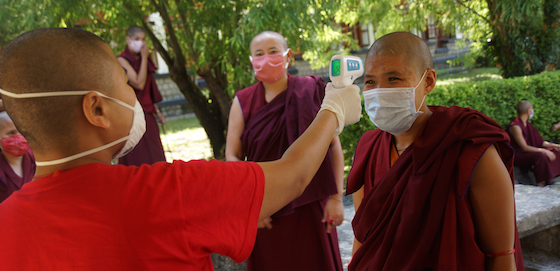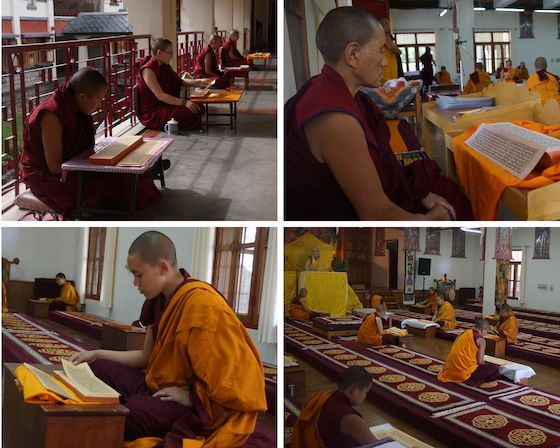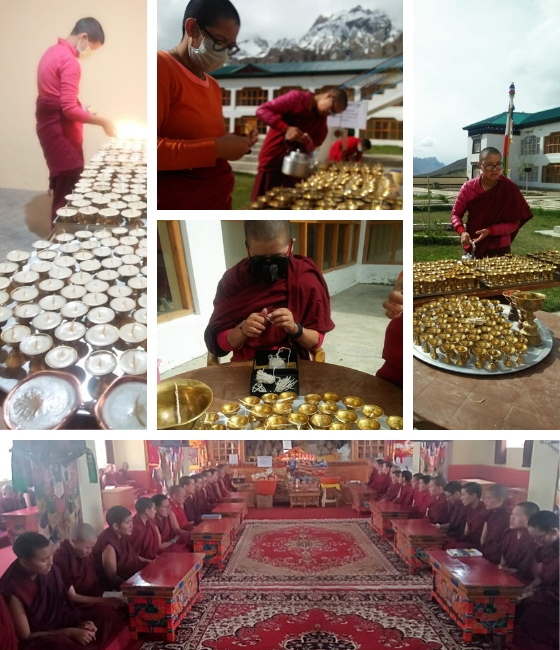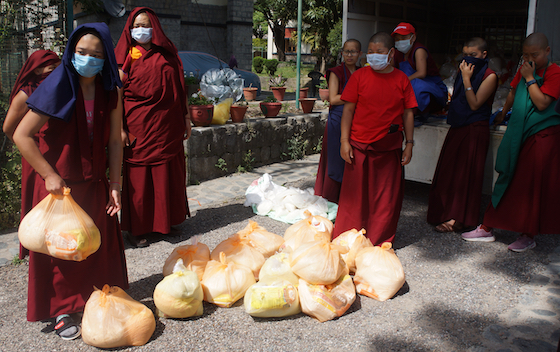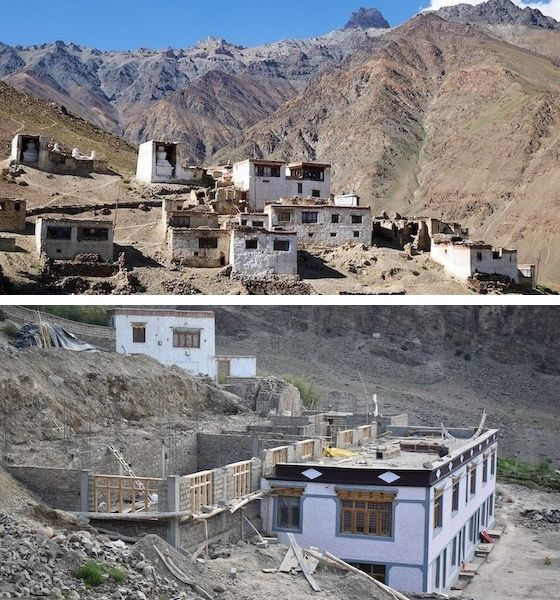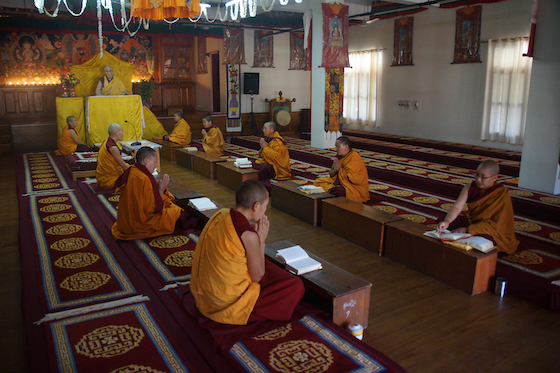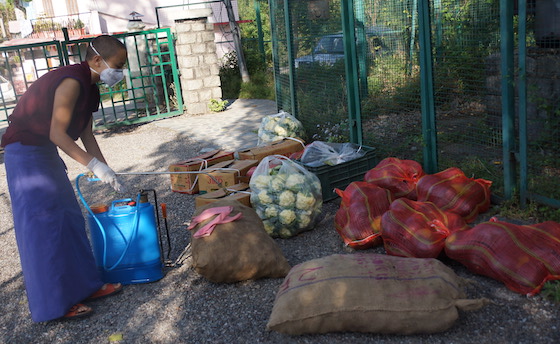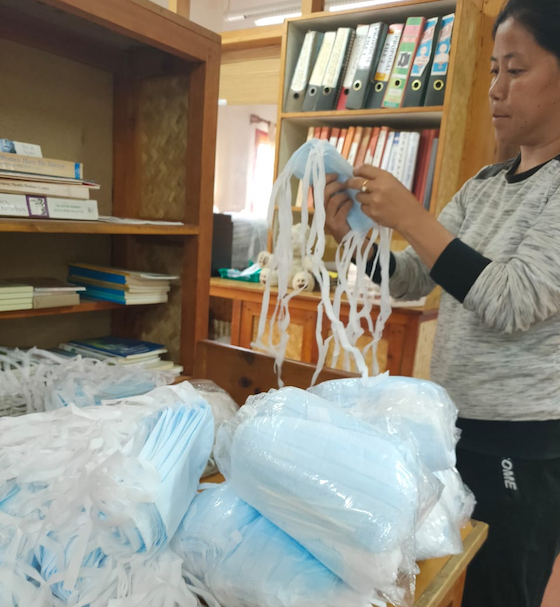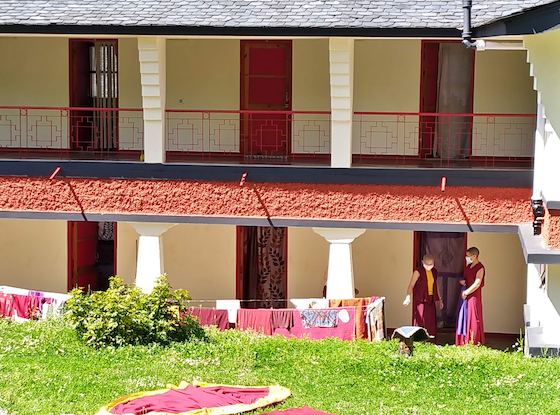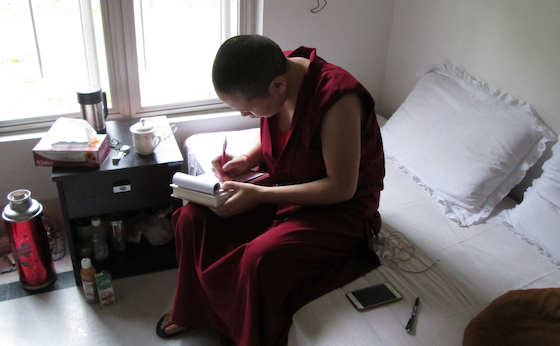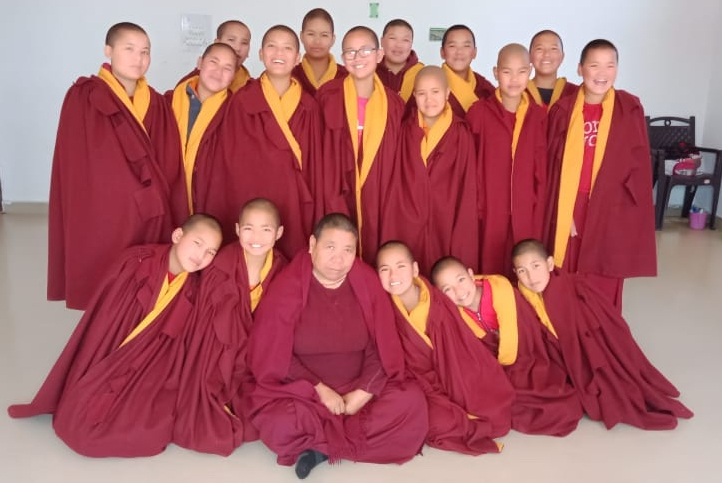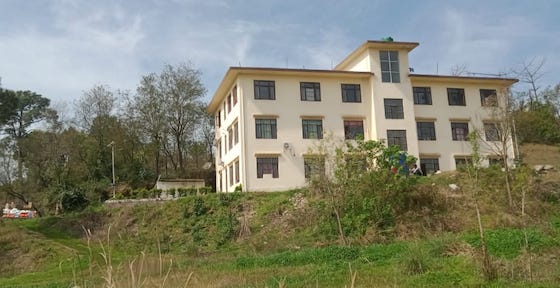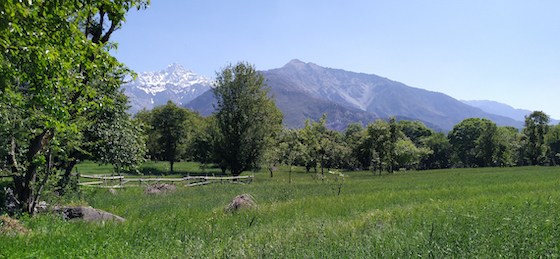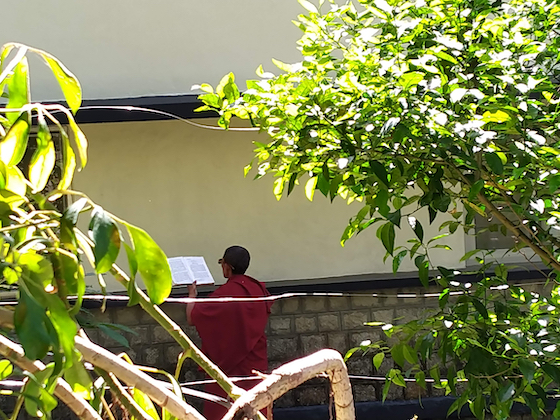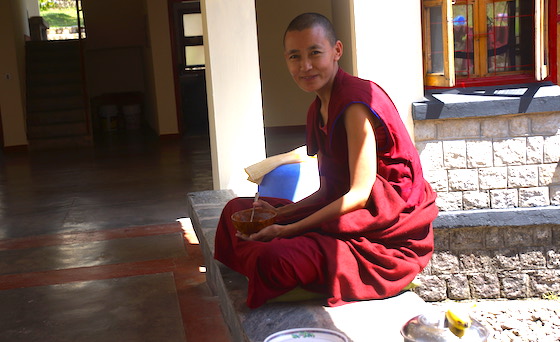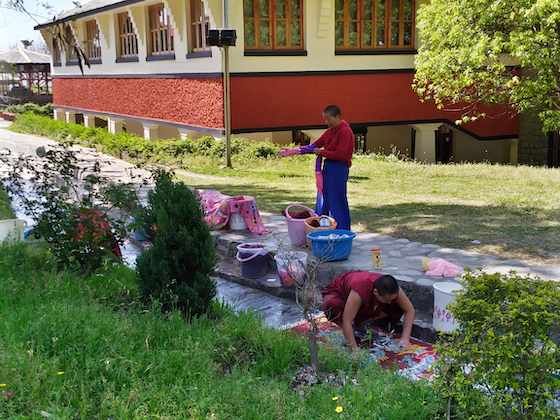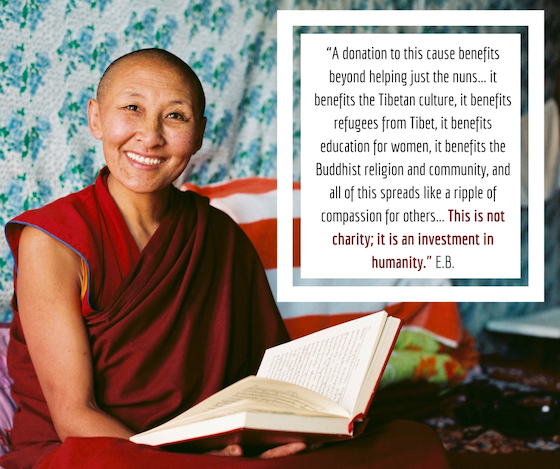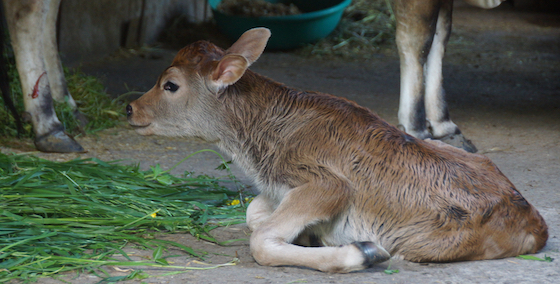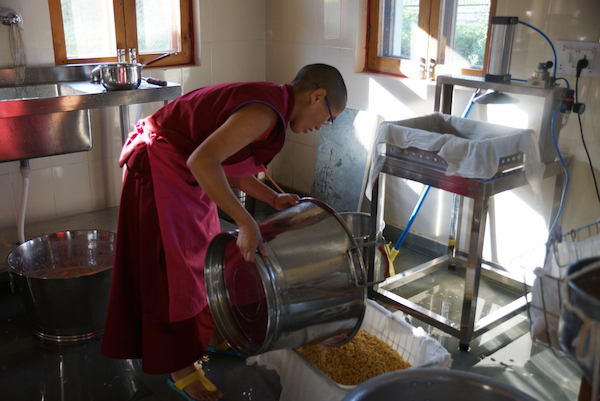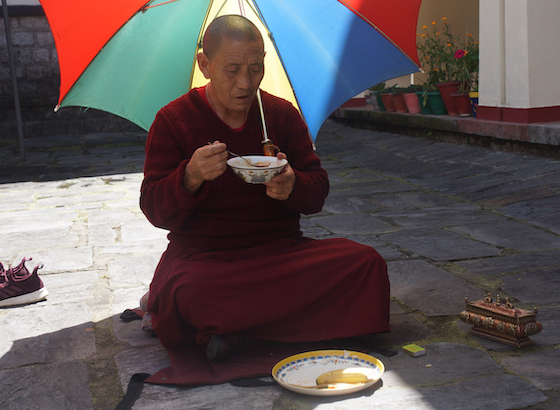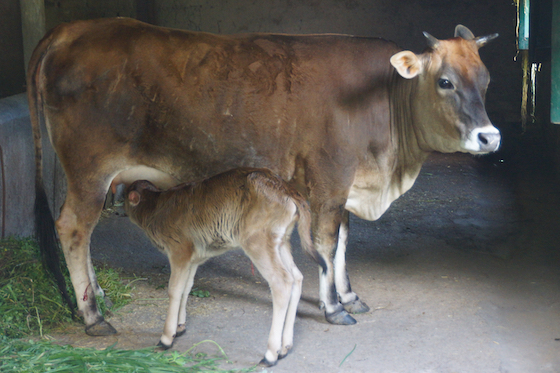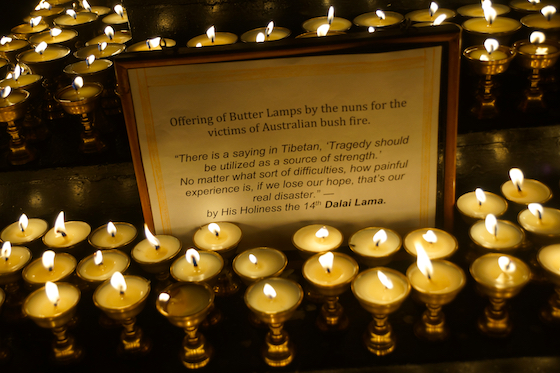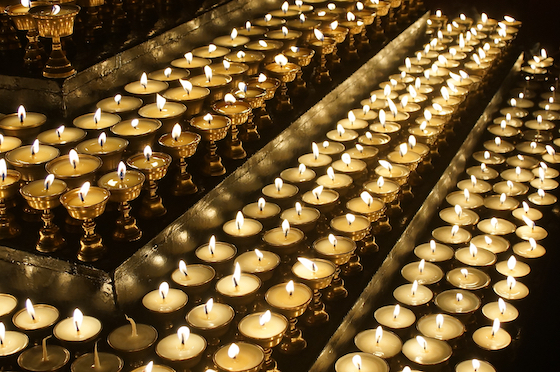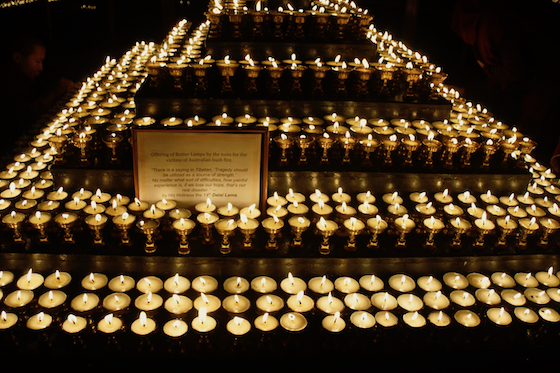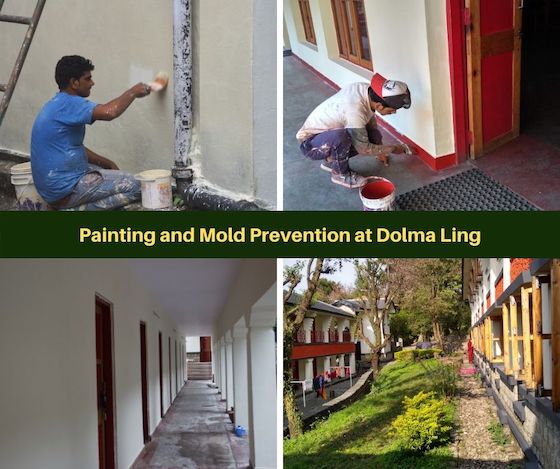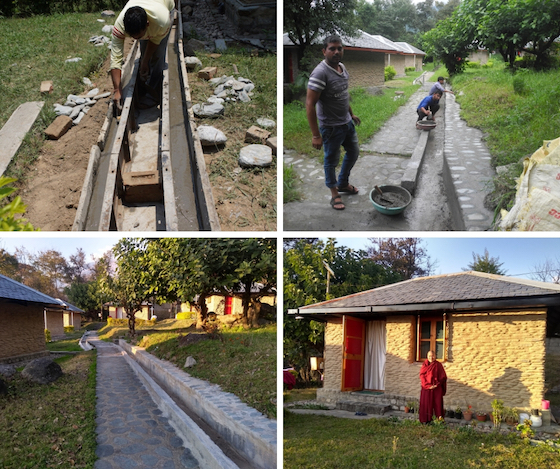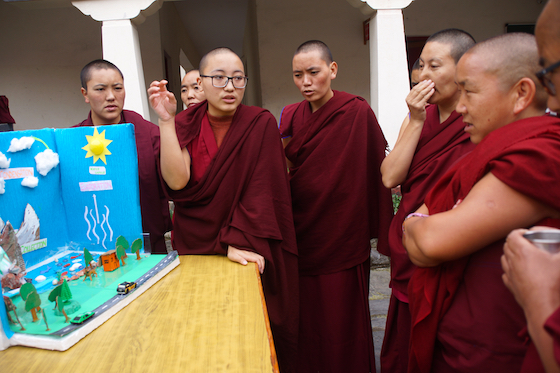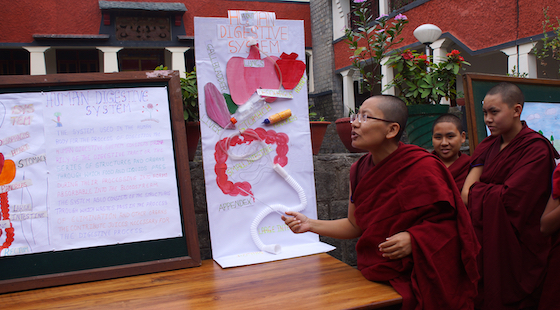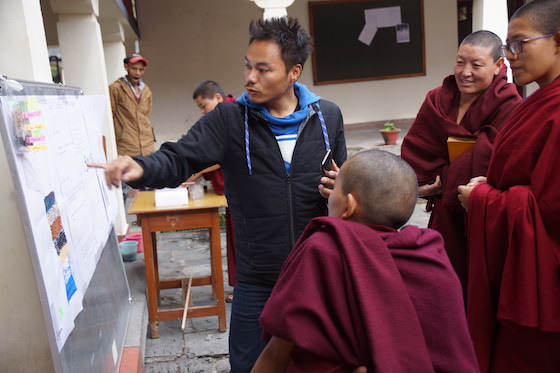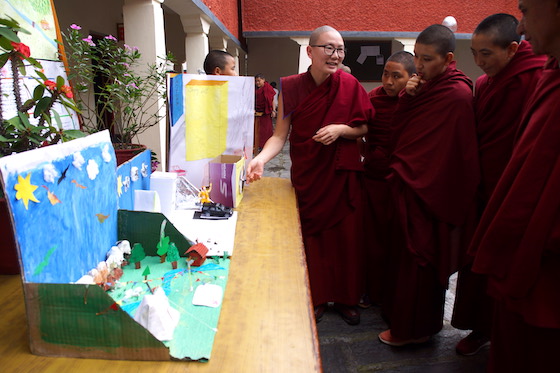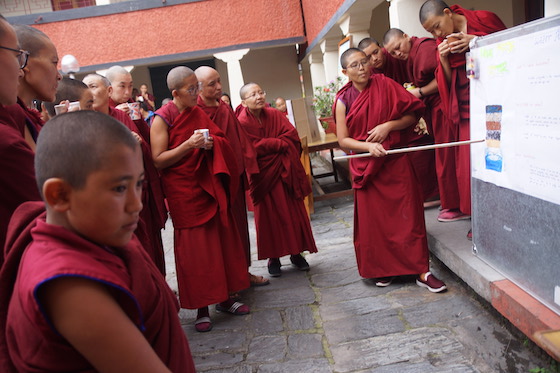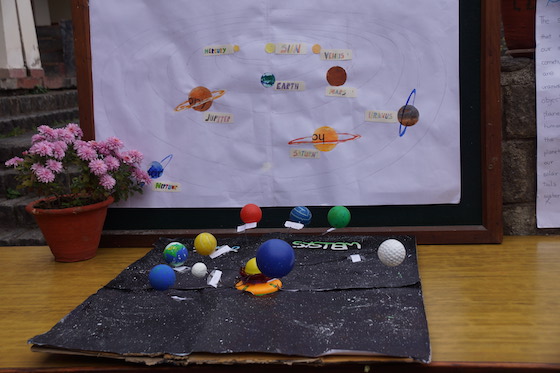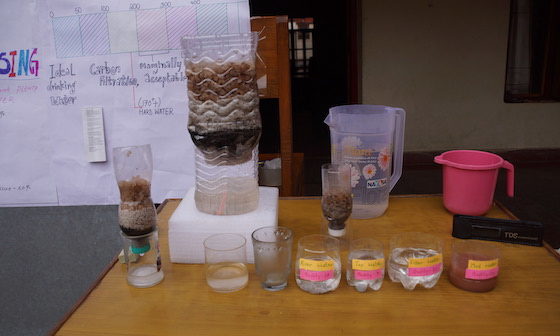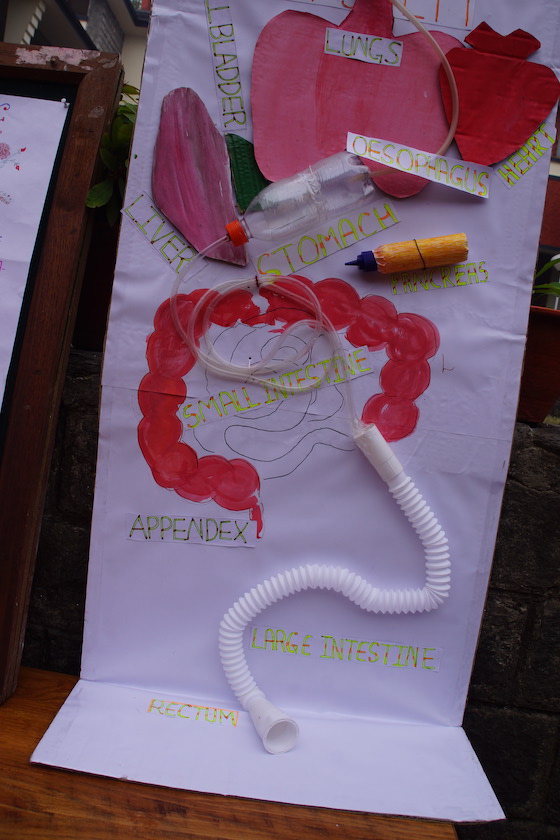The kitchen is a central part of life at Dolma Ling Nunnery and Institute, home to about 250 nuns and 30 staff. It is run by one nun who is permanently stationed there, supported by a rotation of 8 other nuns. The nuns are willing but not always experienced!
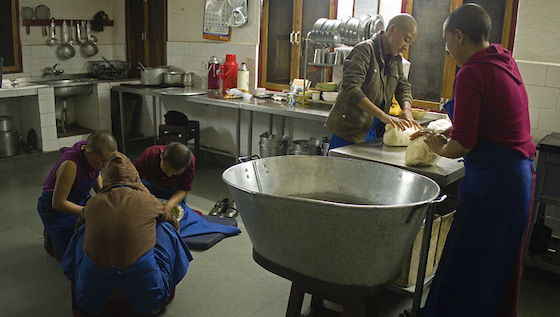
Inside the kitchen at Dolma Ling Nunnery. The Tibetan Nuns Project is fundraising for a rice cooker, a dough-making machine, a fridge, and two new gas burners. See below for more details. Photo by Brian Harris.
Breakfast Means an Early Start!
Each morning, the nuns on kitchen duty wake up around 3:30 am (2:30 am in the summertime) to prepare round flatbreads called Amdo Balep for breakfast. The evening before, the nuns prepare the dough and leave it to rise overnight so it is ready to shape and bake on the large gas griddle. To feed all the nuns and staff, the nuns must make and bake 350 pieces of bread. The 6-inch diameter flatbreads are served in the dining hall at 7:00 am following the nuns’ morning prayers.

On special occasions, the Tibetan Buddhist nuns on kitchen duty make paratha, a fried flatbread, for breakfast. Photo by Brian Harris.
As well as bread, the nuns get eggs on some days and on other days they eat cooked vegetables. And, of course, tea.
Lunch
The nuns start preparing lunch after the morning tea has been served at 10:15. Some of the group of nuns on kitchen duty may already have been assigned to clean and cut vegetables downstairs in the special area below the kitchen that was built for this purpose. To have lunch ready at 12:15, the nuns must start work very soon after breakfast.
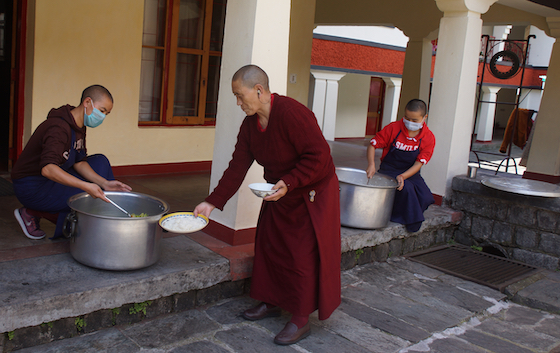
Lunchtime at Dolma Ling Nunnery. During the pandemic lockdown, the nuns ate their meals apart. Photo by the Dolma Ling Media Nuns.
Cooking rice for nearly 300 people is a challenge and dangerous. Keep reading to learn about our special campaign to buy the nuns a rice cooker, a dough-making machine, and a freezer. It takes a long time to cook the rice in a huge caldron over one of the two large gas burners in the kitchen. When the rice is half-cooked, the nuns must pour off the excess water – a very risky operation.
It takes two strong nuns to pick up the giant pot and carry it to the drain where they strain off the water through a cloth. This action must be done swiftly and carefully to avoid being scalded by the boiling hot water and also to prevent the loss of steam. The nuns then cover the rice with a cloth and leave it to stand in its own steam for up to an hour to become soft and tasty.
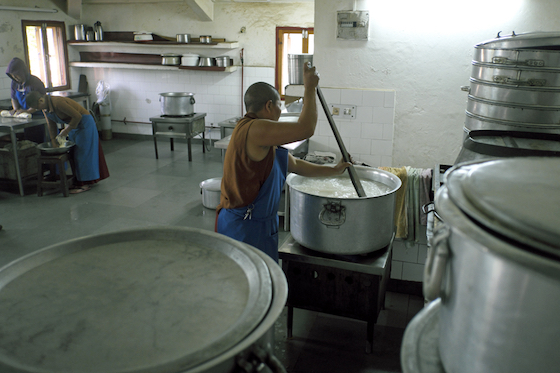
Cooking rice for hundreds of nuns is dangerous and the nuns need an electric rice cooker. You can donate below. Photo by Brian Harris
In the meantime, the nuns prepare and cook the two vegetable dishes and one dal (lentil dish) which form the standard lunch in the nunnery. Because there are only two large gas burners, it is quite a tricky exercise to cook three dishes as well as the rice in time for lunch. The kitchen nuns can’t keep everyone waiting in the dining hall! Having a separate electric rice cooker will make managing the kitchen considerably smoother.
Supper
After lunch, the nuns prepare dough and leave it to rise until it is time to prepare dinner or supper. The evening meal usually consists of tingmo (Tibetan steamed buns) served with a vegetable dish. The quality of the steamed buns depends on how well the dough is prepared. If the dough is inadequately mixed, it won’t rise properly and the buns will be chewy and indigestible. A dough-making machine will help to ensure that the nuns get lovely soft fluffy buns!
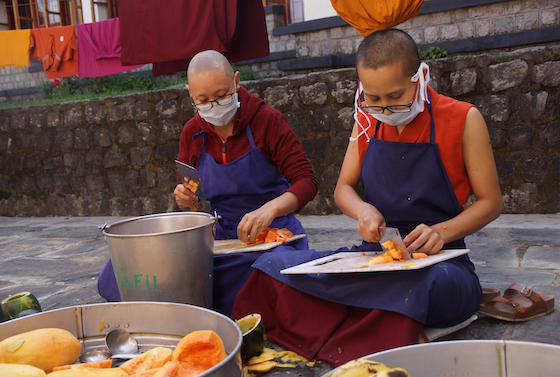
Chopping papayas. Photo by the Dolma Ling Media Nuns
Sometimes the nuns prepare thukpa, Tibetan noodle soup, for supper. Once again, having a dough-making machine would be a great help in preparing the dough for the noodles. Thukpa is normally made using a mix of eggs, flour, and water but there are some nuns who don’t eat eggs so the nuns on kitchen duty always make two batches of noodle dough.
Once the dough is mixed, the nuns run through the noodle-making machine. Having a dough-making machine would be so helpful to the nuns and they will be saved from the temptation of buying readymade noodles from outside the nunnery, thus saving the nunnery money.
After dinner, the nuns set about preparing the dough for the breakfast bread and leave it to rise overnight. It is hard work mixing and kneading so much dough by hand! Usually, the kitchen nuns don’t finish their duty until 8:00 pm. Since they start work at 2:30 or 3 am, it is a very long day!
Help the Nuns Cook Rice Safely
Cooking rice for nearly 300 people is dangerous and challenging. Currently, the nuns cook rice in a huge cauldron over a large gas burner. When the rice is half-cooked, they have to pour off the excess water – a very risky operation.
The safety of the nuns is the main reason why we are asking for your help to purchase an electric rice cooker for the Dolma Ling Nunnery kitchen. A rice cooker would also save on fuel costs.
Having an electric rice cooker will mean that the rice cooks more evenly and that it keeps more of its nutritional qualities and will be better for the nuns’ health. Rice cooked in a giant caldron does not cook evenly and has to be frequently stirred.
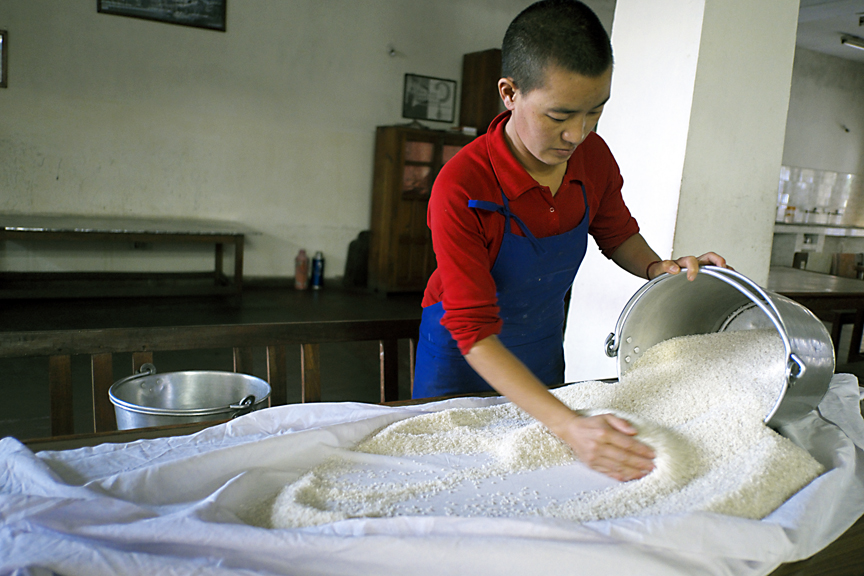
The nuns have asked for help to buy a rice cooker with a capacity to cook up to 77 pounds of rice. Photo by Brian Harris
The nuns would like a rice cooker with a capacity of up to 35 kilograms (77 pounds) of rice which is about the biggest they can find in their area. Normally, the Dolma Ling nuns cook 20 to 25 kilos (44 to 55 pounds) of rice for one meal, but it will be good to have a slightly bigger capacity for special occasions. By buying from a reputable local kitchen equipment supplier who is prepared to give the nuns a good warranty and service, the nuns feel that this will be a huge benefit to the nunnery and will be a much safer and more efficient way of cooking rice.
Help the Nuns Buy a Dough Mixer
Each day the nuns on kitchen duty prepare traditional Tibetan bread and steamed buns for hundreds of nuns. Mixing the dough by hand is incredibly labor intensive and less hygienic than using a machine. The nuns have asked for help to buy a dough-making machine with a capacity of 25 kg (55 pounds).
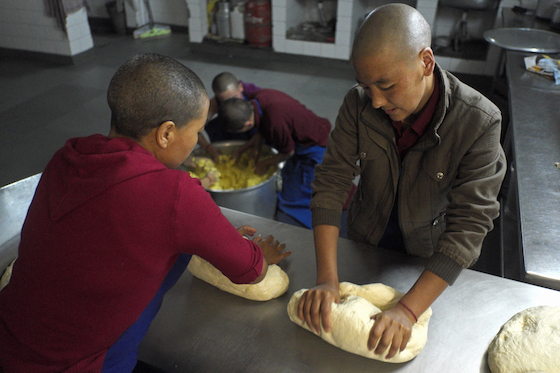
Kneading dough by hand is an incredibly labor-intensive process and the nuns have asked for help to purchase a dough-making machine. Photo by Brian Harris
Mixing dough by machine takes only 15 to 20 minutes, so it would be so much easier to prepare multiple batches for bread, buns, and noodles. Normally the nuns up to 20 kg (44 pounds) of flour at a time and the machine would be used for at least two meals each day.
The dough-making machine will also be used on special occasions when the nuns serve paratha, a fried flatbread, for breakfast and also for times like before Losar, Tibetan New Year, when the nuns prepare delicious crisp khapse, fried Tibetan biscuits. Every member of the nunnery gets a large bag of khapse to celebrate Tibetan New Year so preparing large quantities is a great deal of work.
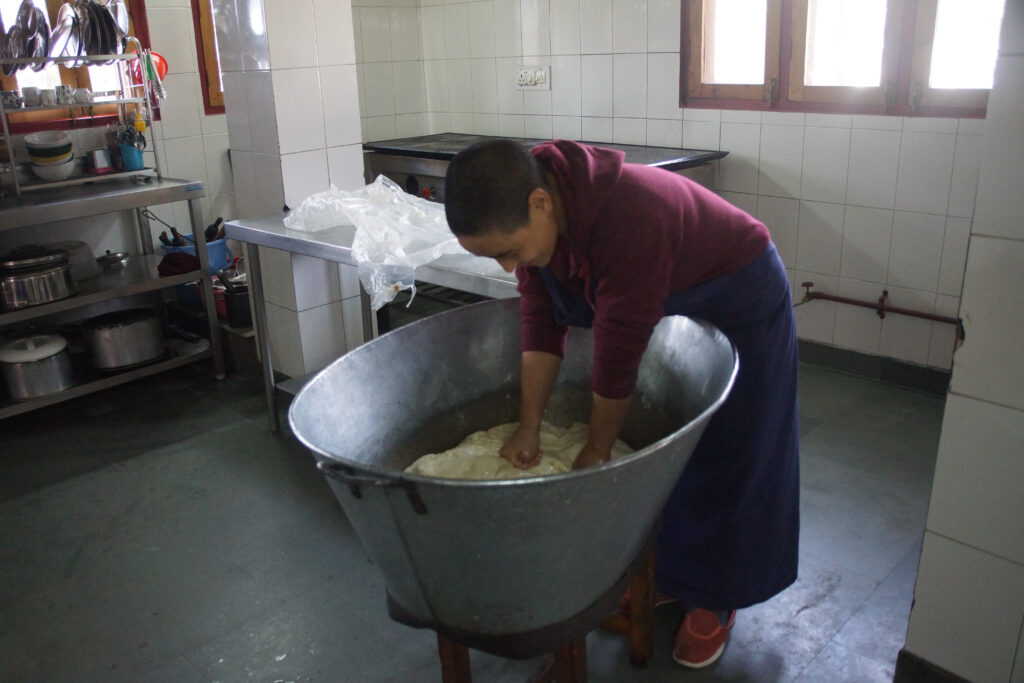
The nuns make dough daily for Tibetan bread (Amdo Baleh) and steamed buns (tingmo) and also, on special occasions, for khapse which are fried Tibetan biscuits, and paratha, fried flatbreads. Mixing dough by hand is hard work when you have almost 300 people to feed. A dough-making machine would make the work much easier and give better results. Photo by the Dolma Ling Media Nuns.
The Nuns Need Two New Hot Water Boilers
The nuns like to have hot water to drink in their rooms while they are studying in the evening. The nunnery built a small covered facility in the first wing courtyard in which there are two hot water boilers where the nuns can fill their thermoses to take to their rooms. However, each boiler takes about four hours to heat 100 litres (26 gallons) of water and there is not enough for everyone to get even one litre of water.
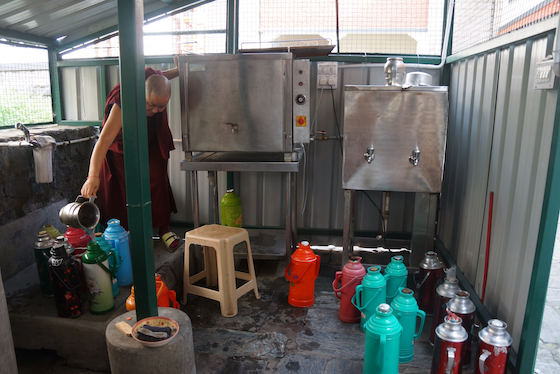
The nuns need two new water boilers to have enough water for everyone. Right now some nuns get up in the middle of the night to fill their thermoses because there’s not enough supply at other times. Photo by the Dolma Ling Media Nuns.
Some nuns are getting up in the middle of the night to fill their thermoses if they miss out on the first boiling. The nuns have asked for help to buy two new boilers so they can have enough hot water for all the nuns. They also need to get the two older boilers serviced. Right now, the nuns are unable to take even one boiler out of service to get it repaired because there will be a drastic shortage of boiled water.
New Refrigerator for the Dolma Ling Kitchen
Dolma Ling’s old, large, 4-door refrigerator was bought a very long time ago. It has broken down many times and was frequently repaired. However, it has now stopped working and must urgently be replaced. During the winter when it is very cold (and because the nuns follow a vegetarian diet and do not cook meat in the nunnery), the nuns have managed without a fridge, but soon the summer heat and monsoon humidity will come meaning that vegetables and fruits will quickly rot. It is not possible to get fresh supplies daily and the nuns buy in bulk. The nunnery needs to be able to safely store perishable vegetables and fruit to avoid wastage and to save money. Milk, butter, cheese, and tofu also need to be refrigerated.

A nun sanitizes food outside the nunnery. The nuns have asked to help to buy a new fridge to replace their old one which has completely broken down. Photo by the Dolma Ling Media Nuns.
Without a new fridge, the nunnery is restricted in what it can buy and the nuns’ diet will be more monotonous. Especially during the pandemic and these times of lockdown, everyone looks forward to lunchtime. If the kitchen can provide a variety of vegetables such as tomatoes, mushrooms, broccoli, and spinach, all of which must be kept chilled, the nuns and staff will not only be healthier but also happier!
Please help the Tibetan Buddhist nuns at Dolma Ling with this essential kitchen equipment!
The total cost for all items is $10,700.
- Make a gift online at tnp.org
- Call our office in Seattle at 1-206-652-8901
- Mail a check to The Tibetan Nuns Project (for Rice Cooker and Dough Maker at Dolma Ling)
815 Seattle Boulevard South #216, Seattle, WA 98134 USA - Give a gift of securities
- Leave a gift in your will to the Tibetan Nuns Project

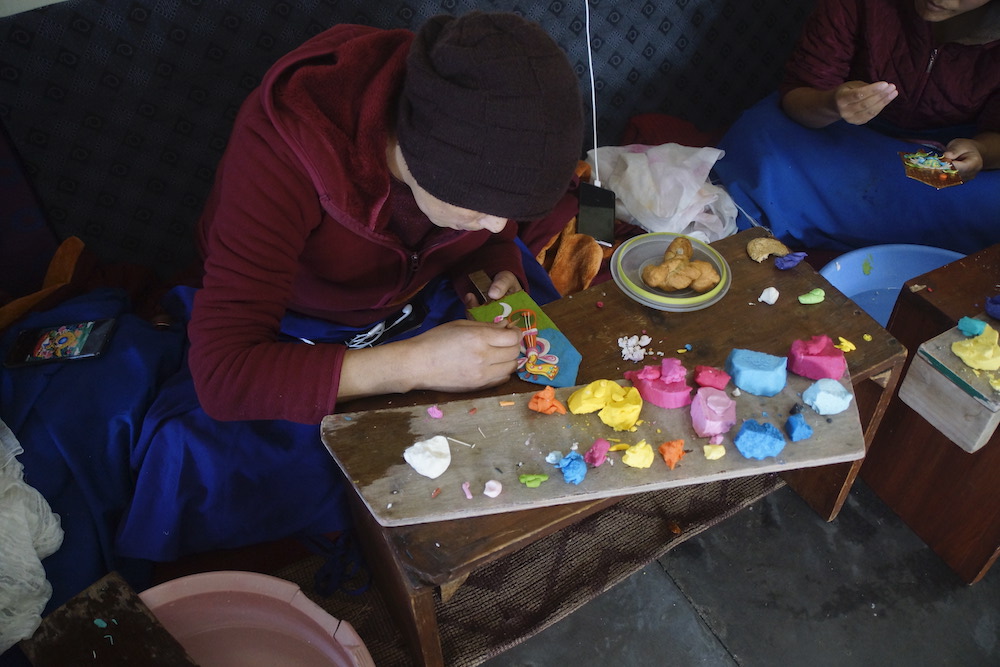
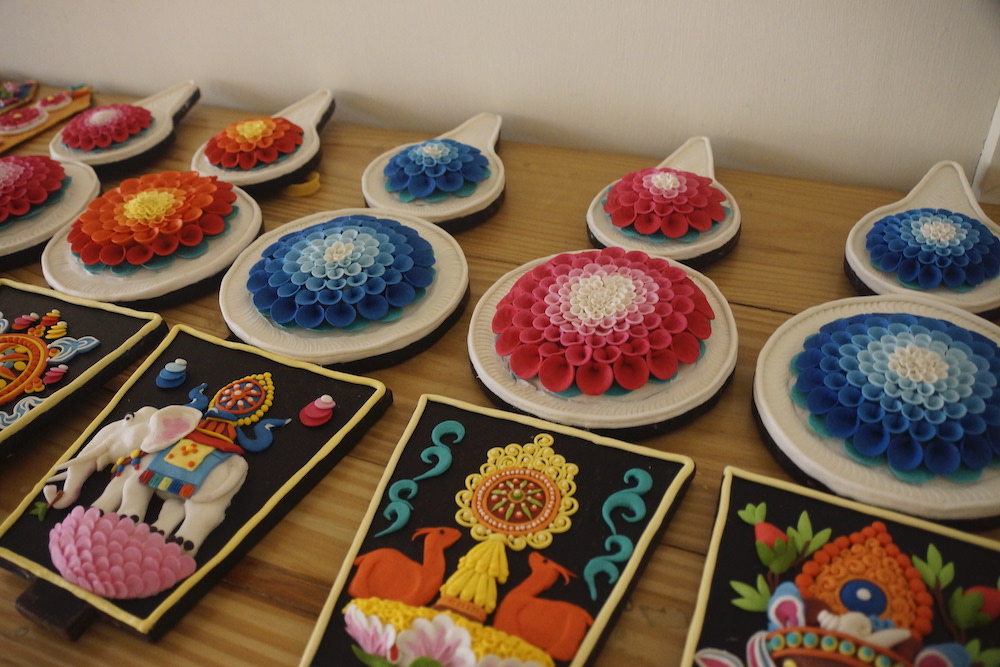
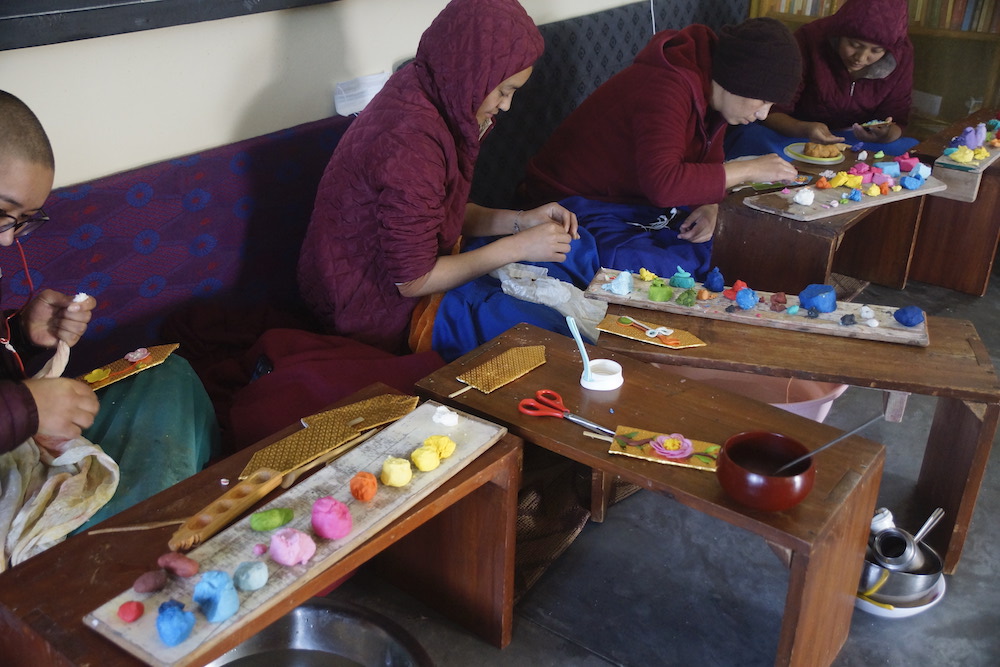
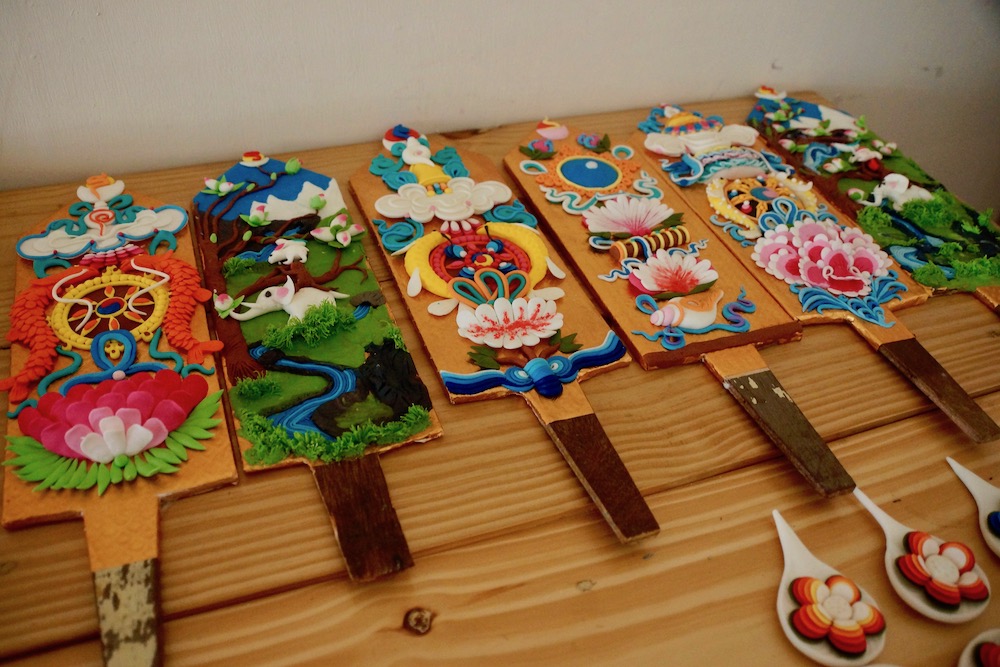
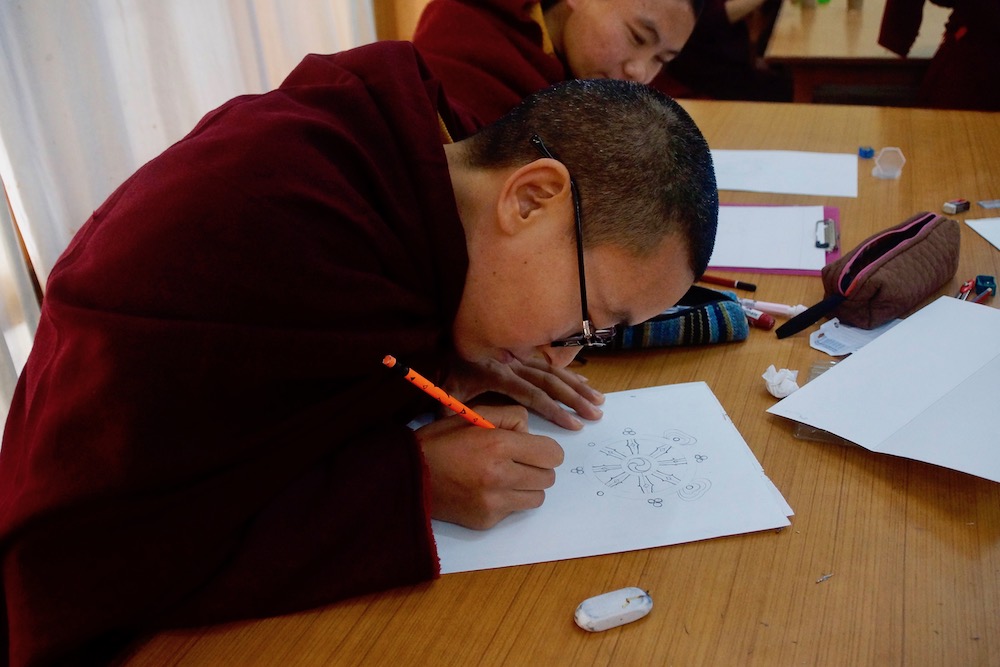
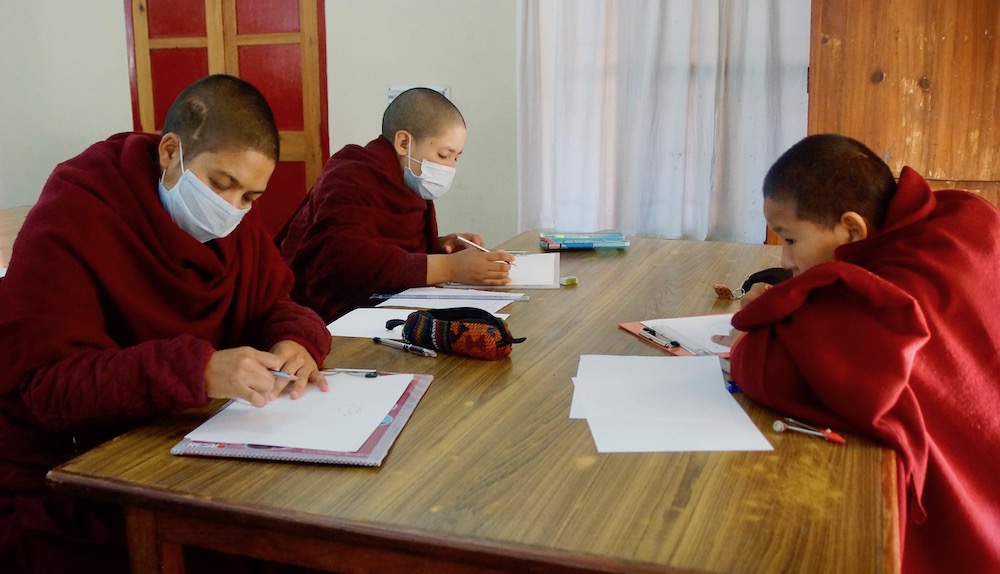
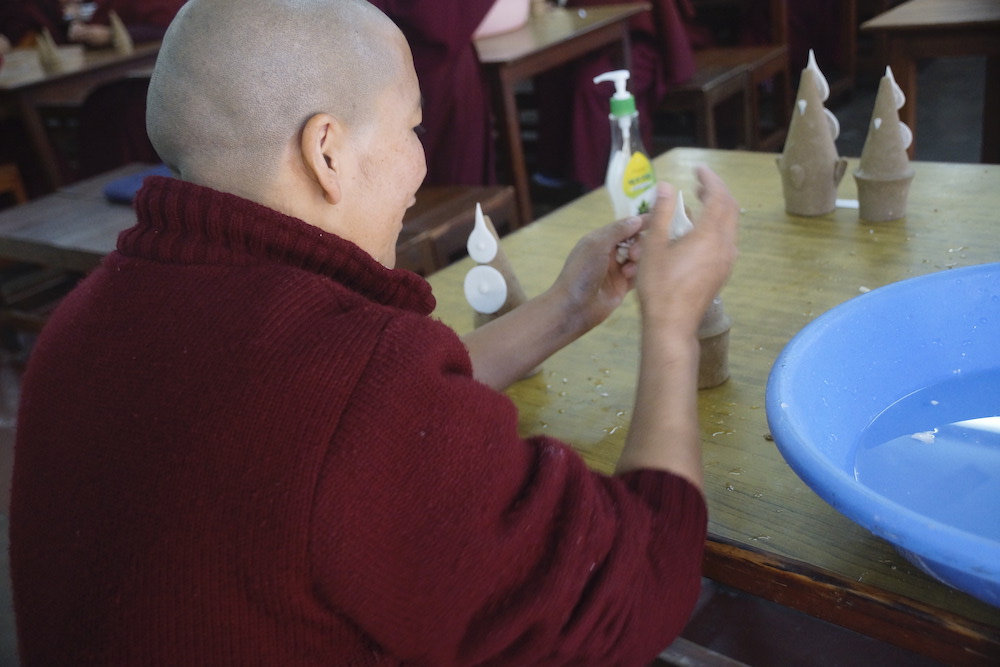
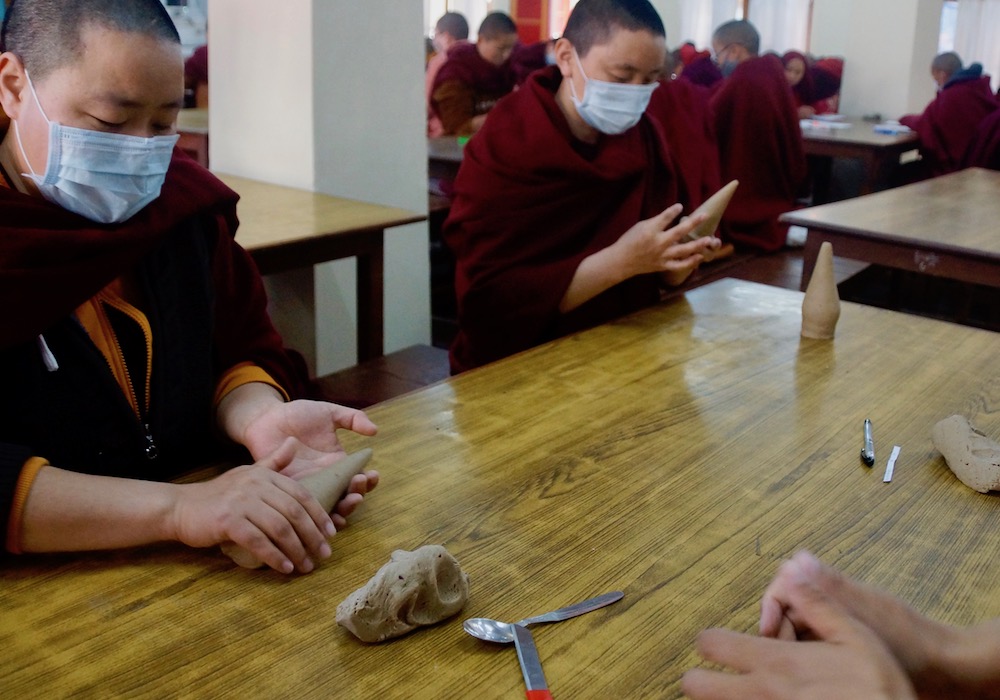
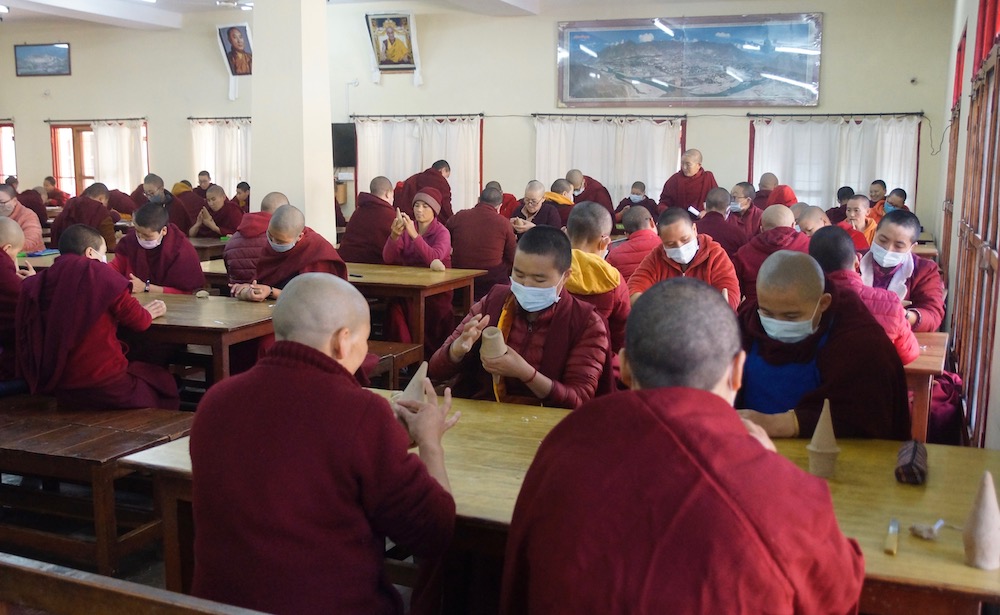
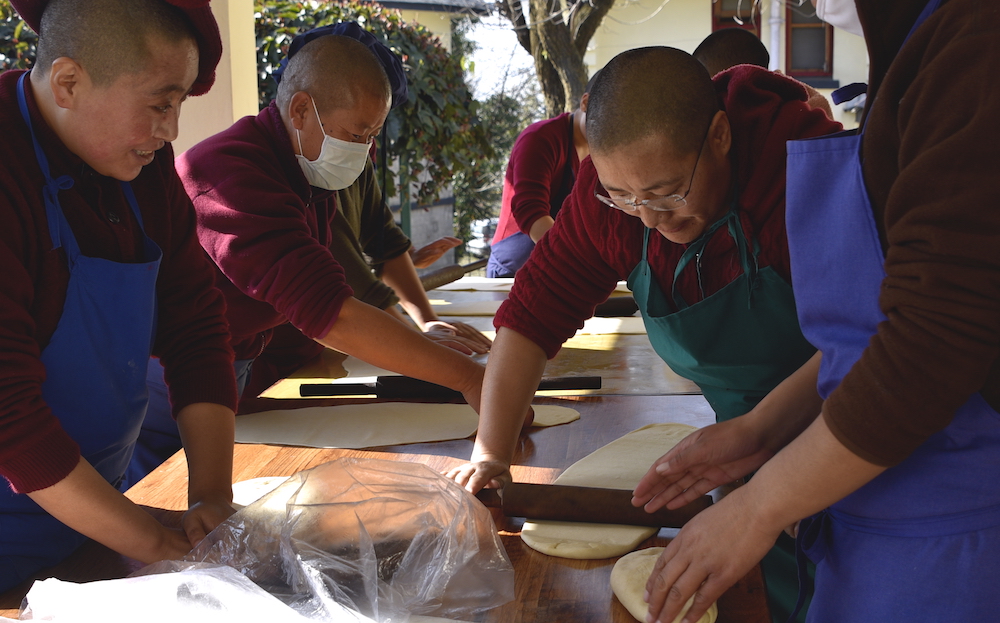
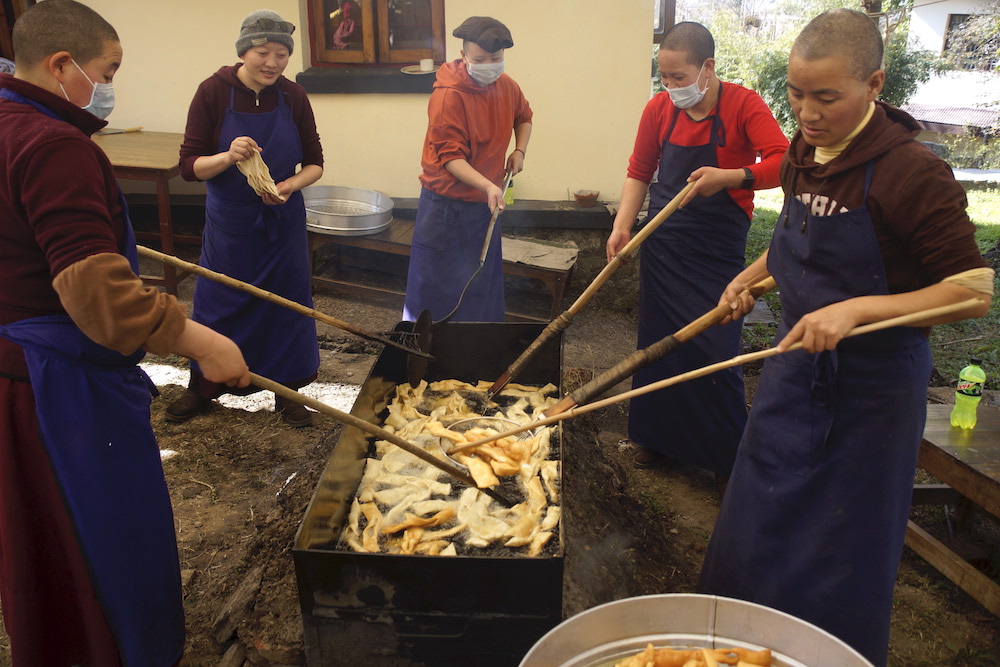
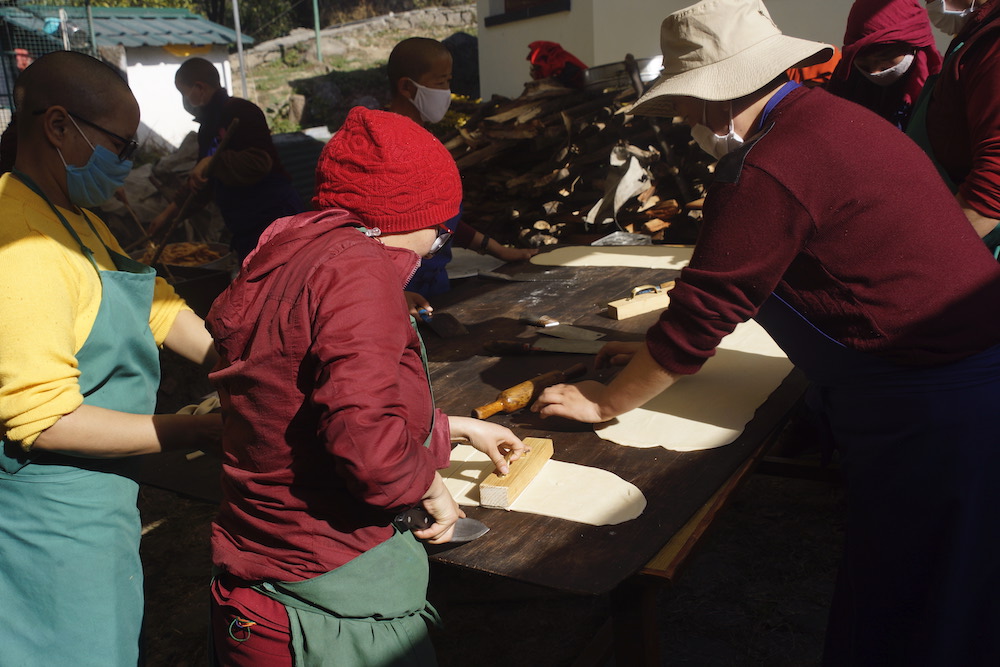
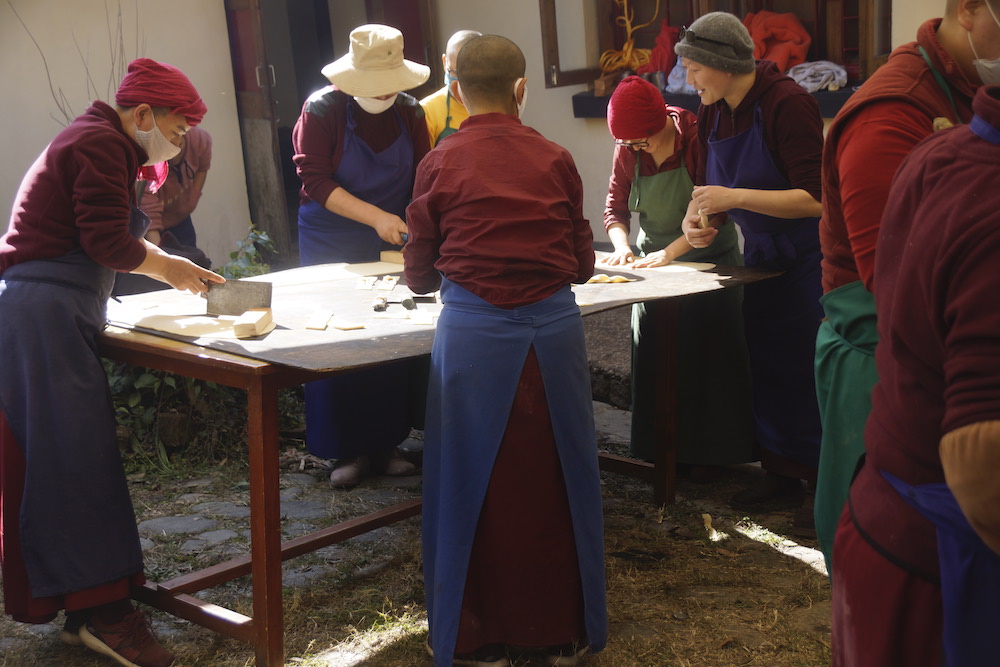
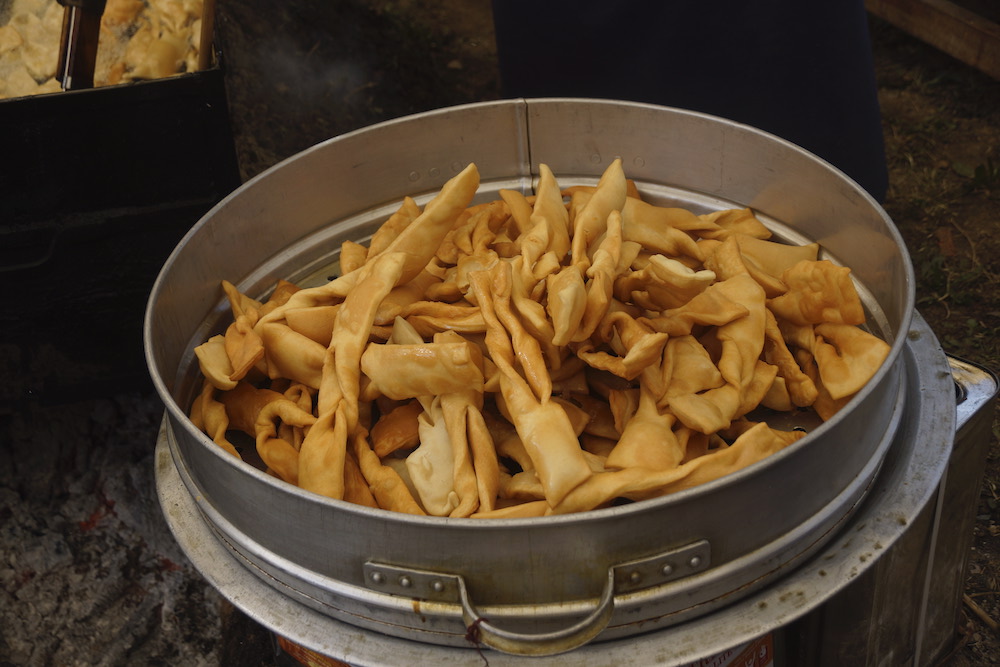
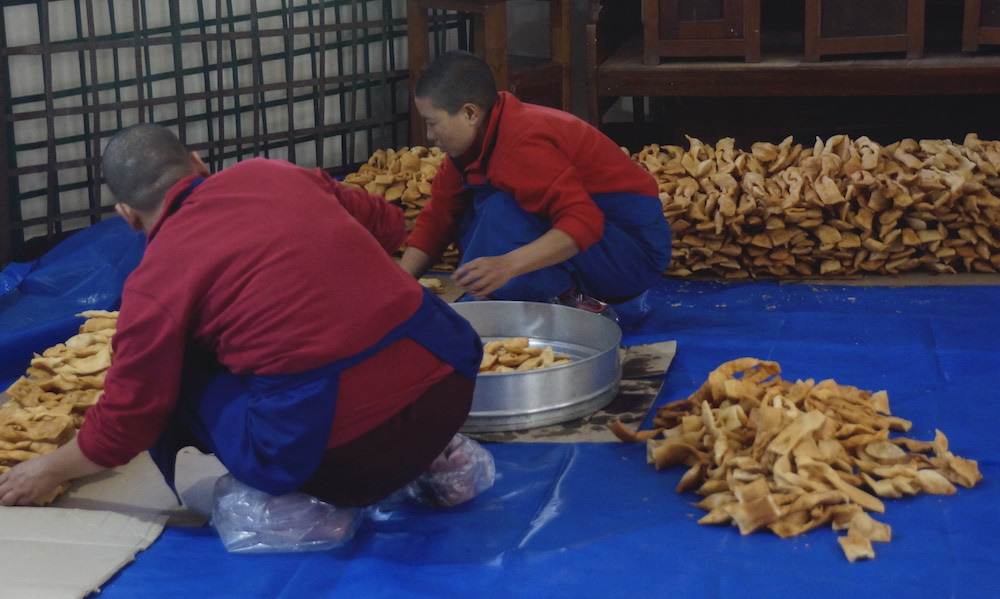


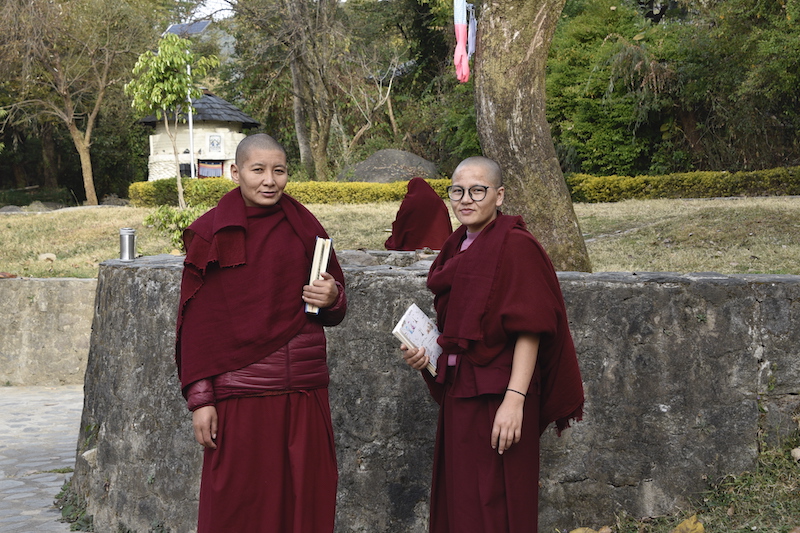
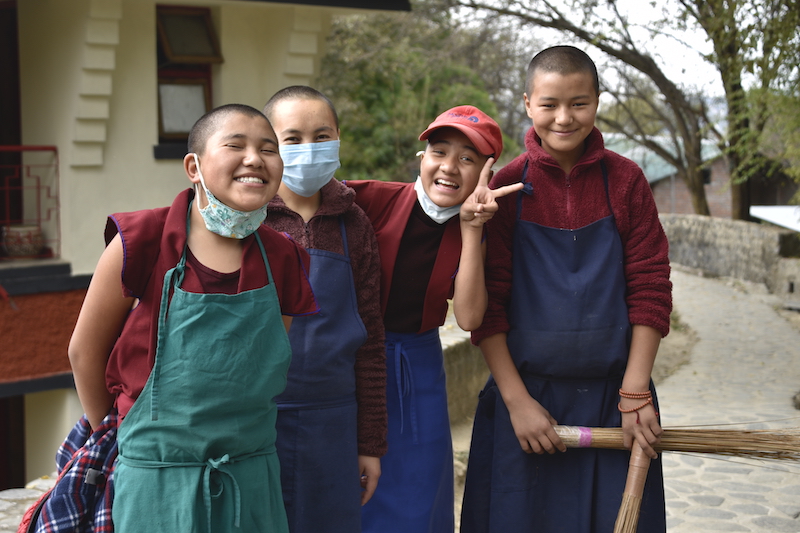
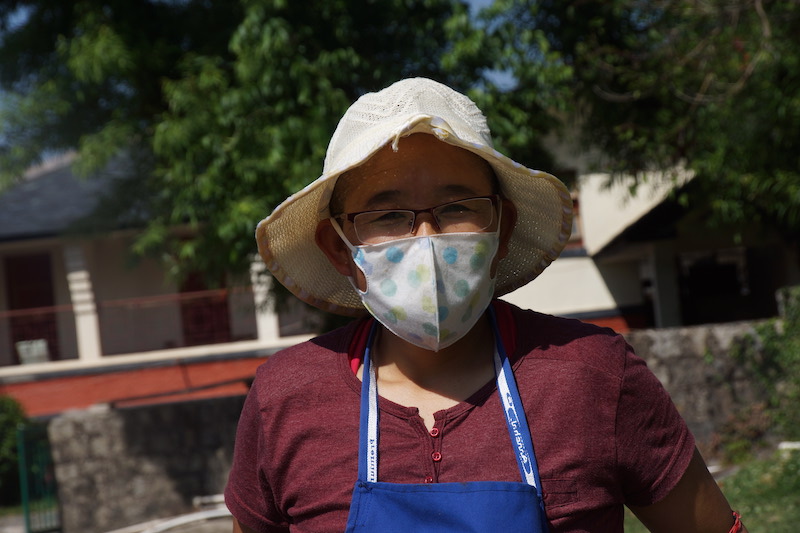
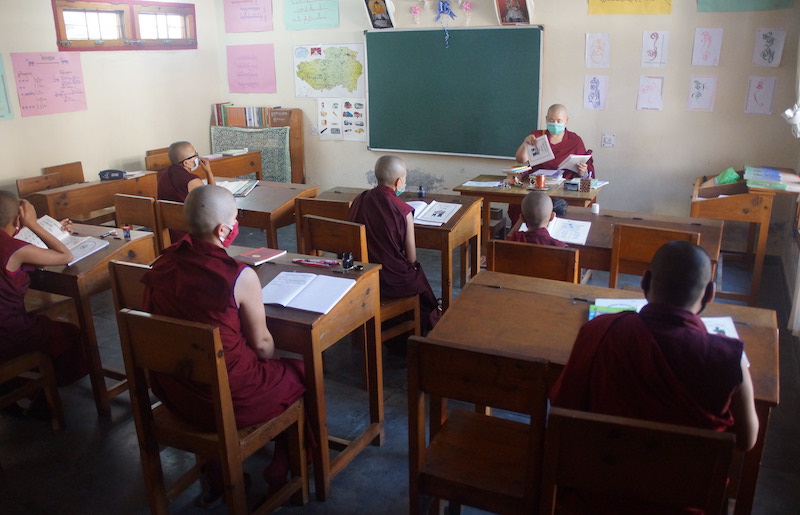
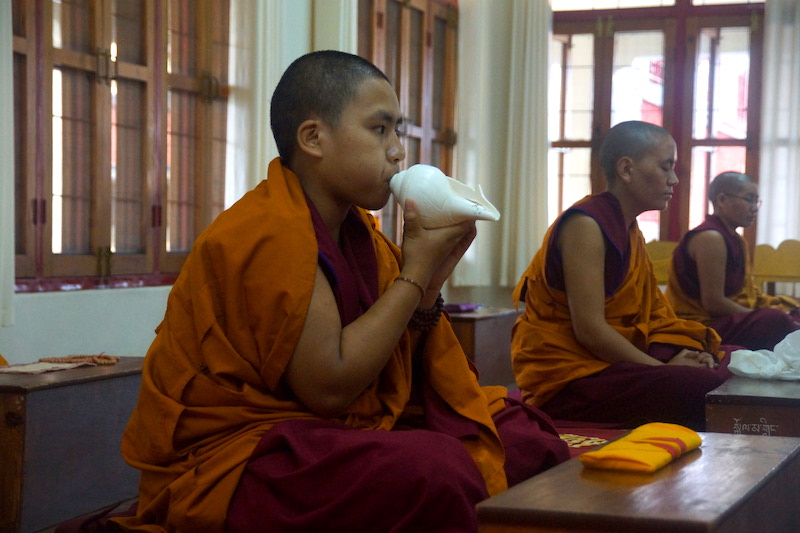

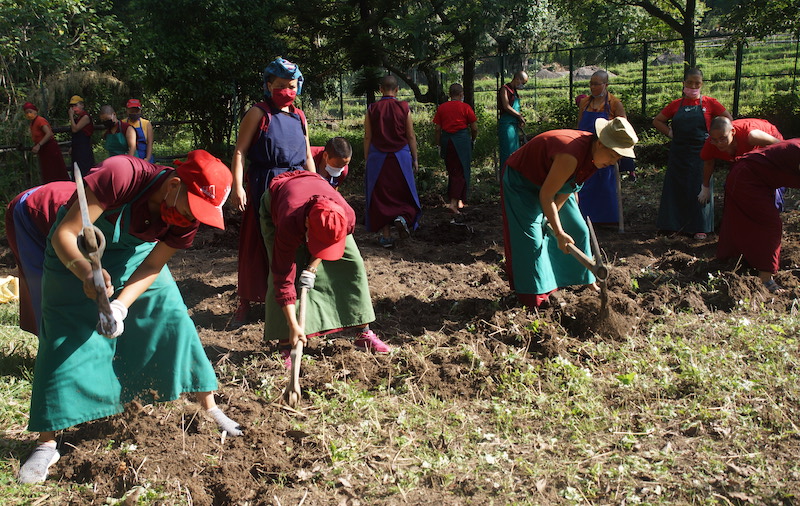
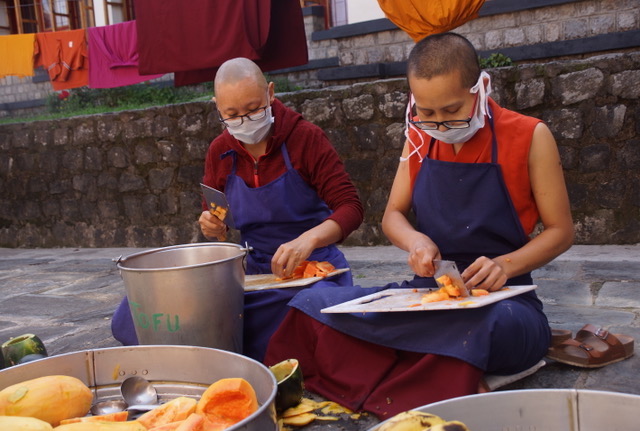
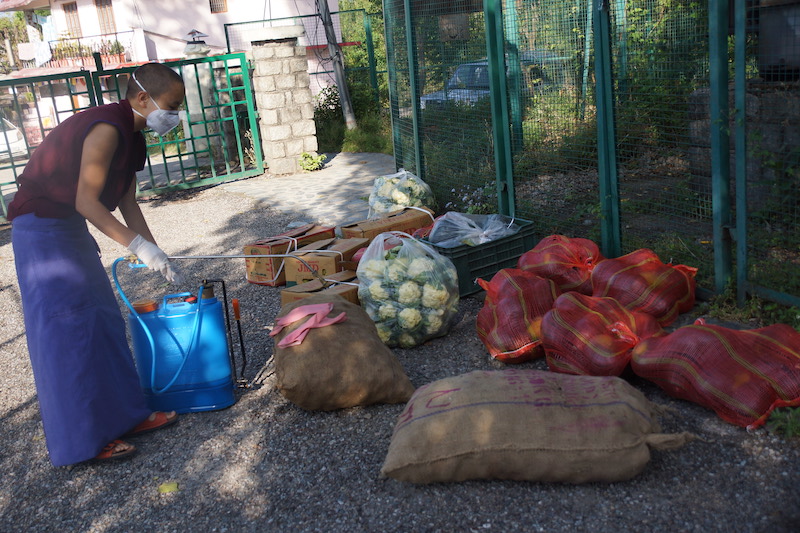
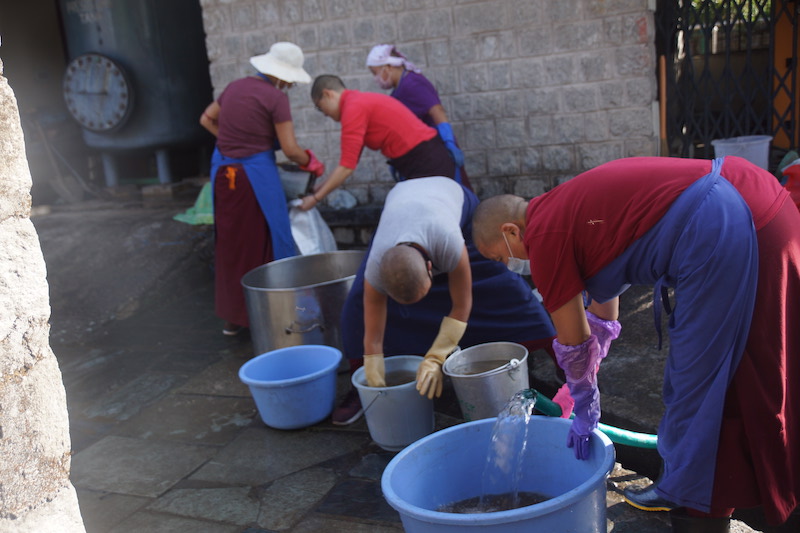
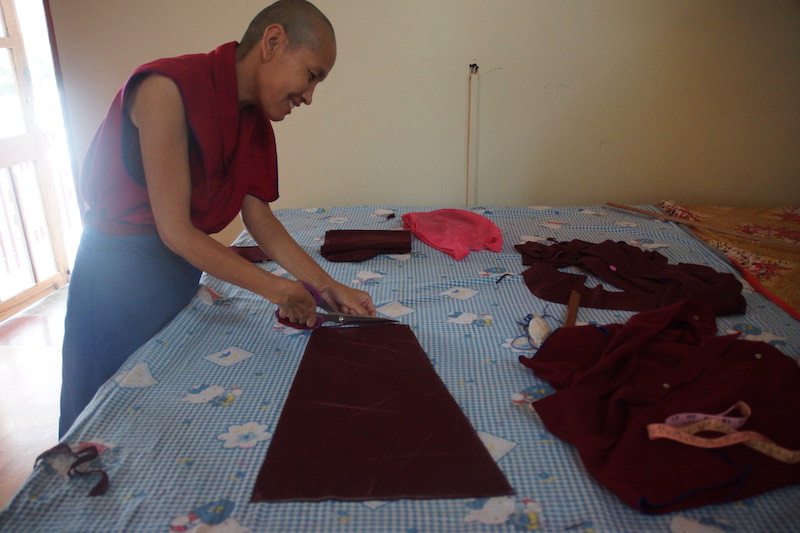

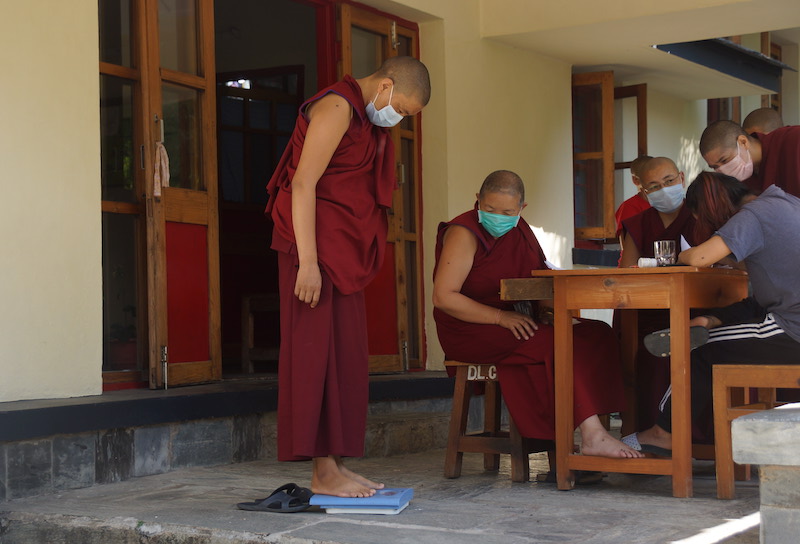
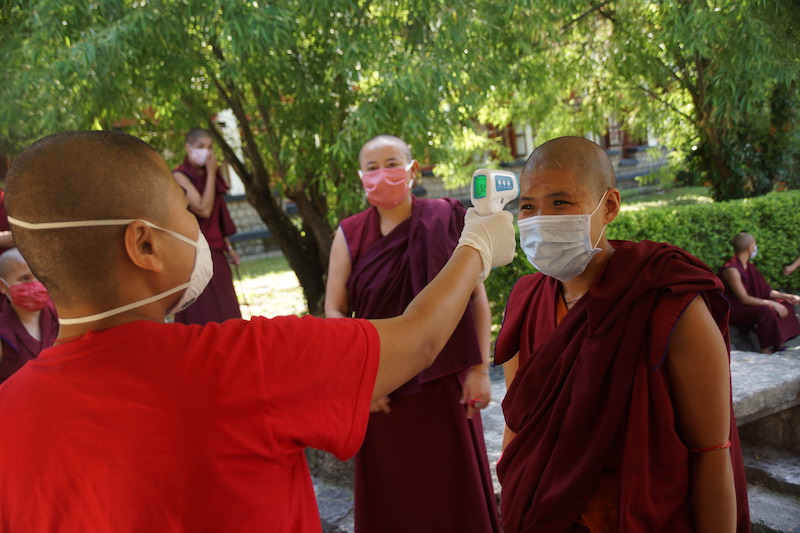
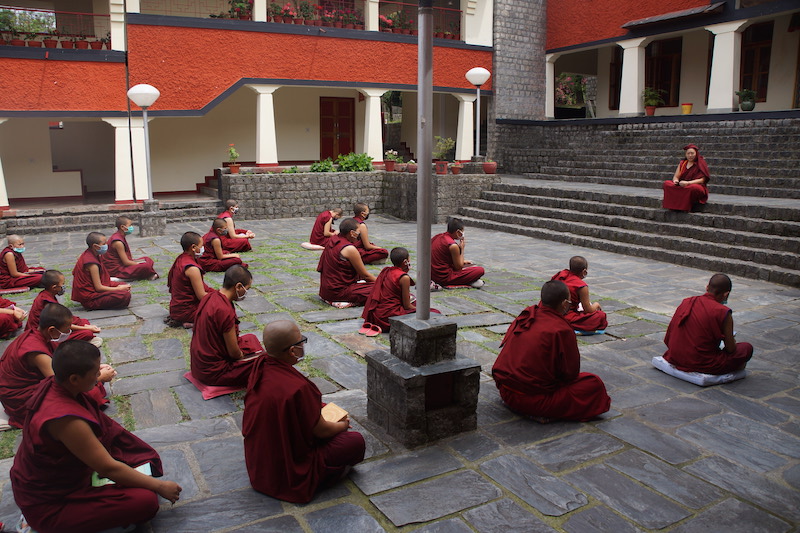
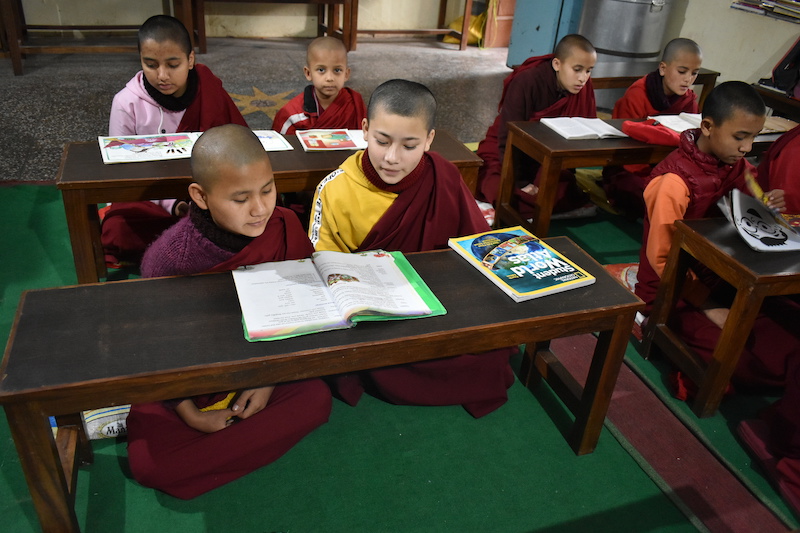
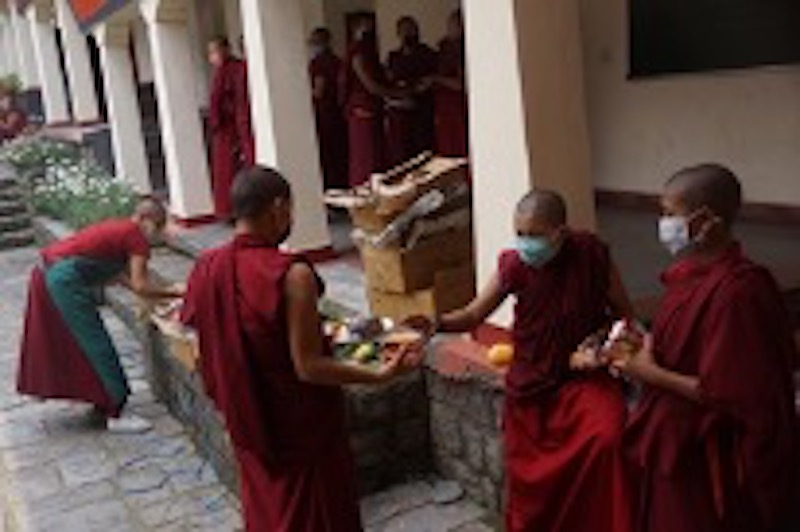
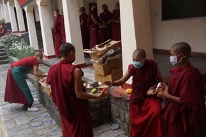
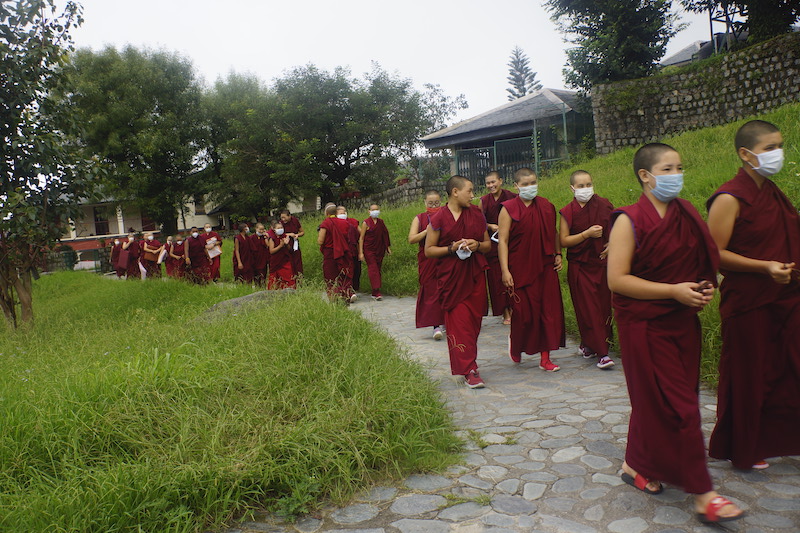
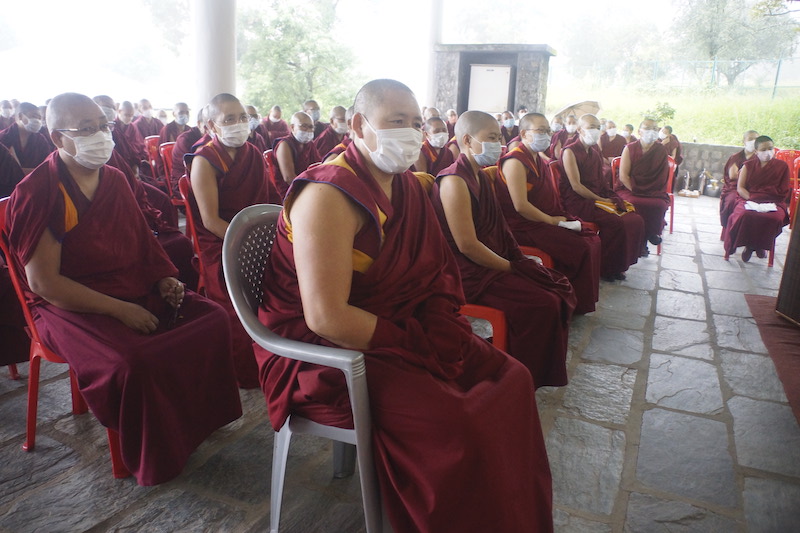
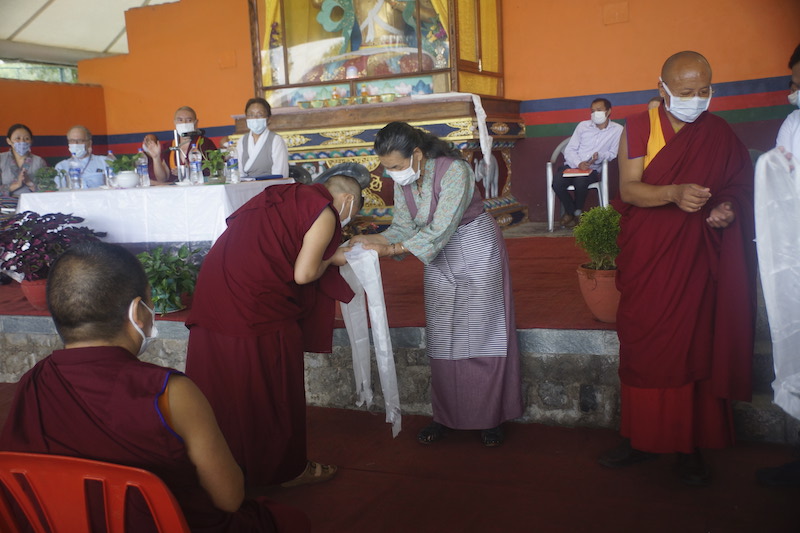
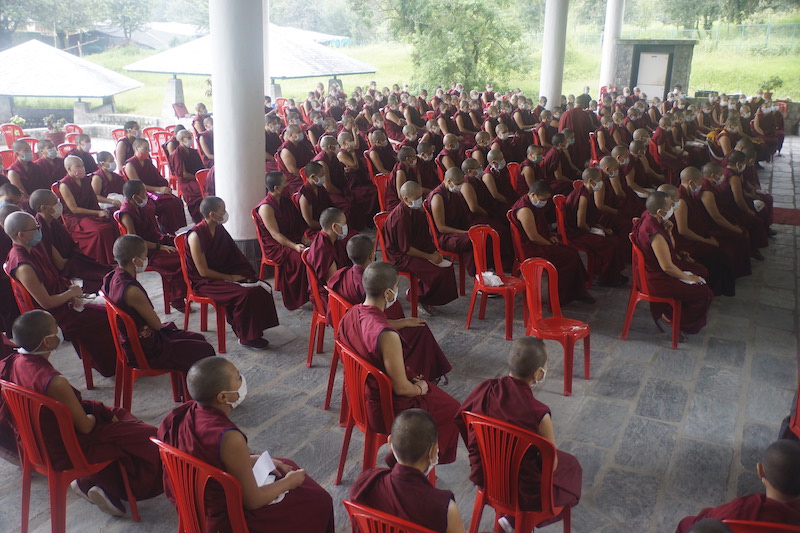
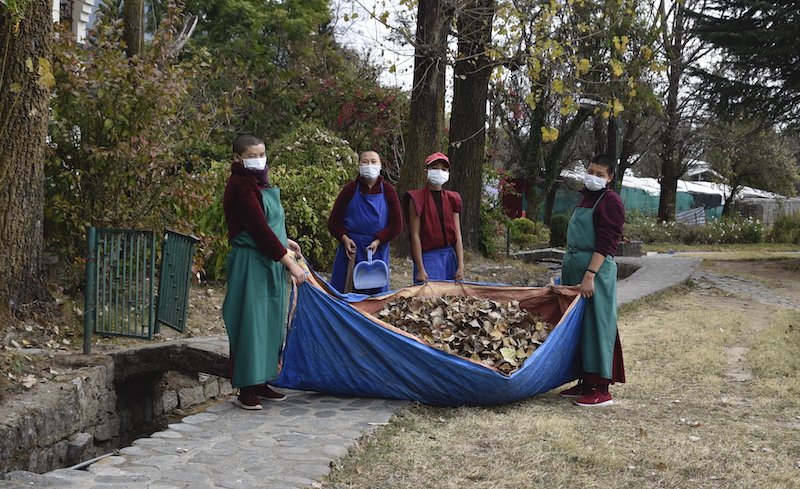
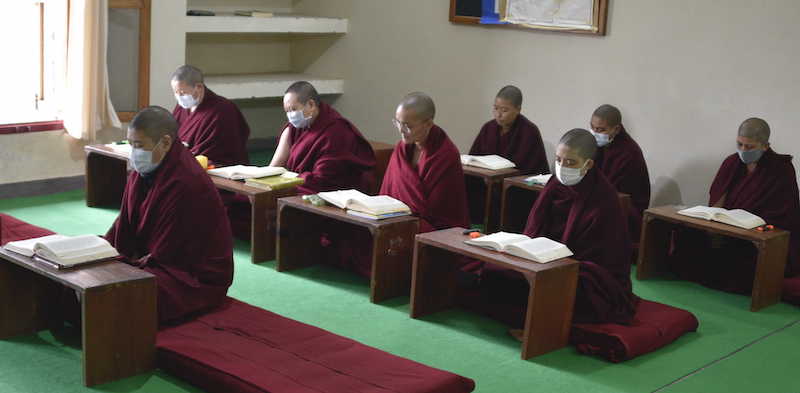
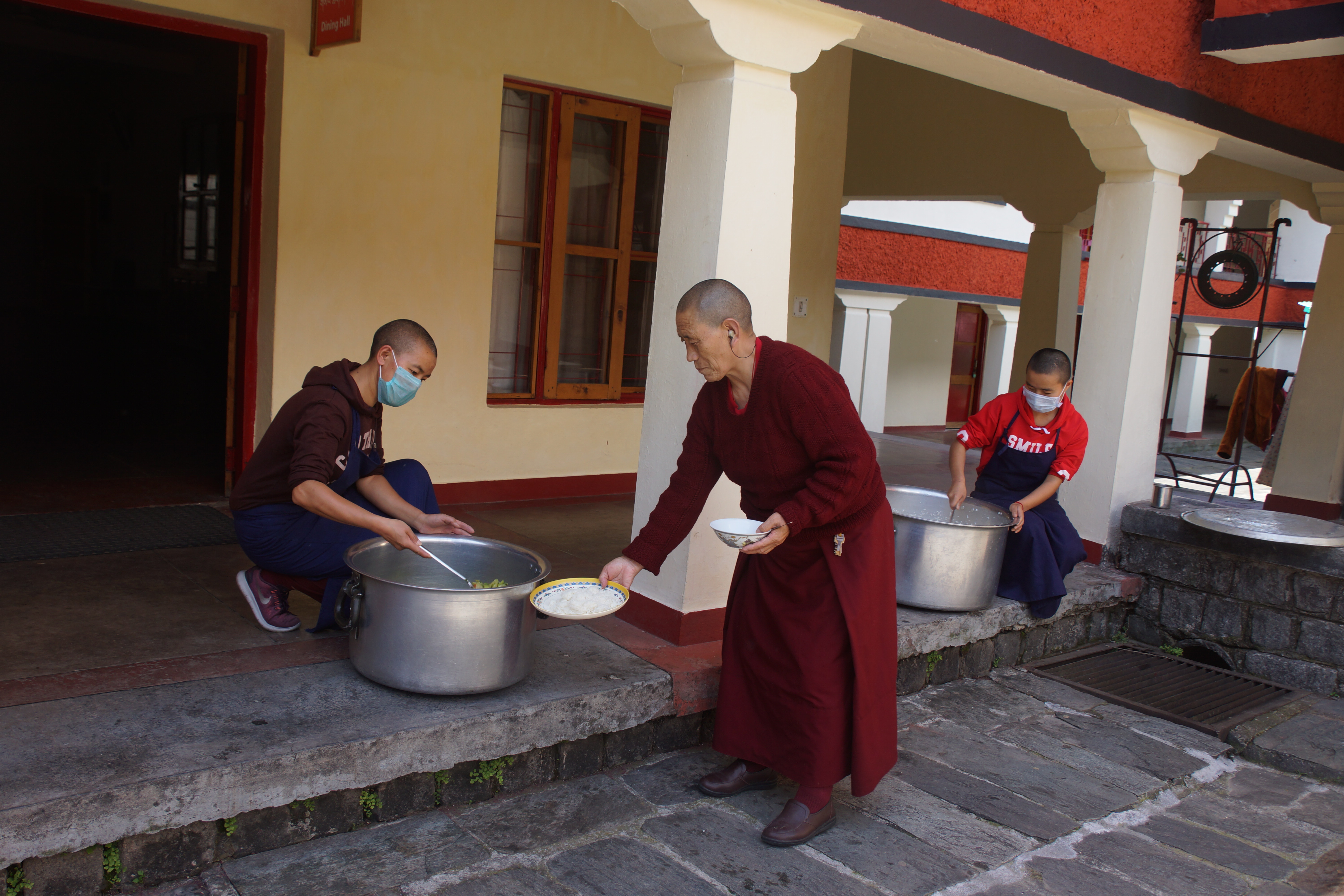
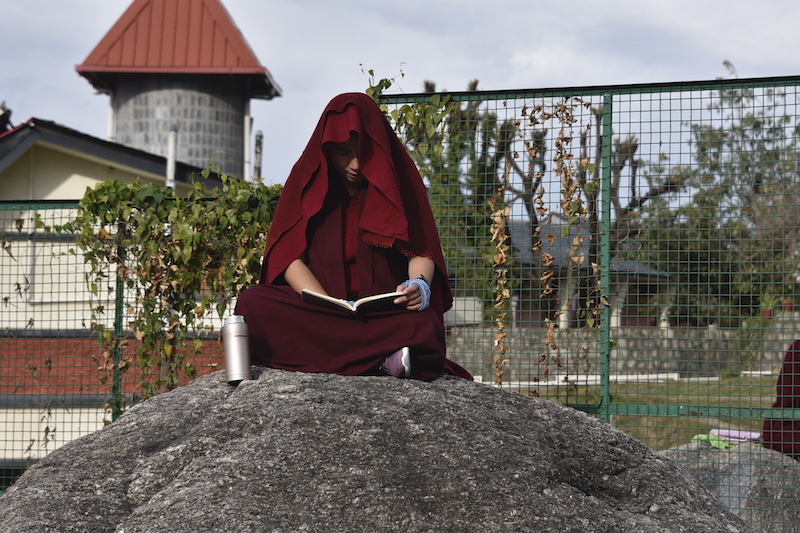
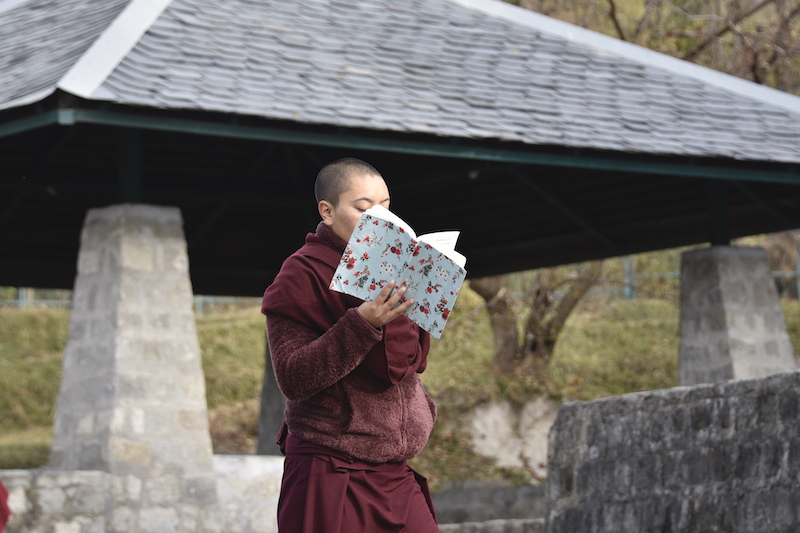
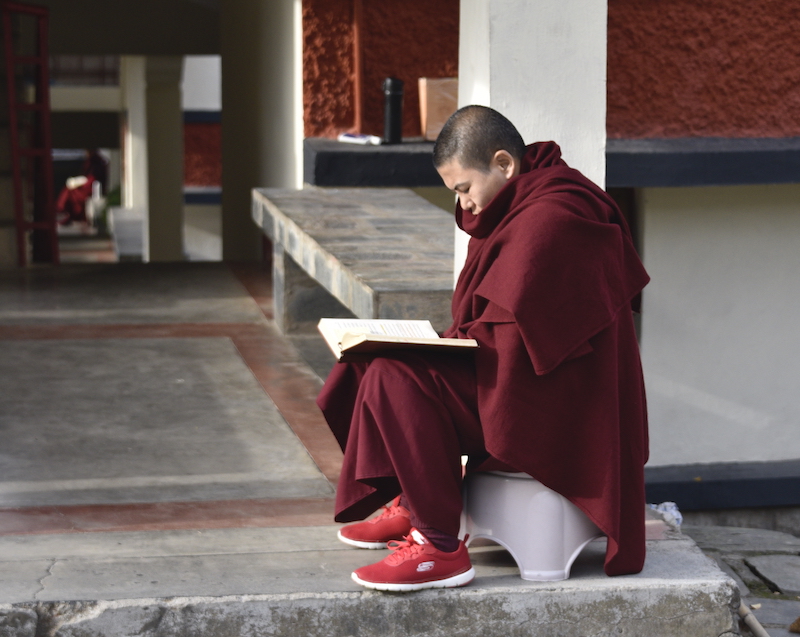
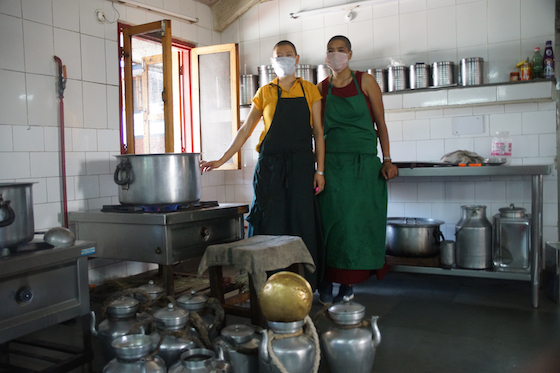
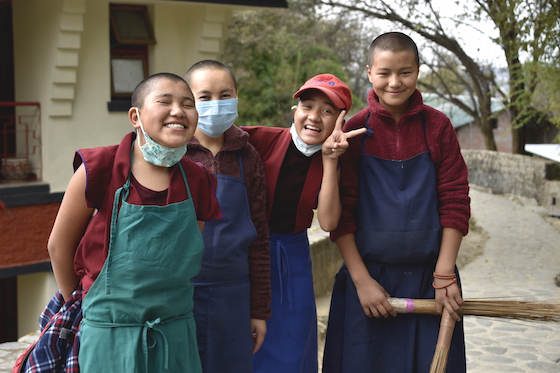
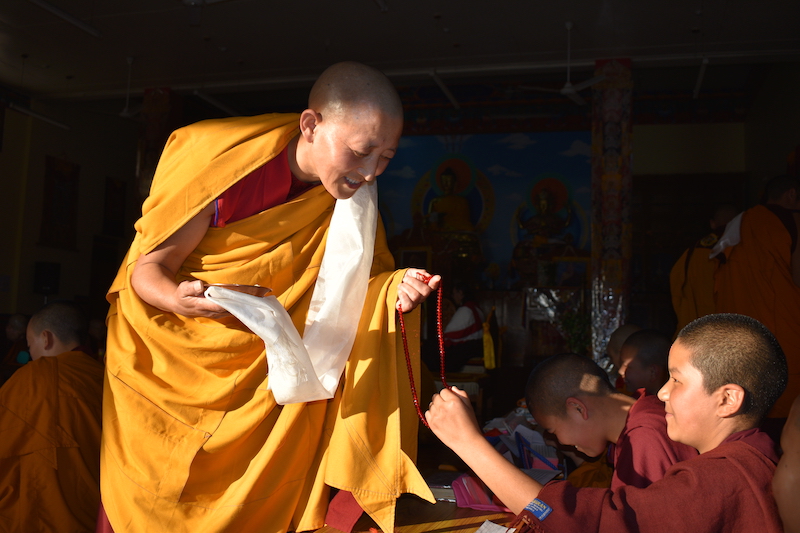



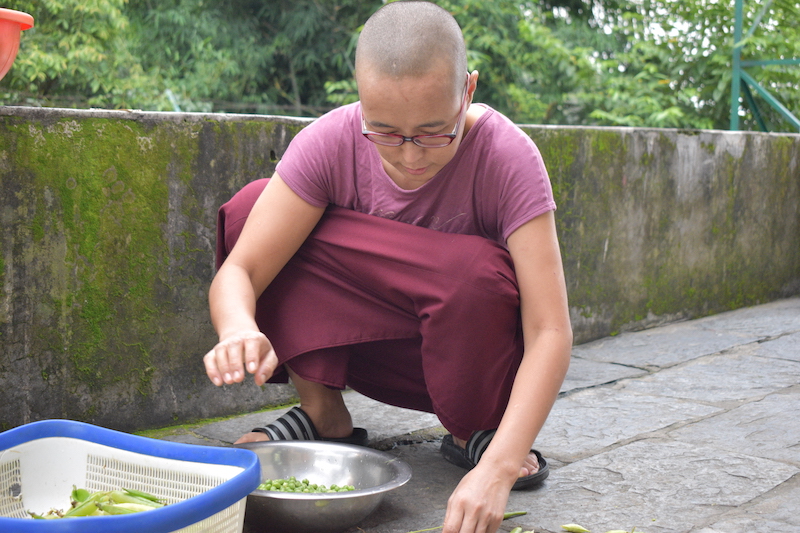



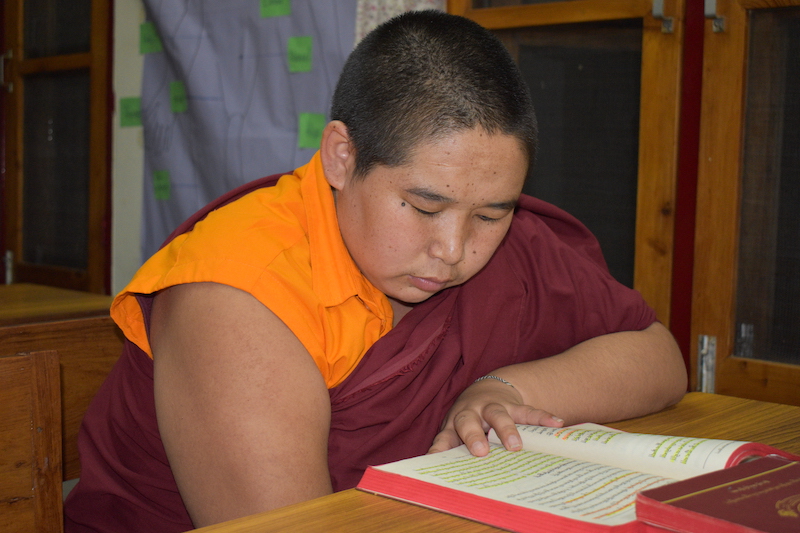
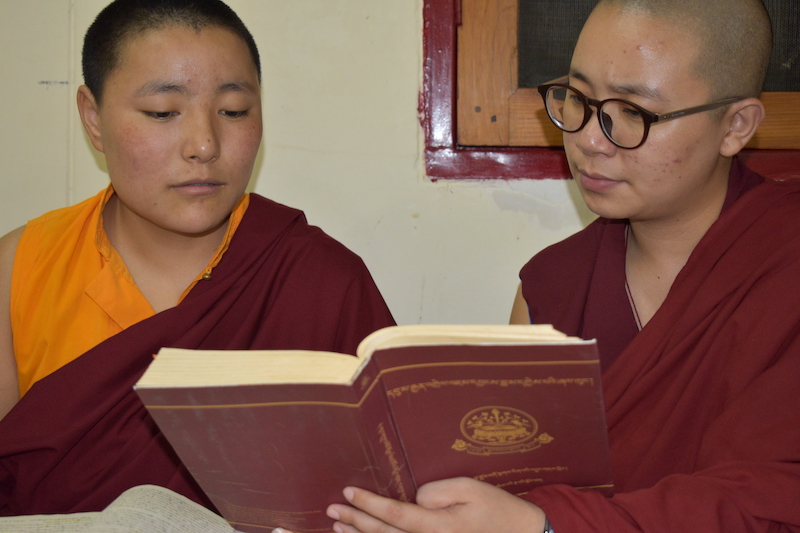

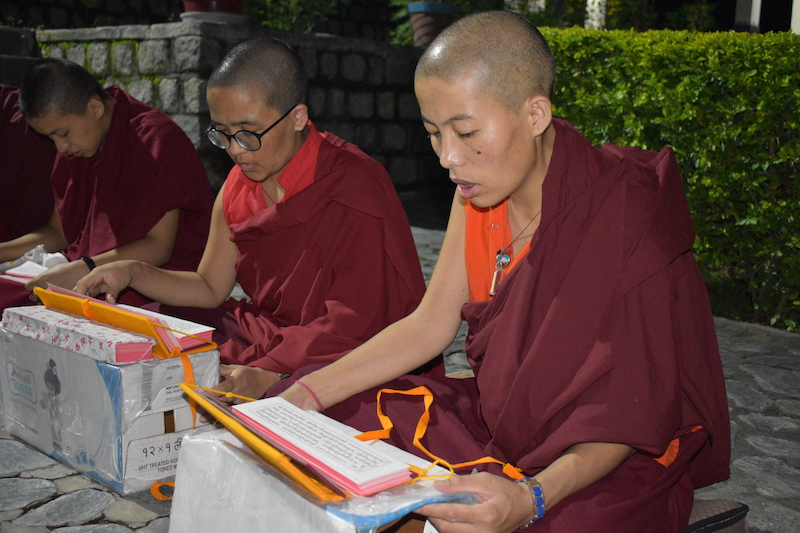
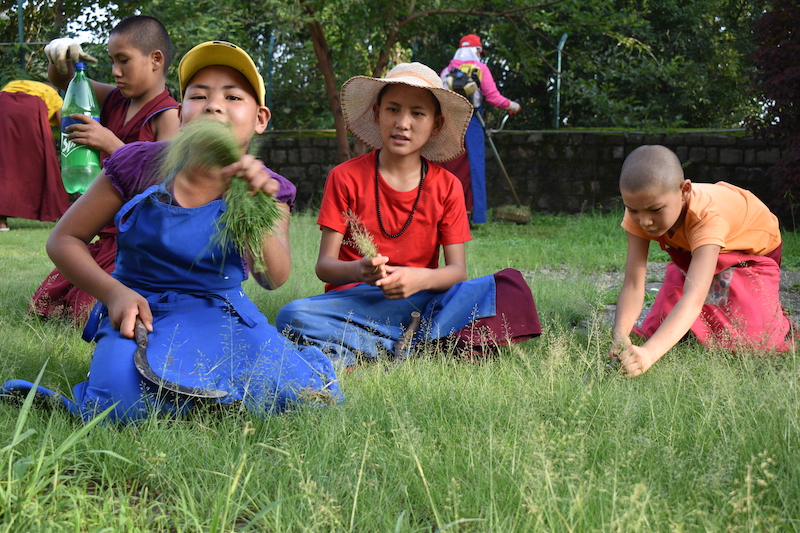
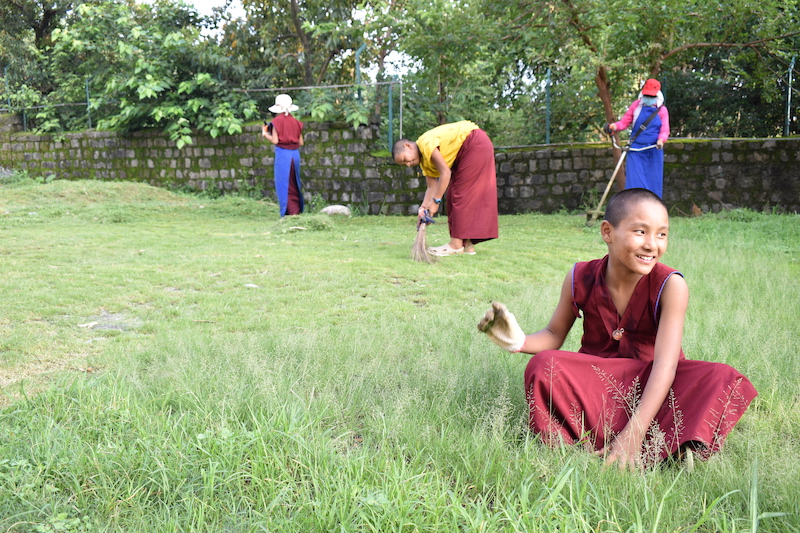

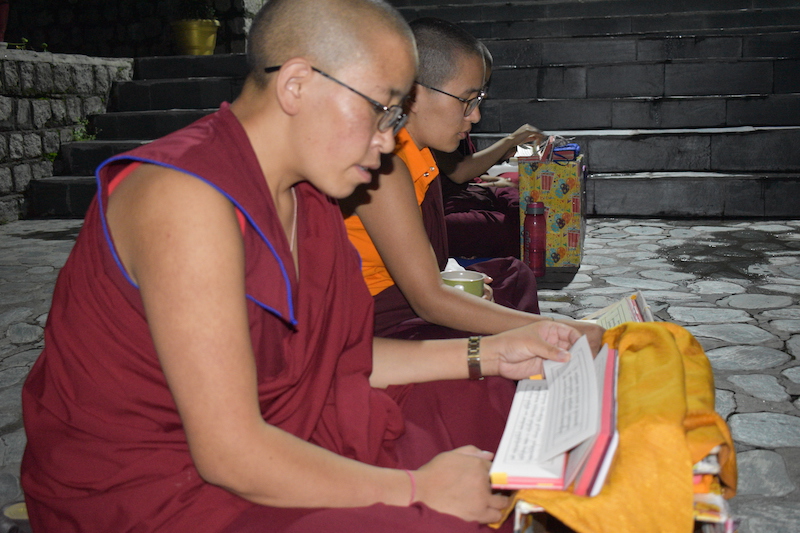
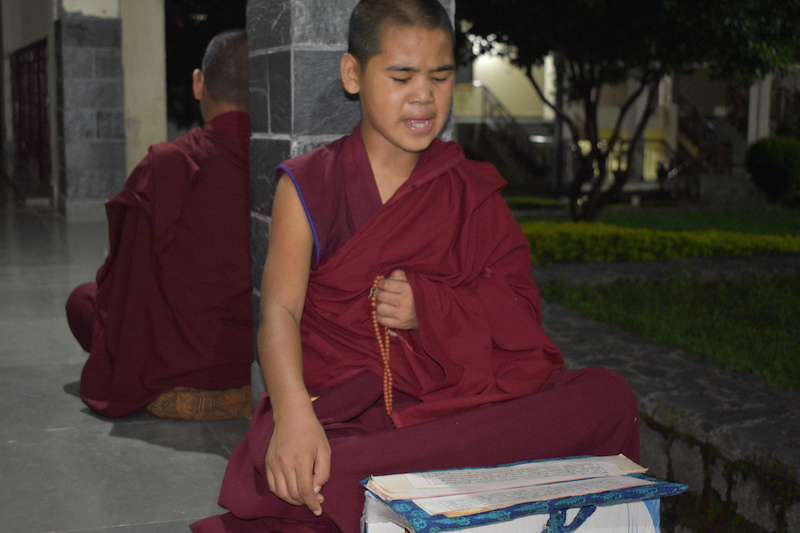
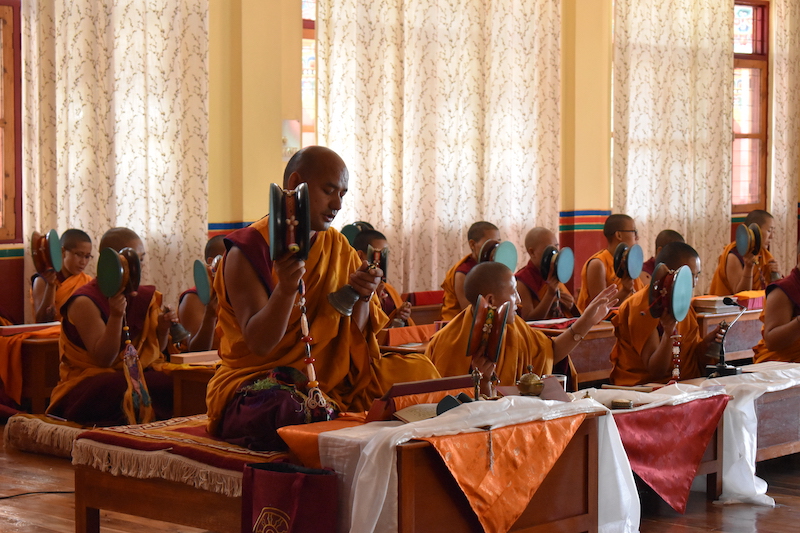
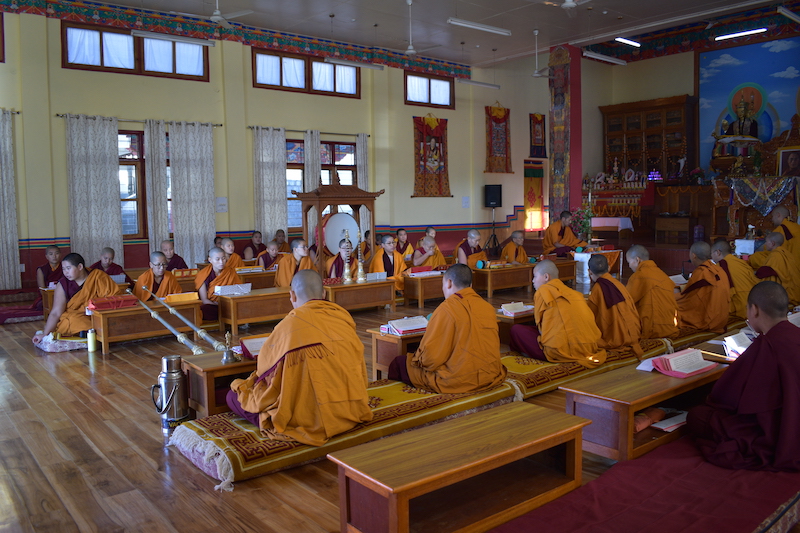
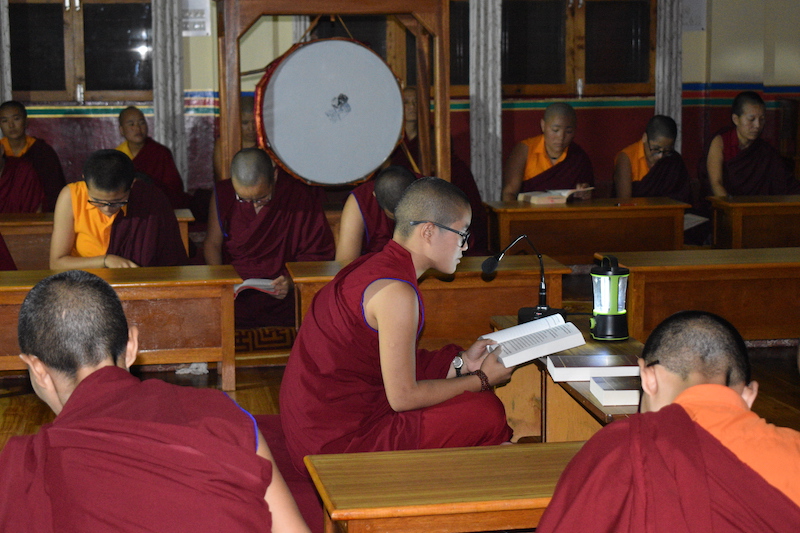
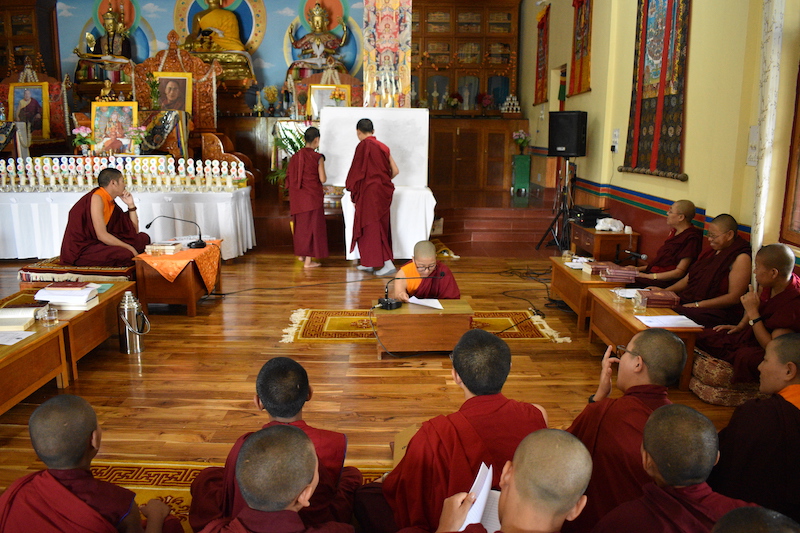
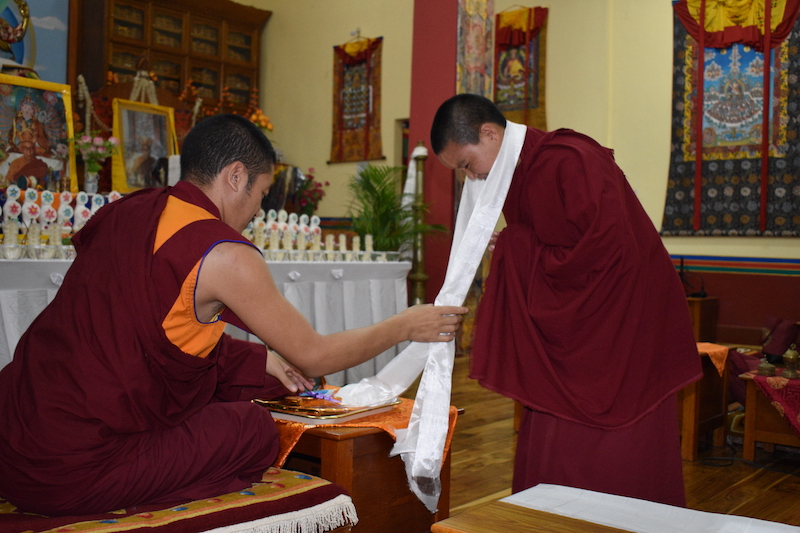
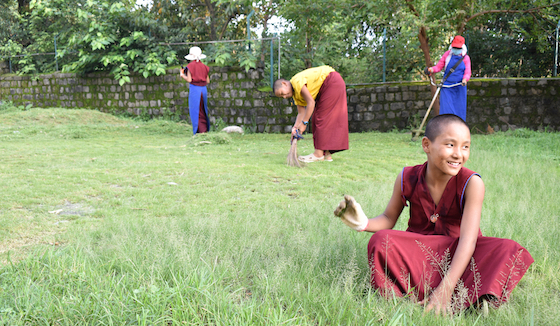 To prevent the disease from spreading inside the nunnery, we shut the gate to visitors and all the transactions for prayers were done online. We had the basic necessities delivered to our gate so that we could stay isolated. We also barred the staff and students from leaving the nunnery grounds until and unless it was urgent. Weekend outings for the students were cancelled and the staff were strictly instructed not to leave the premises without permission.
To prevent the disease from spreading inside the nunnery, we shut the gate to visitors and all the transactions for prayers were done online. We had the basic necessities delivered to our gate so that we could stay isolated. We also barred the staff and students from leaving the nunnery grounds until and unless it was urgent. Weekend outings for the students were cancelled and the staff were strictly instructed not to leave the premises without permission.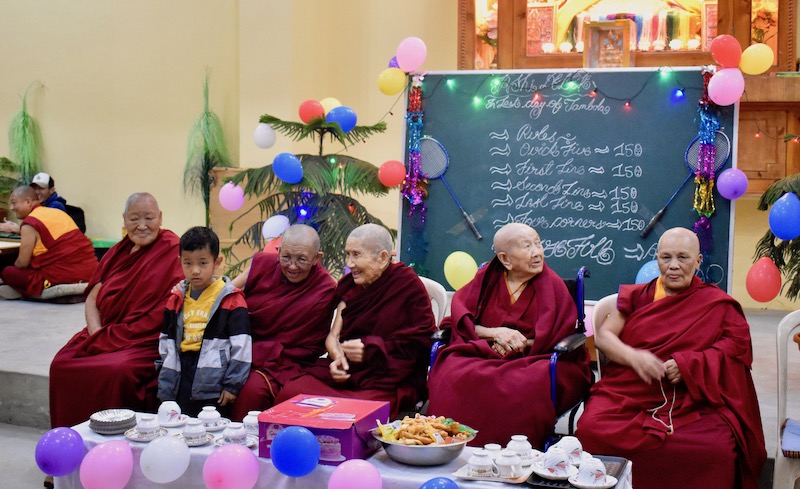
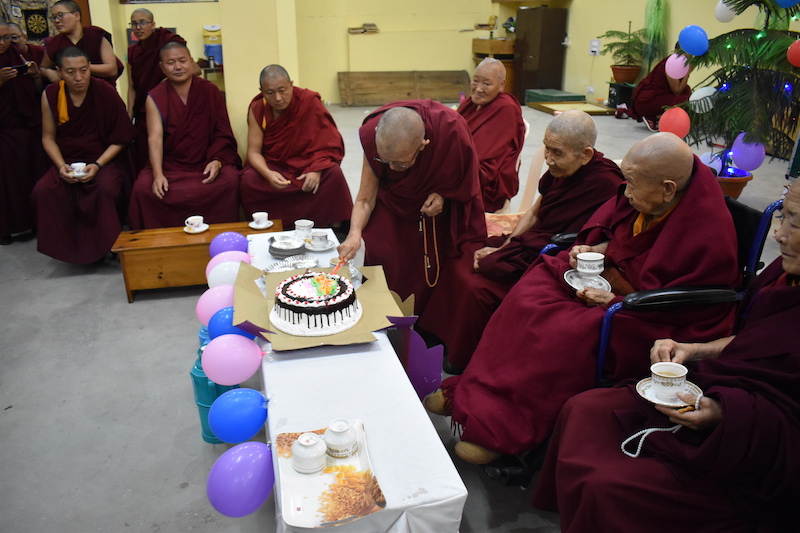
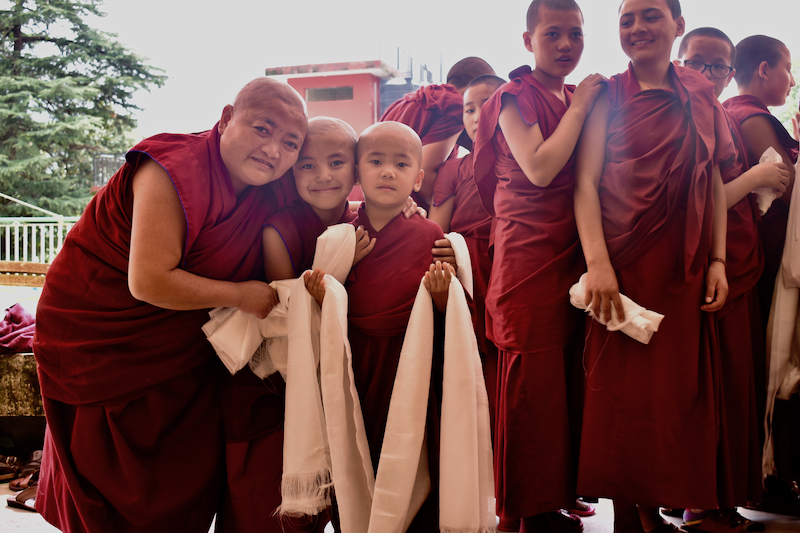

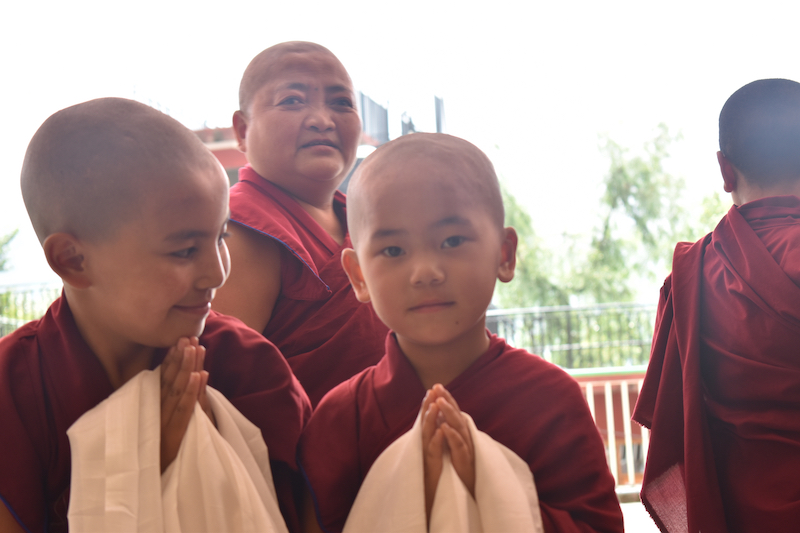
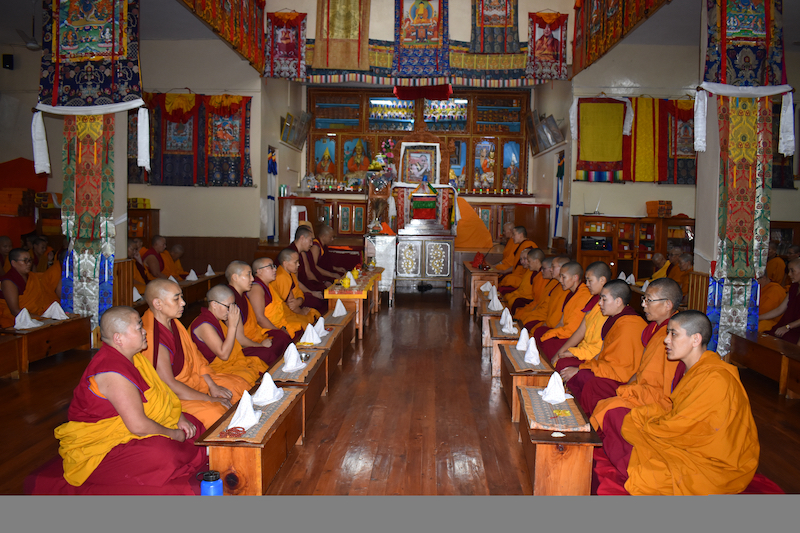
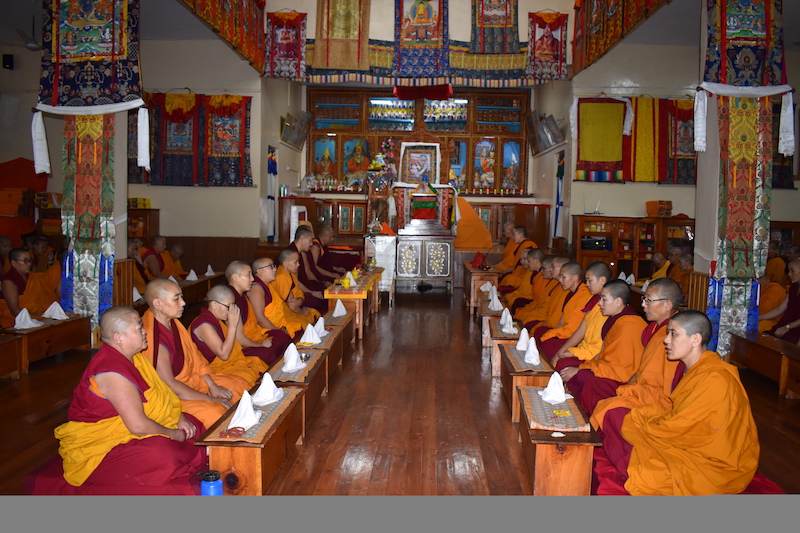
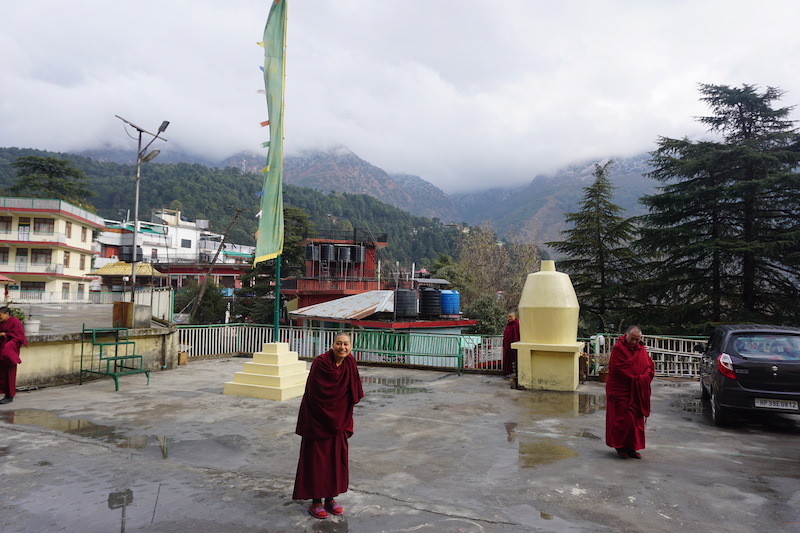
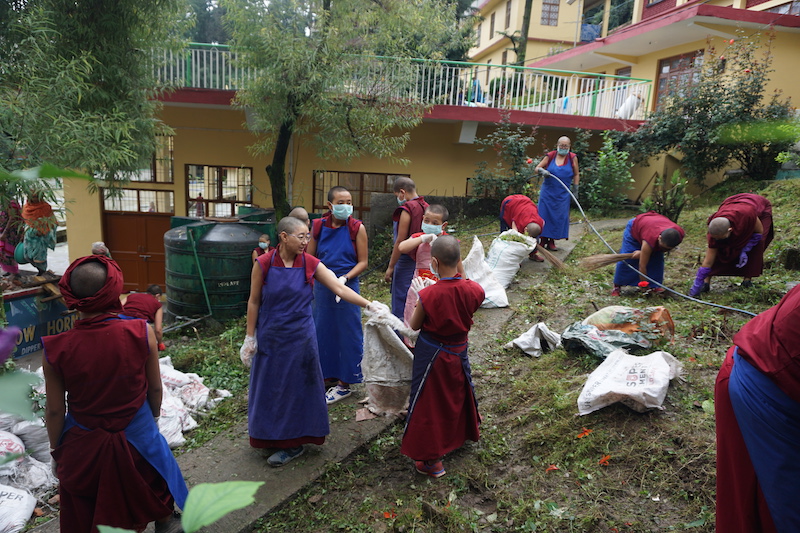
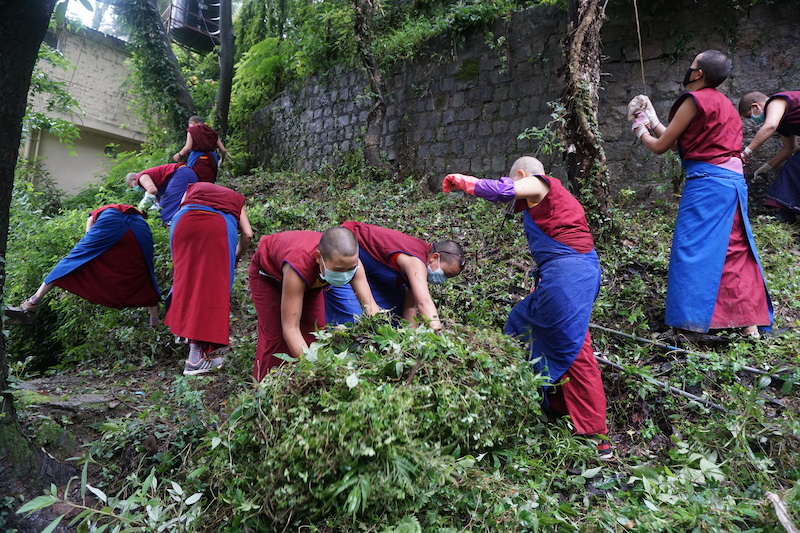
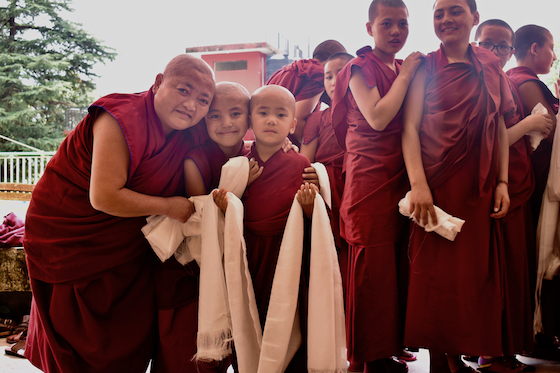











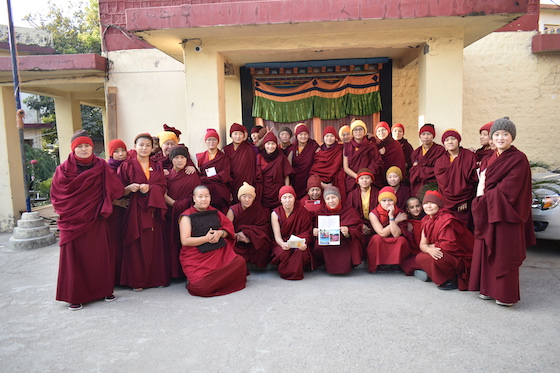
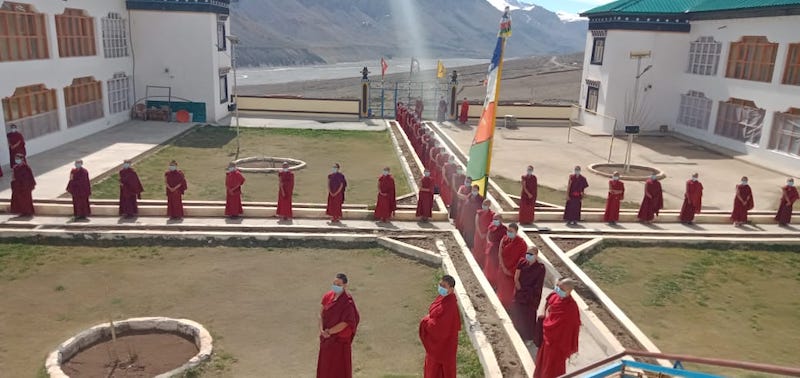
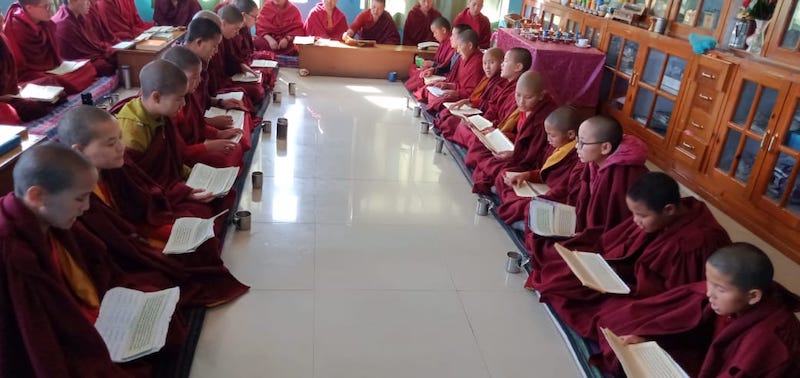
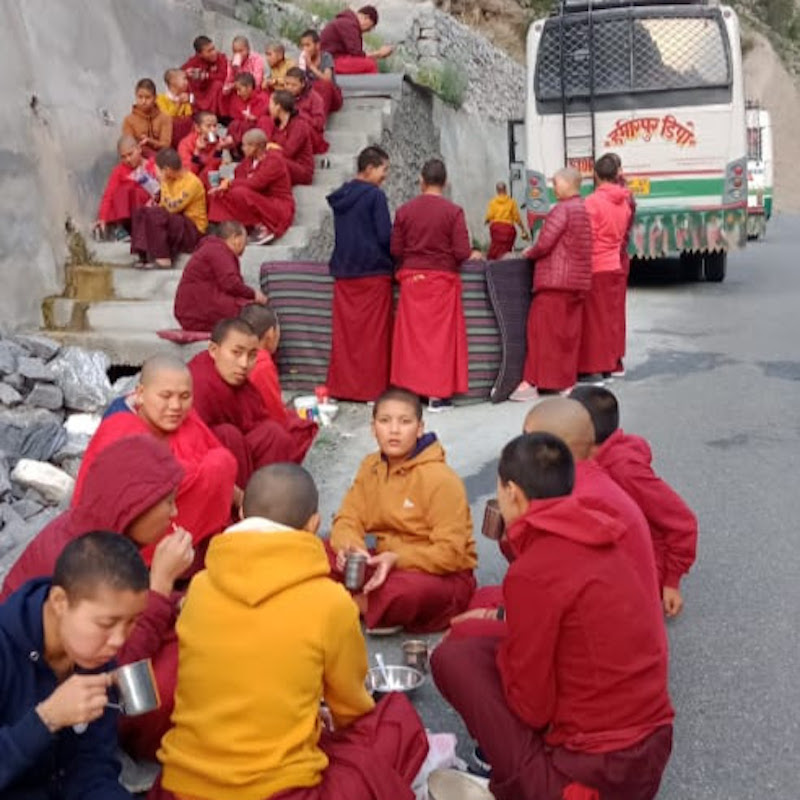
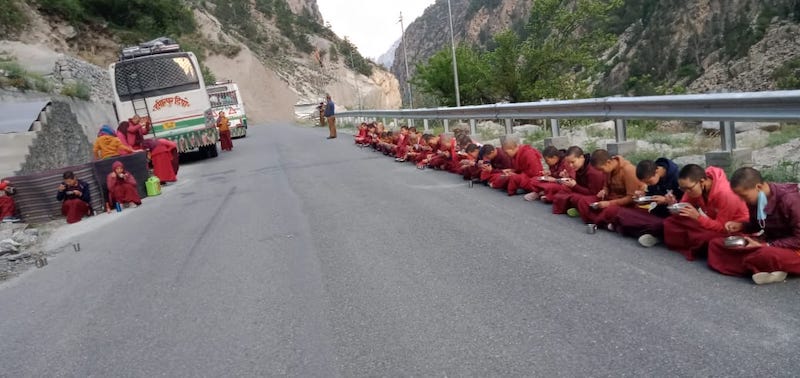
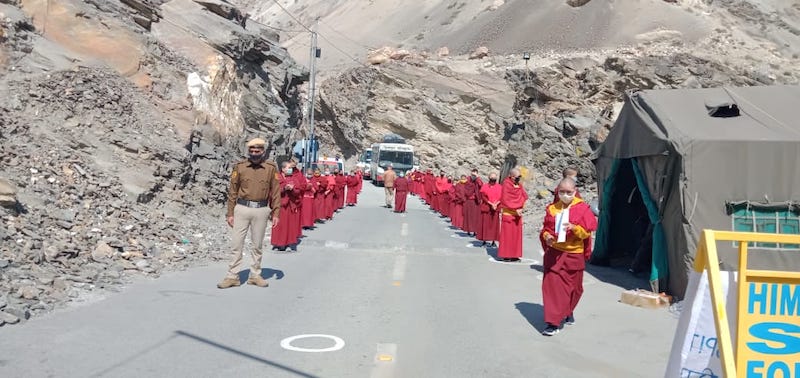
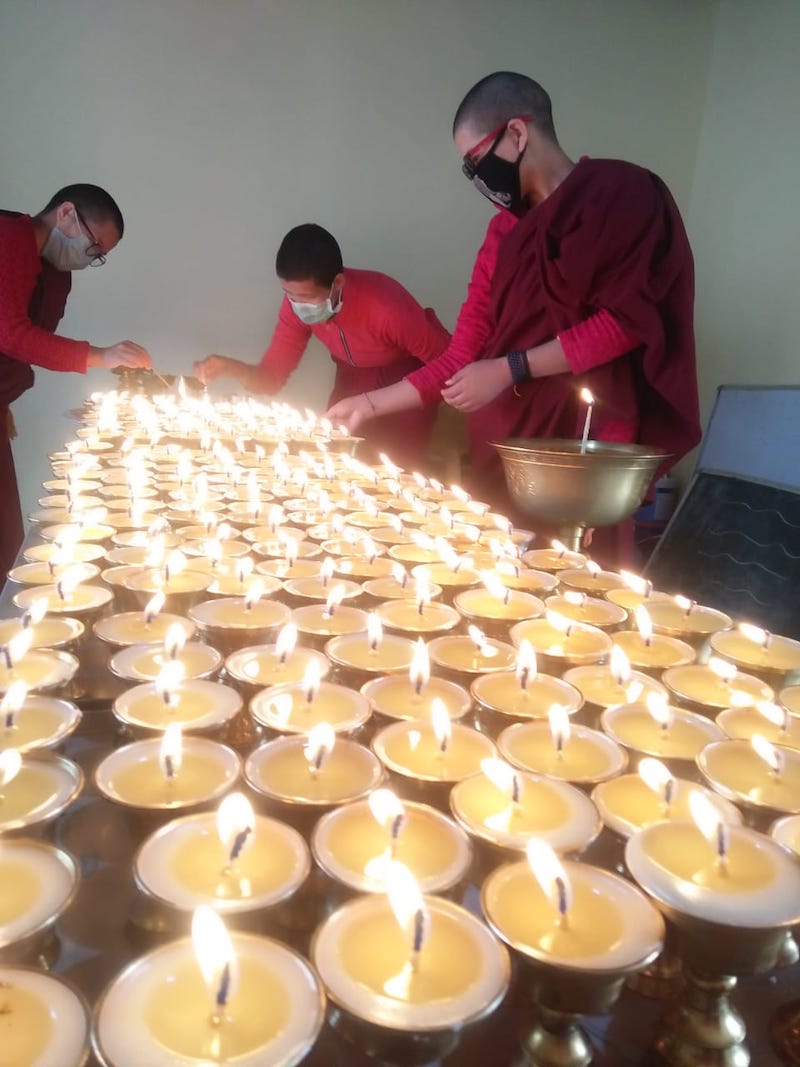
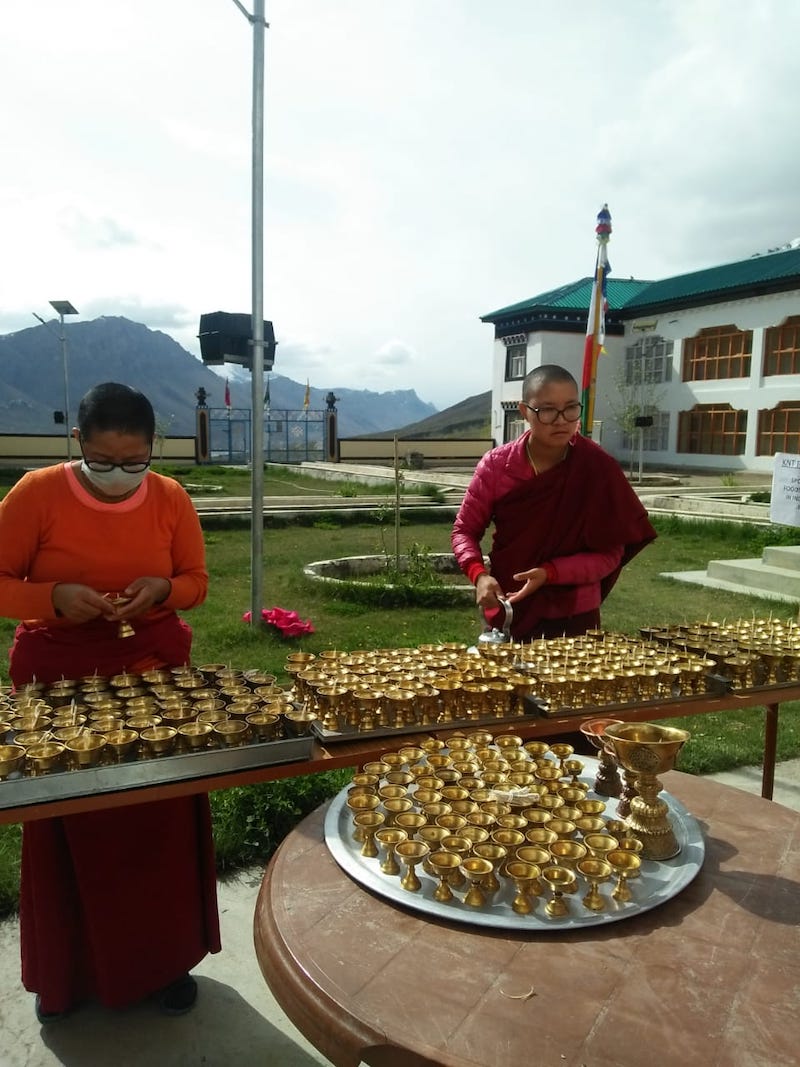
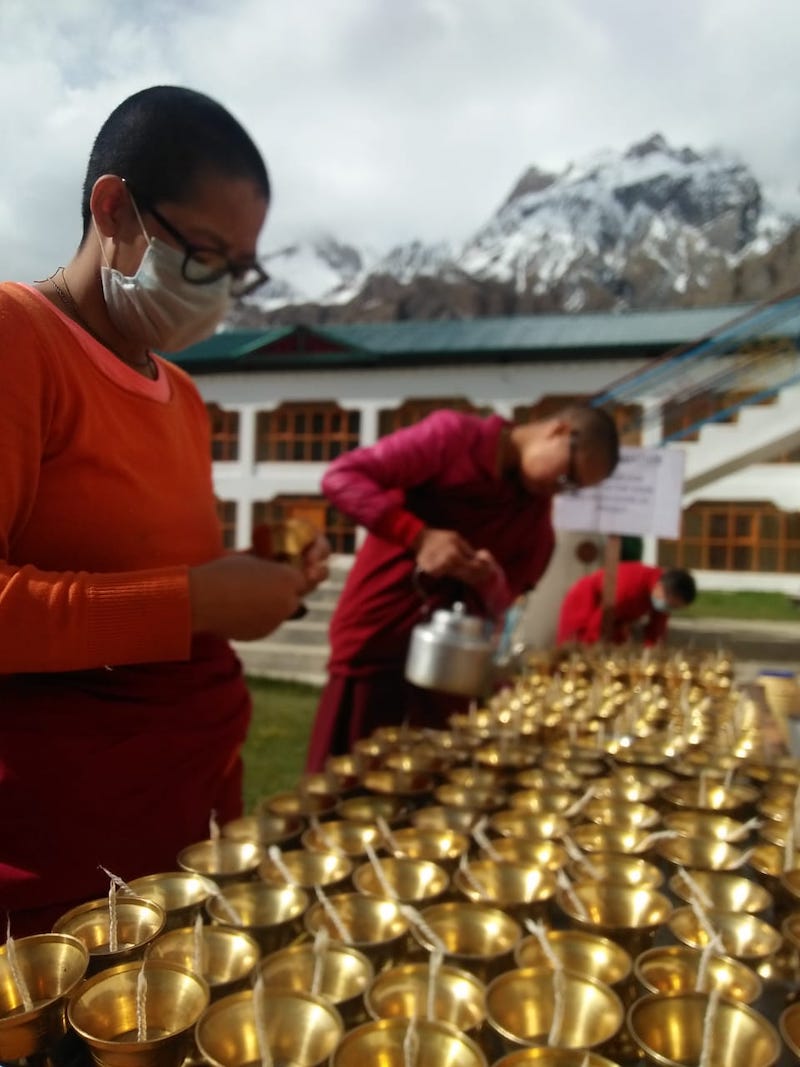
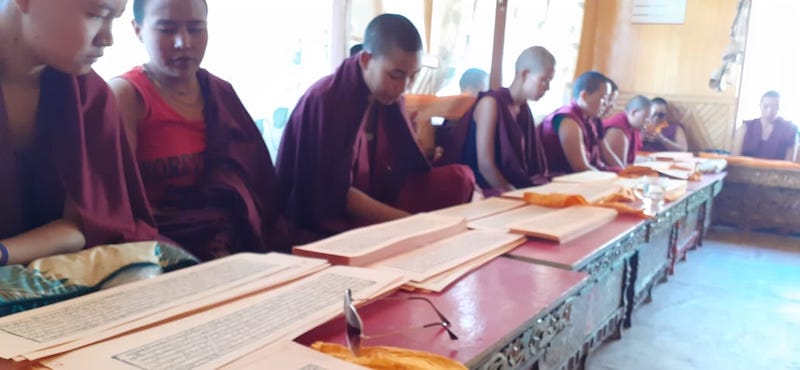
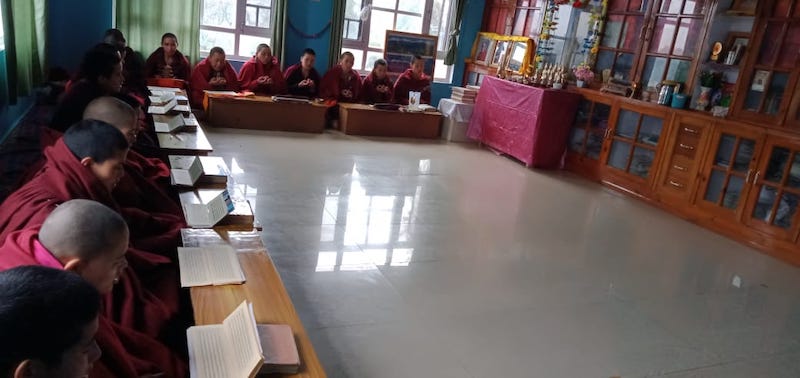
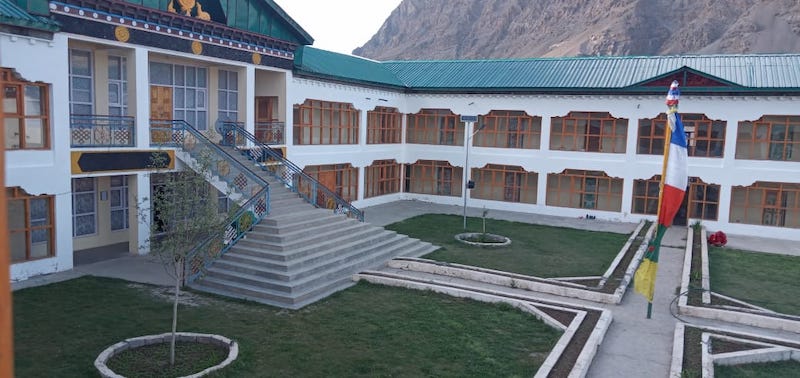
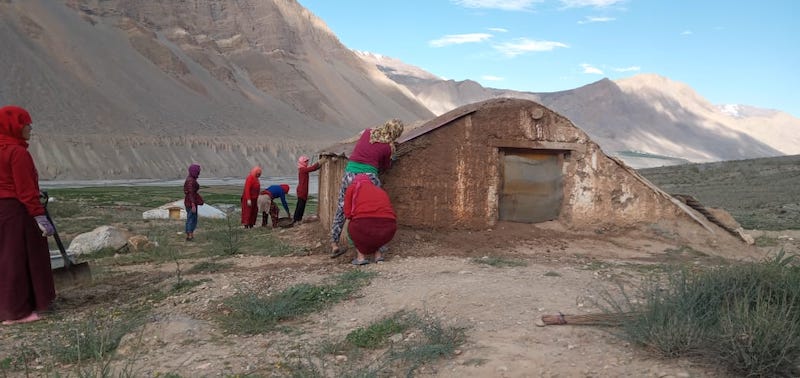
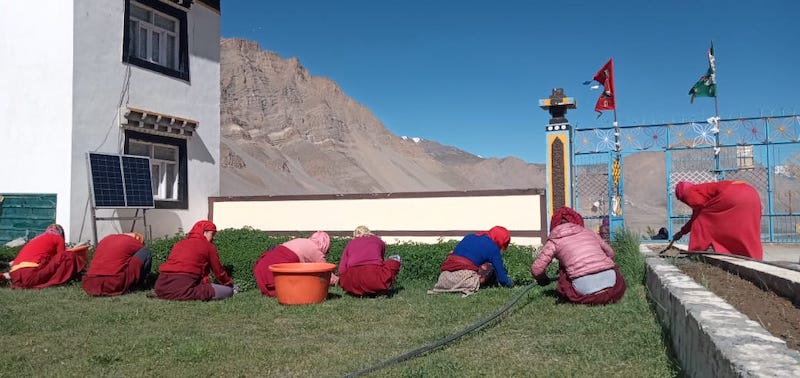
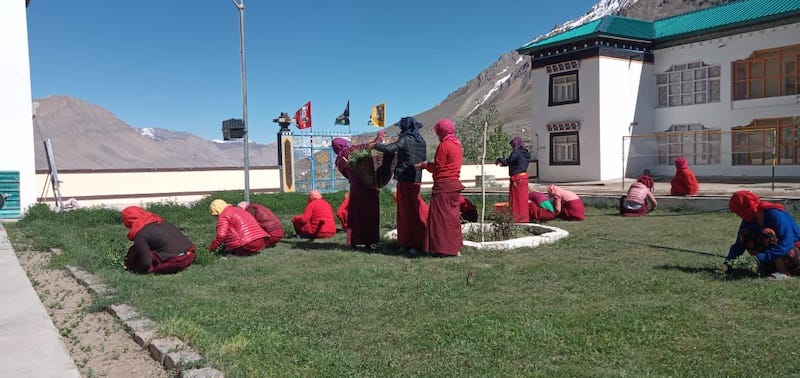
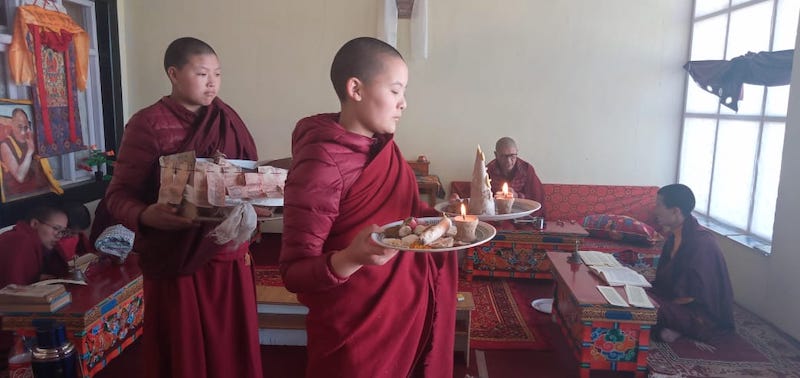
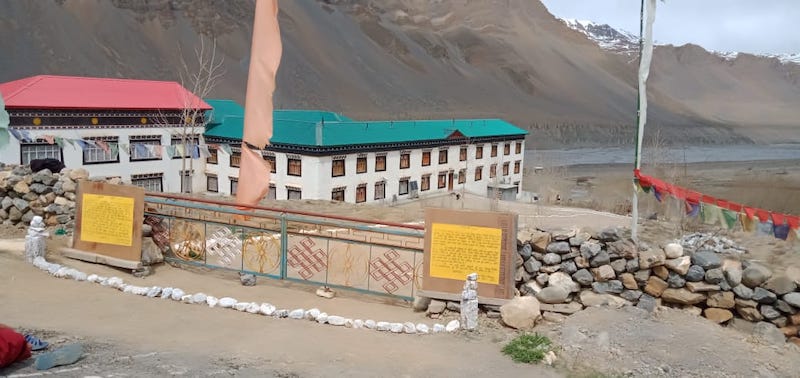
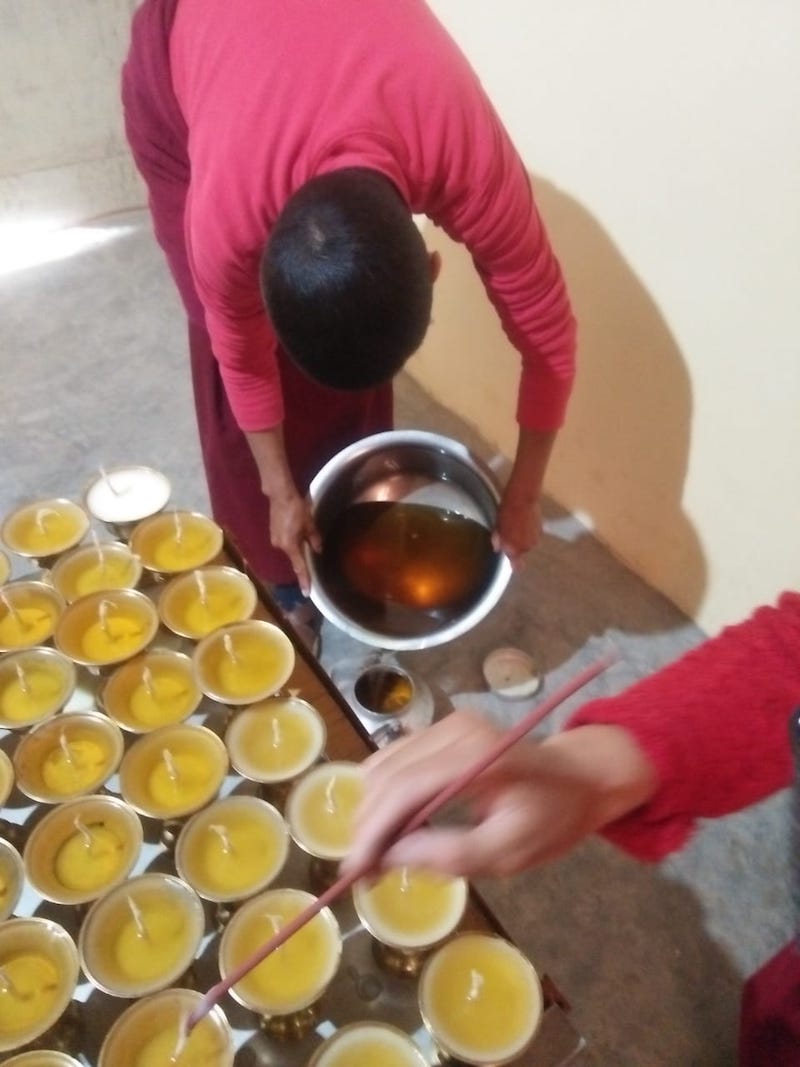
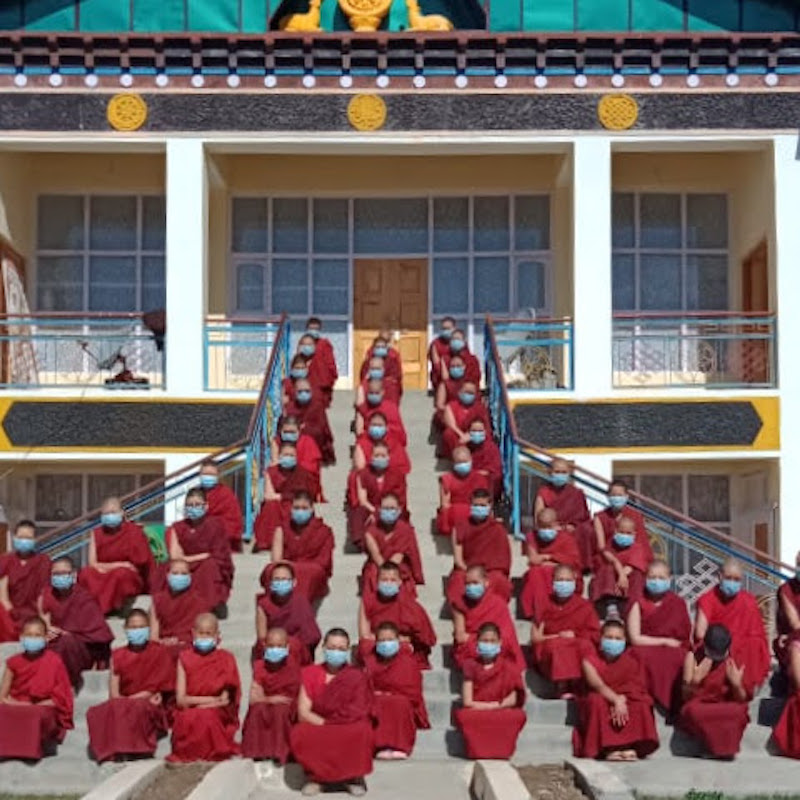
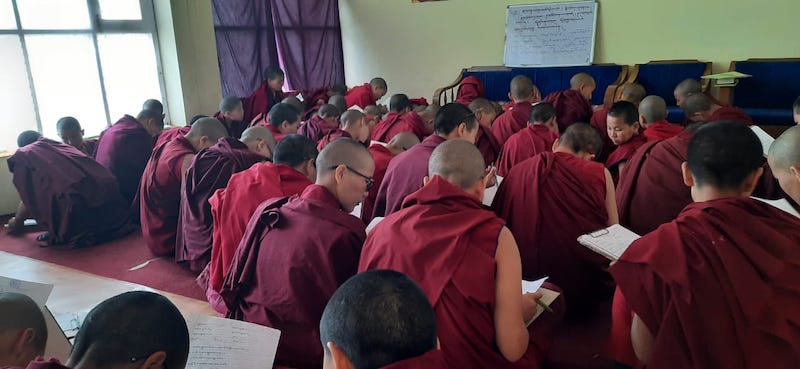
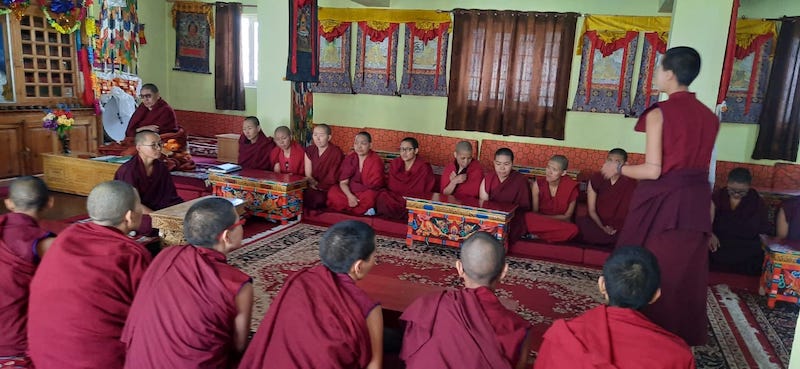
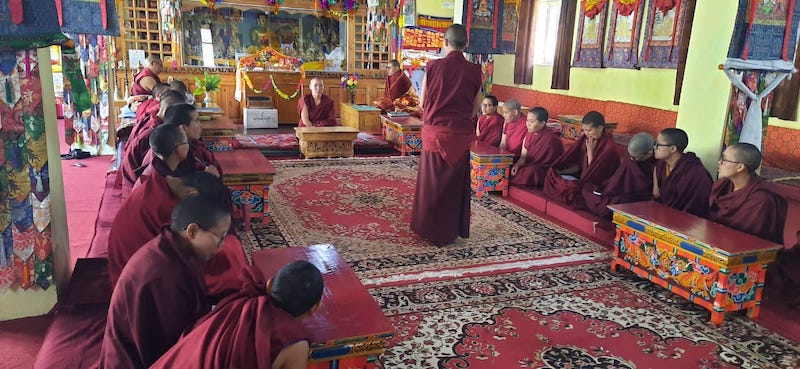
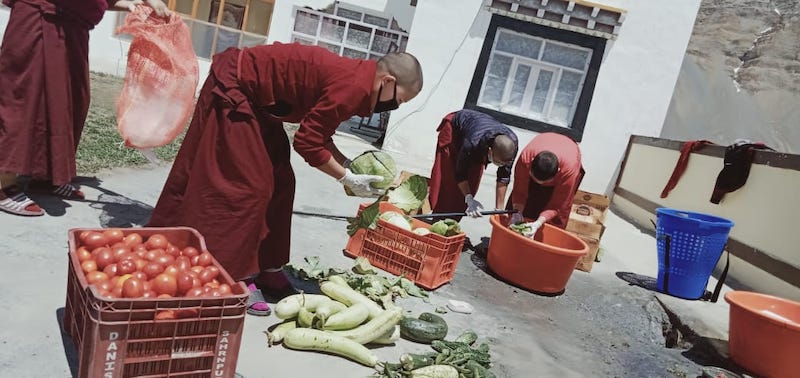
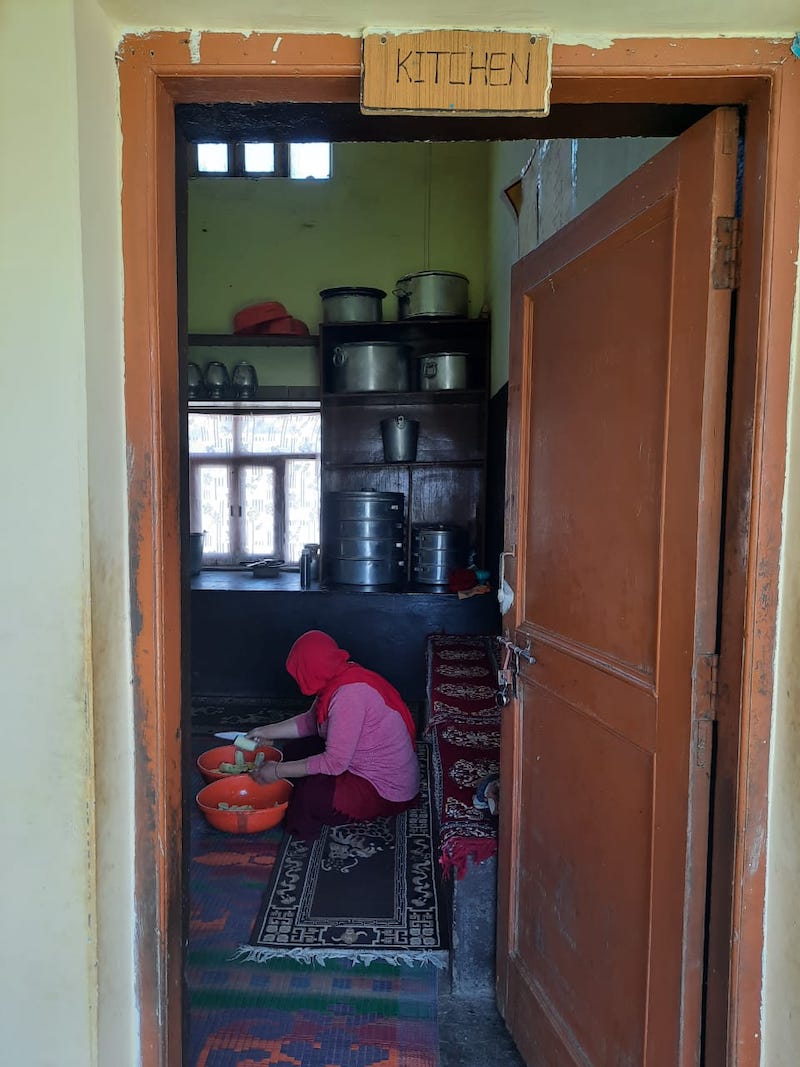
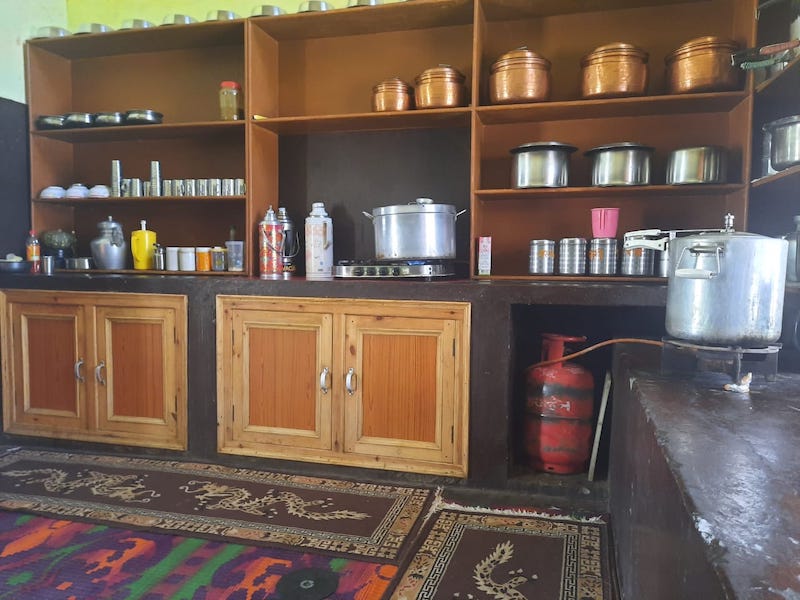
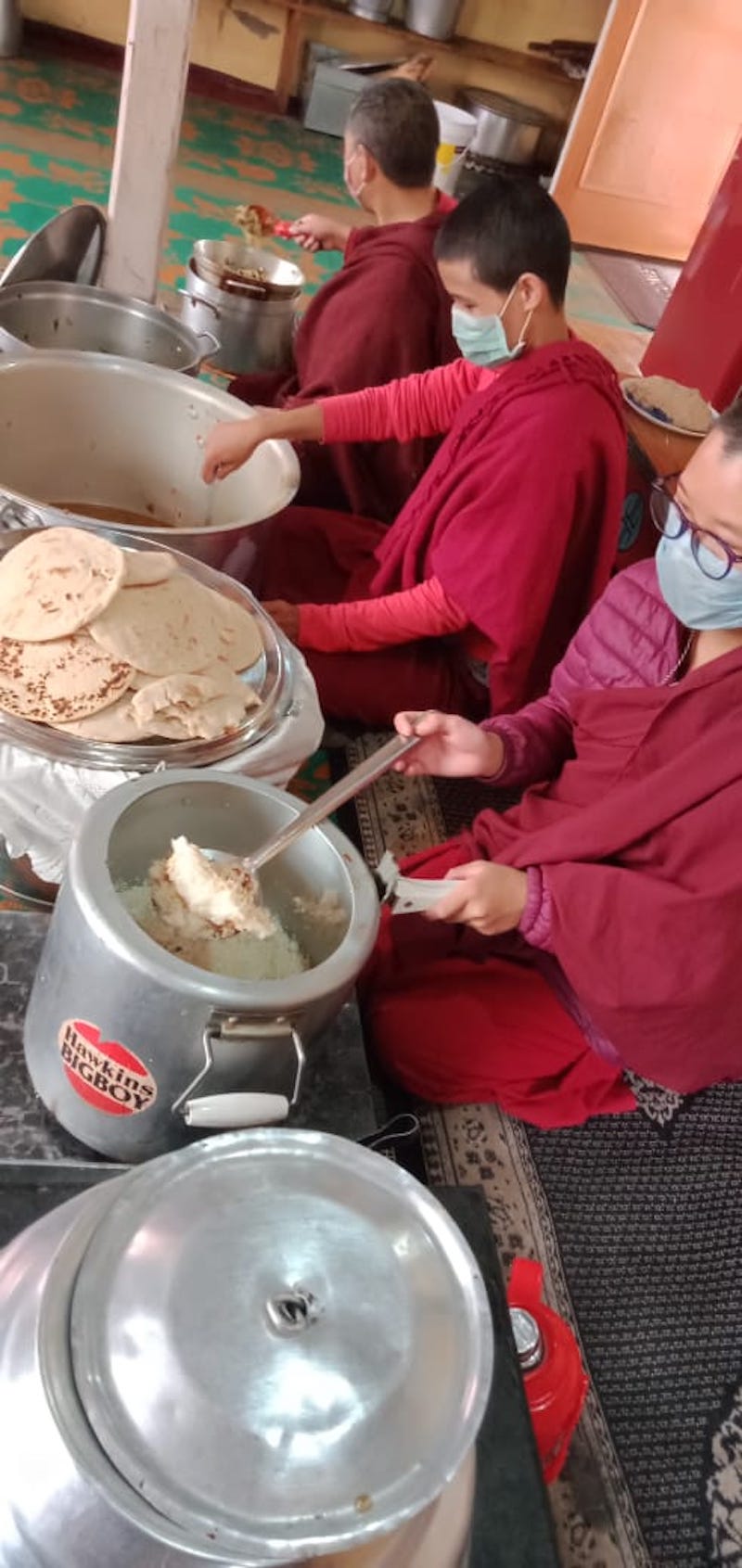
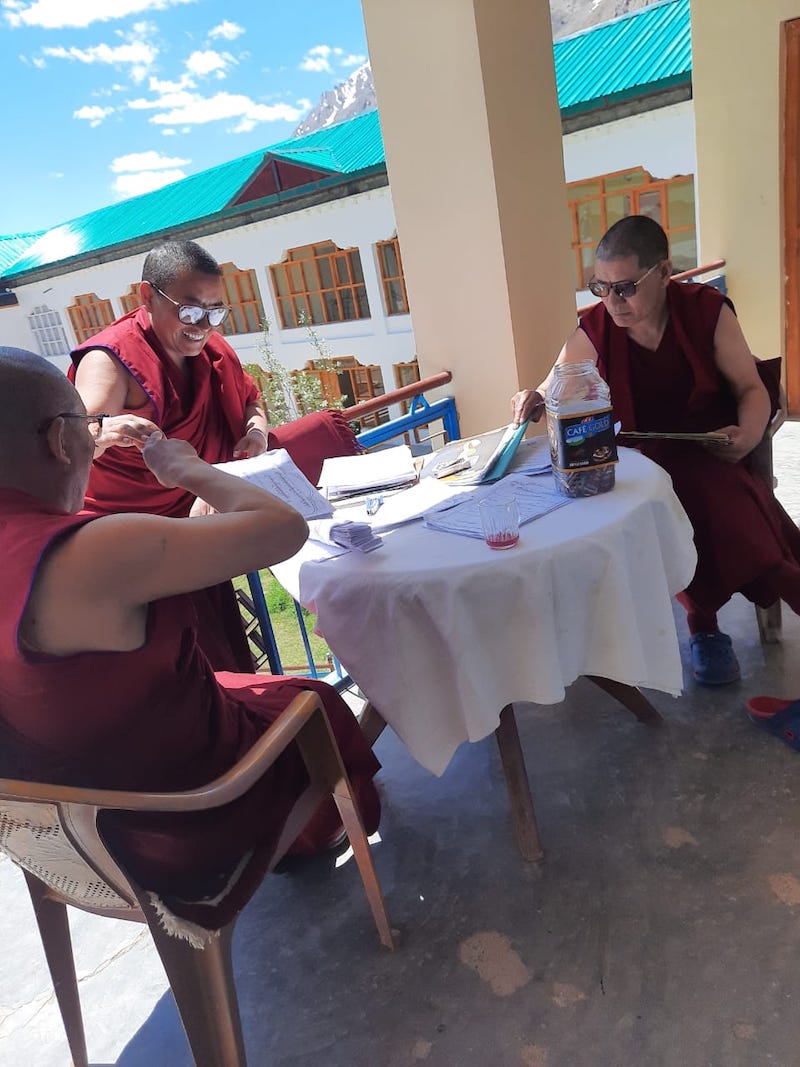
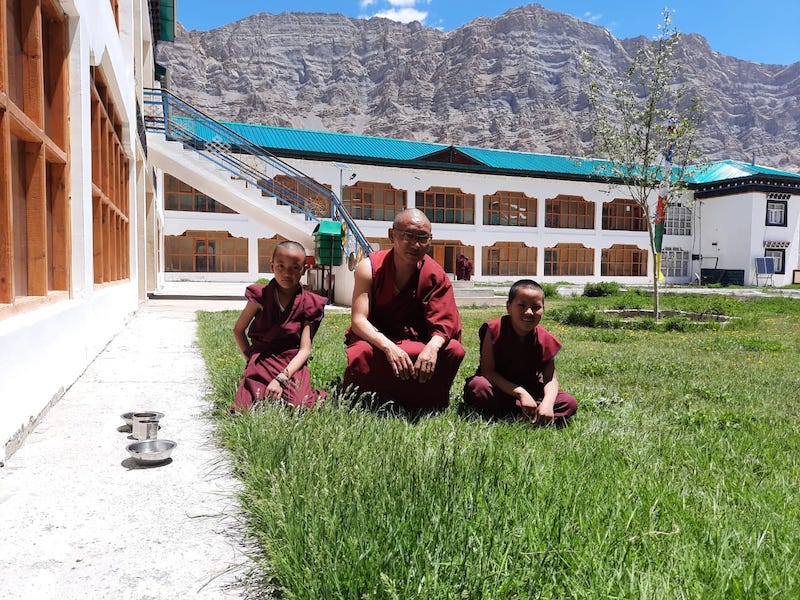
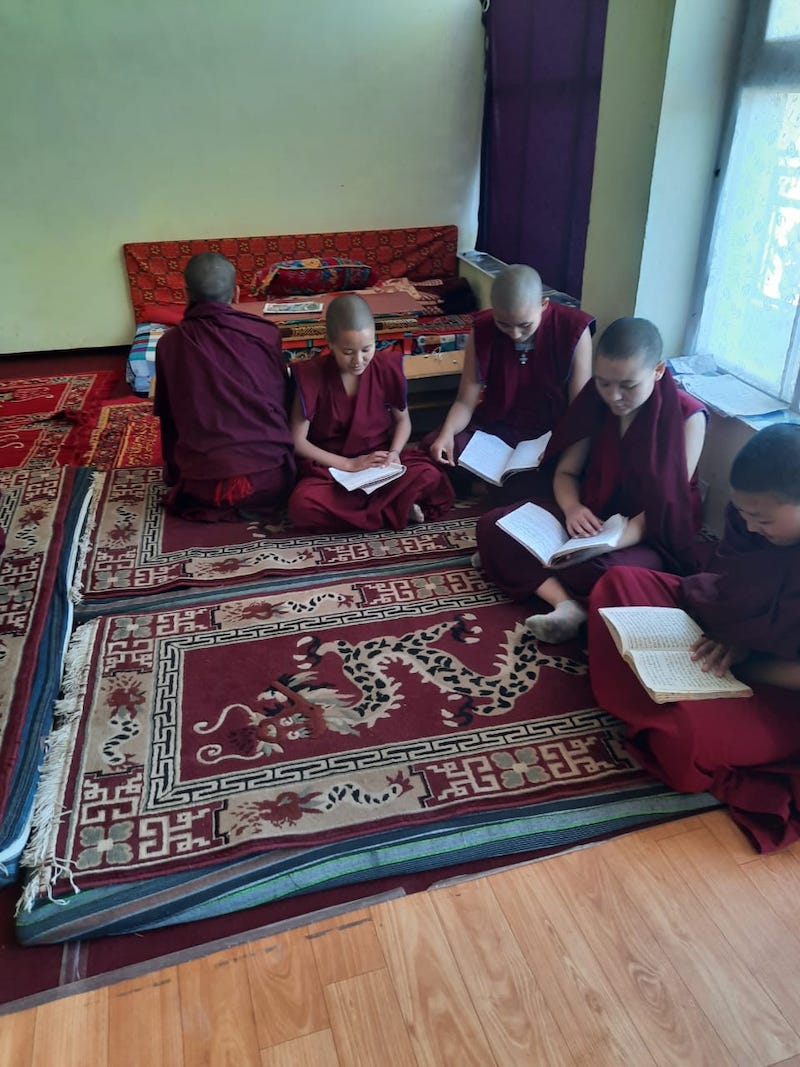
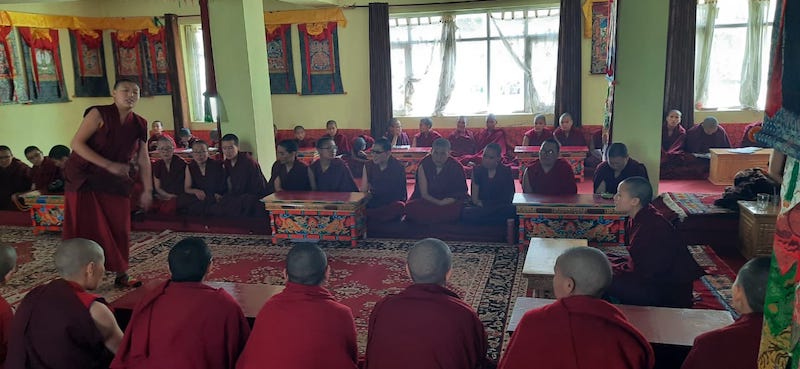
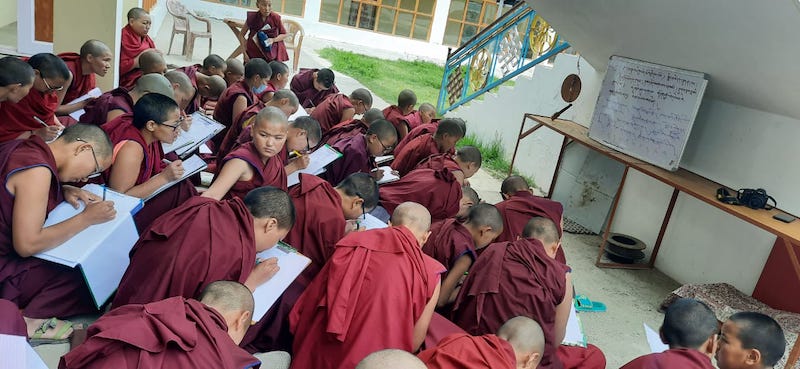
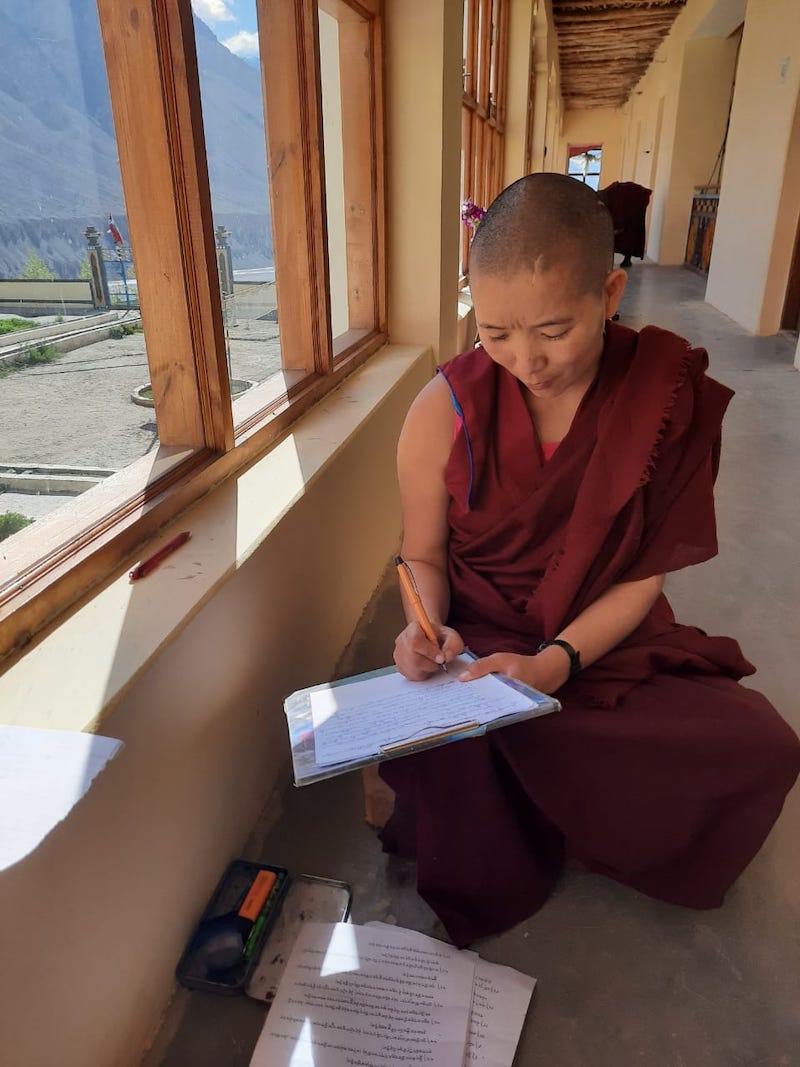
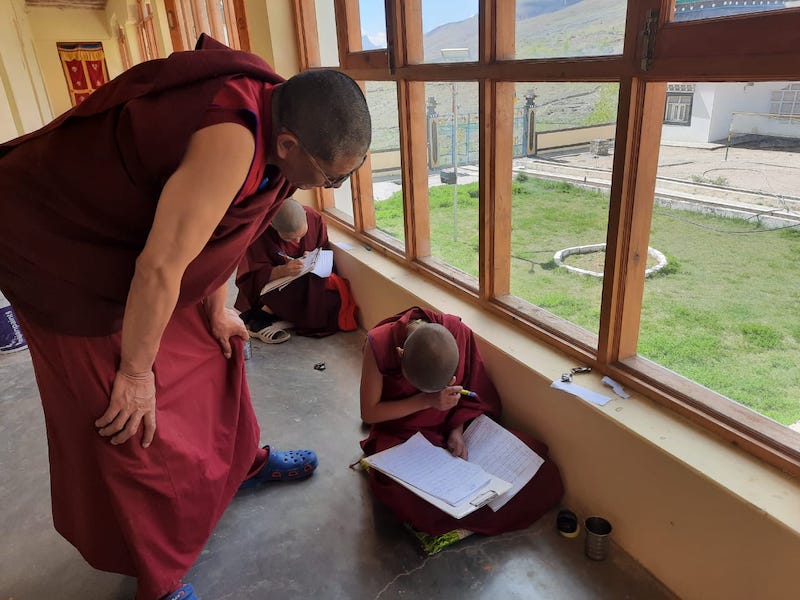
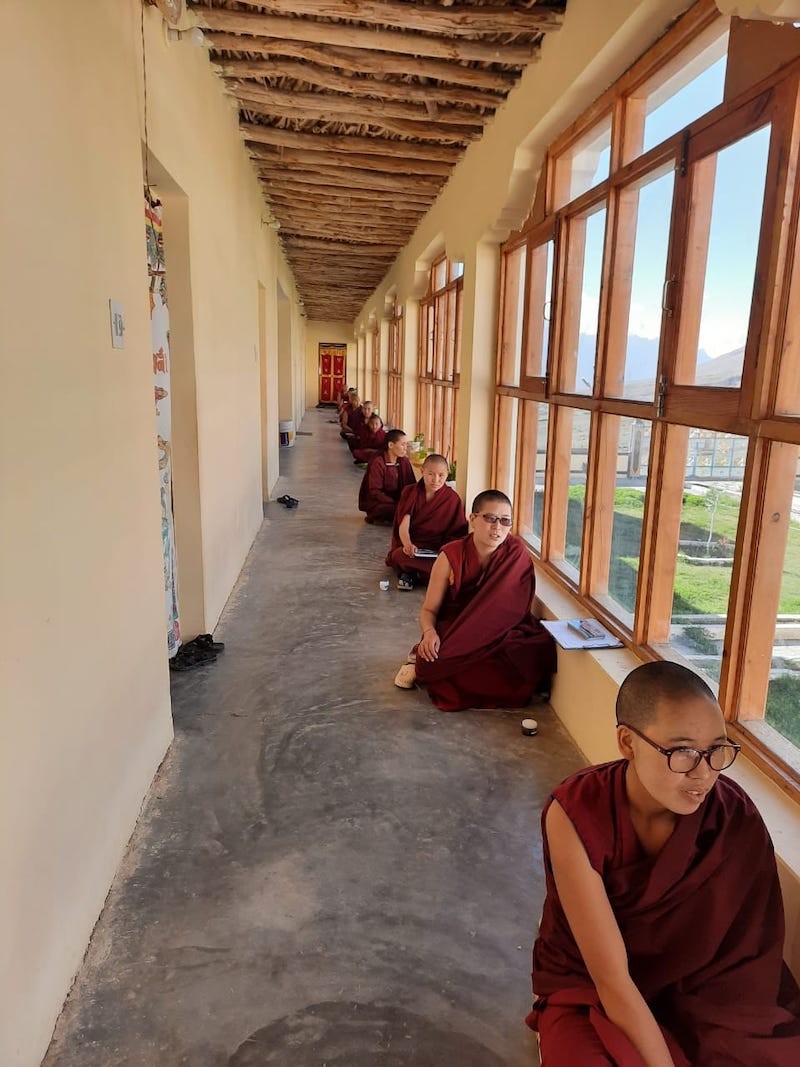
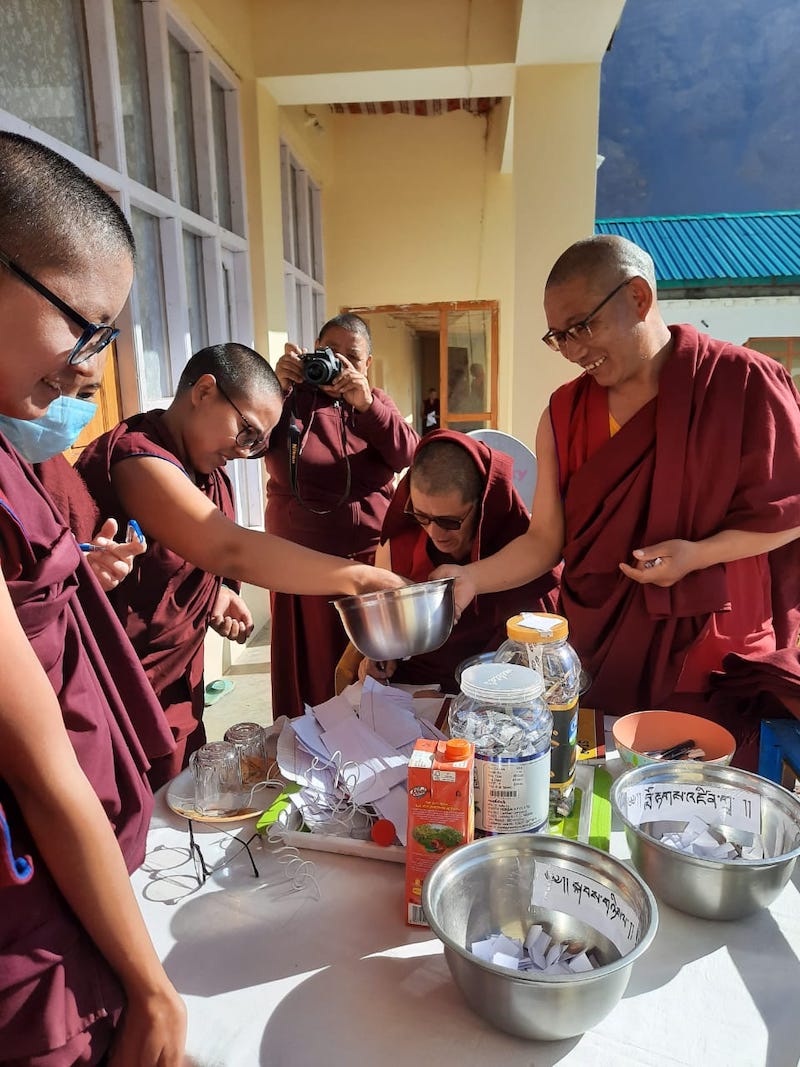
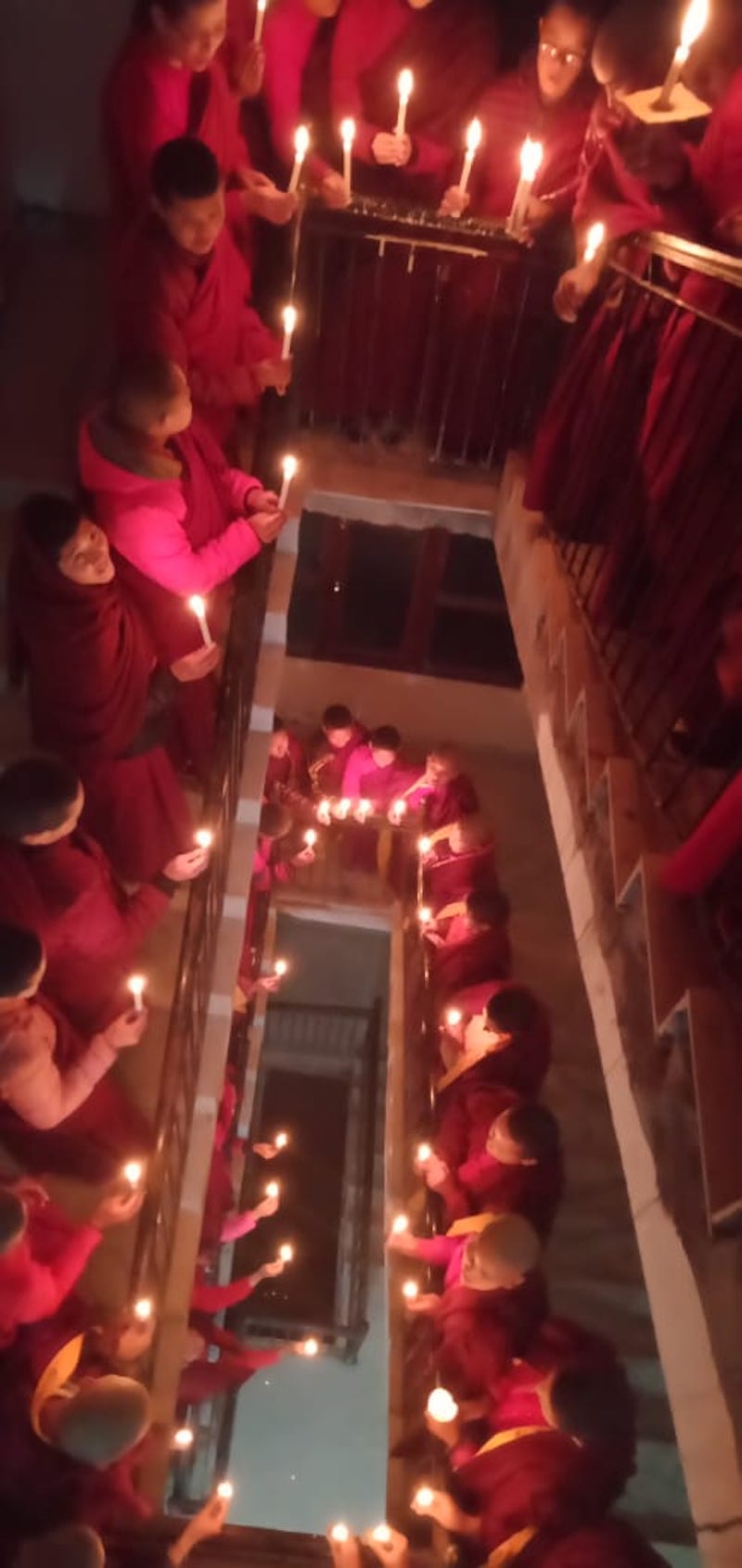
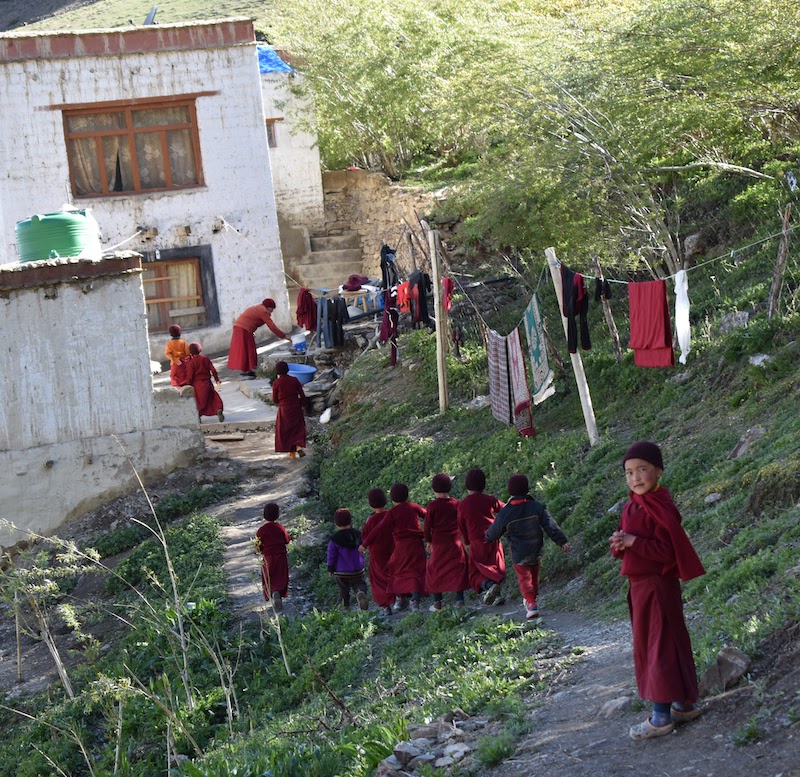
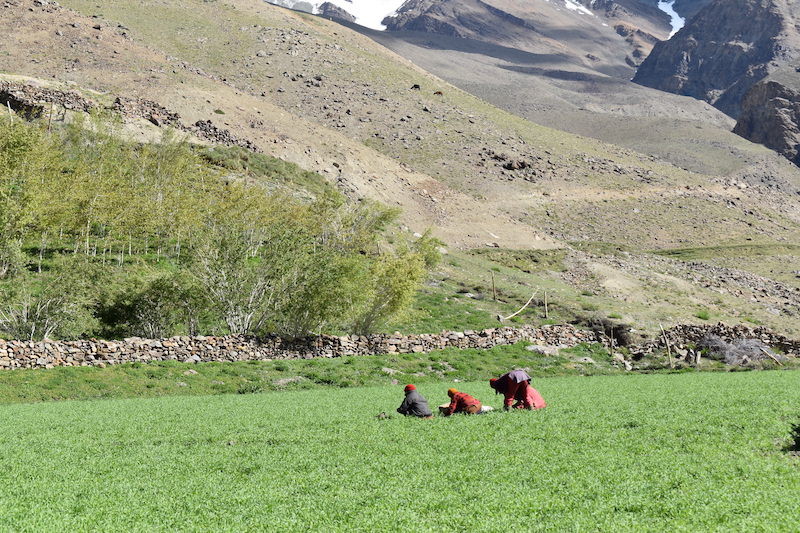
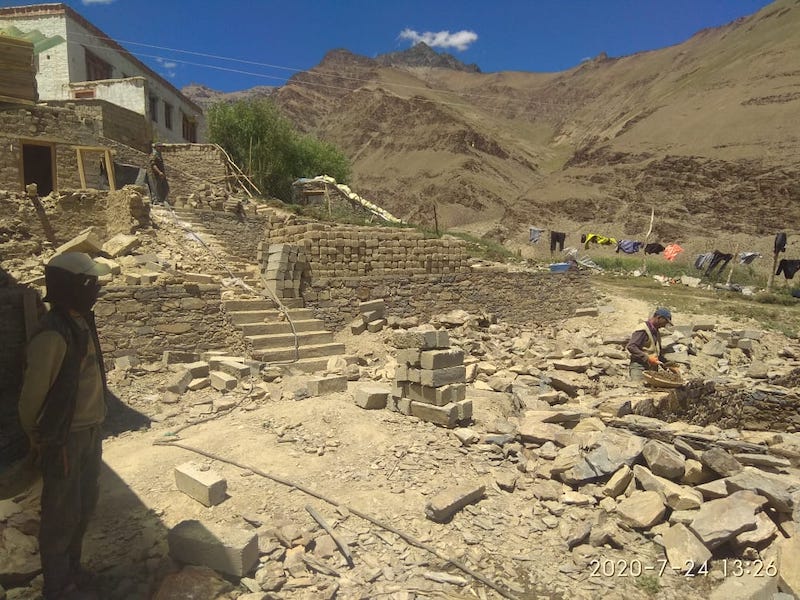
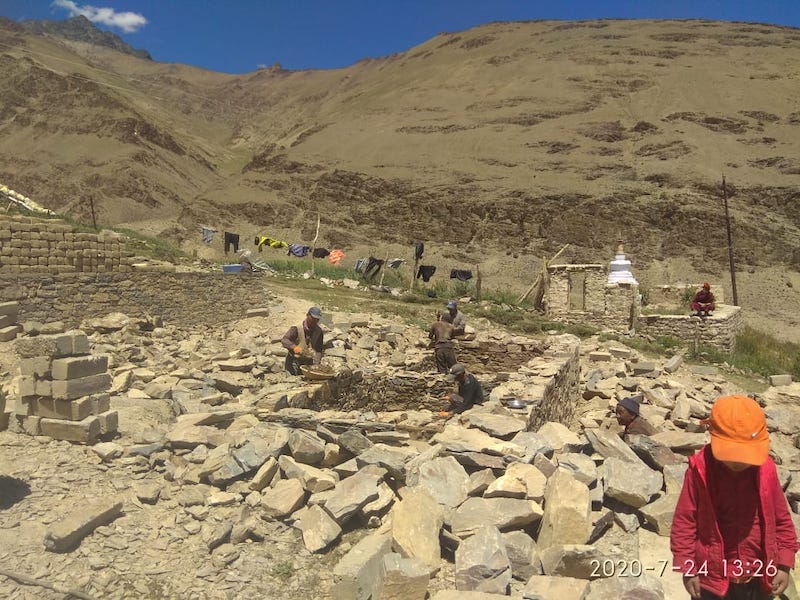
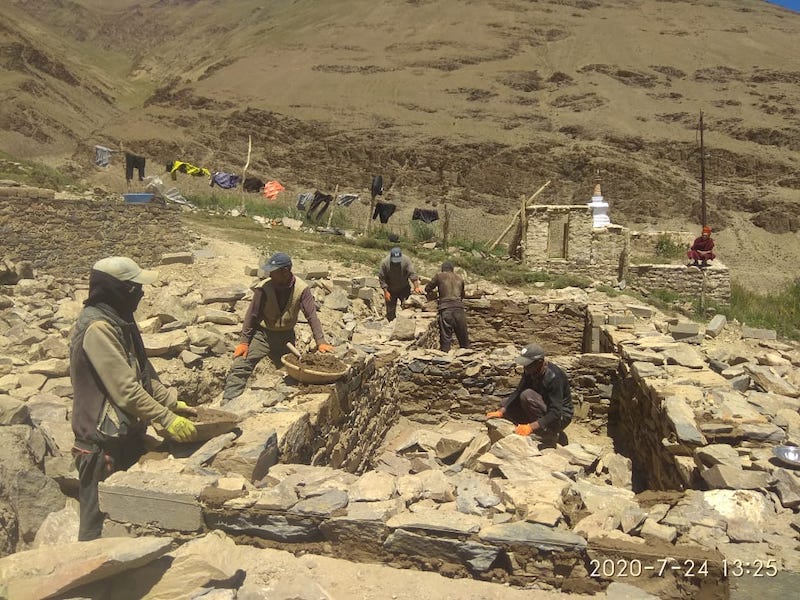
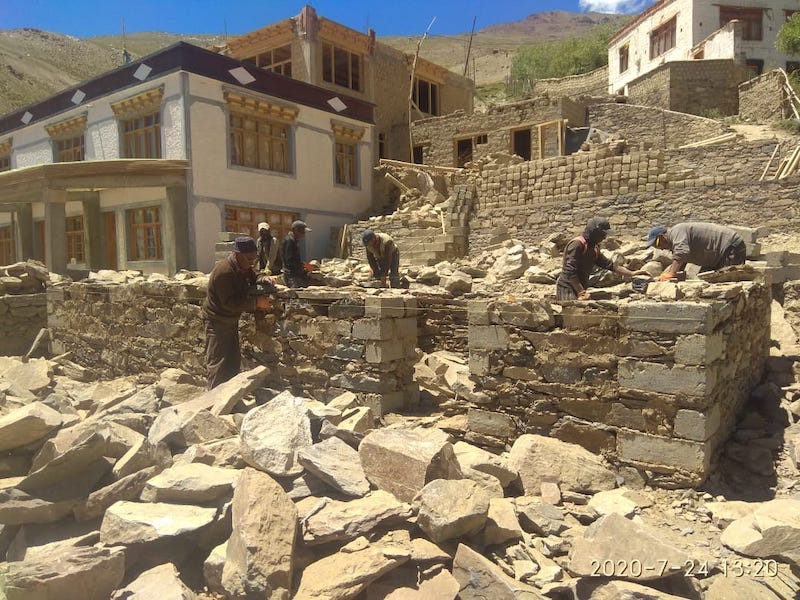
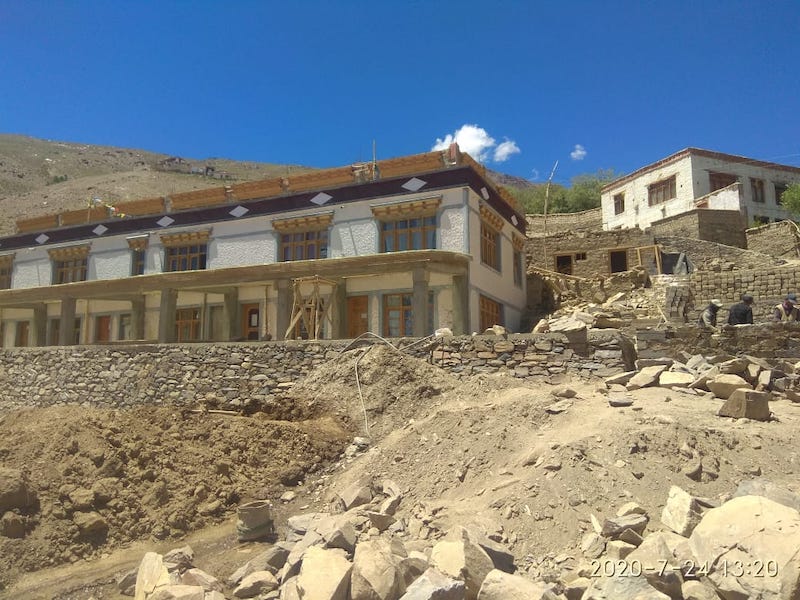
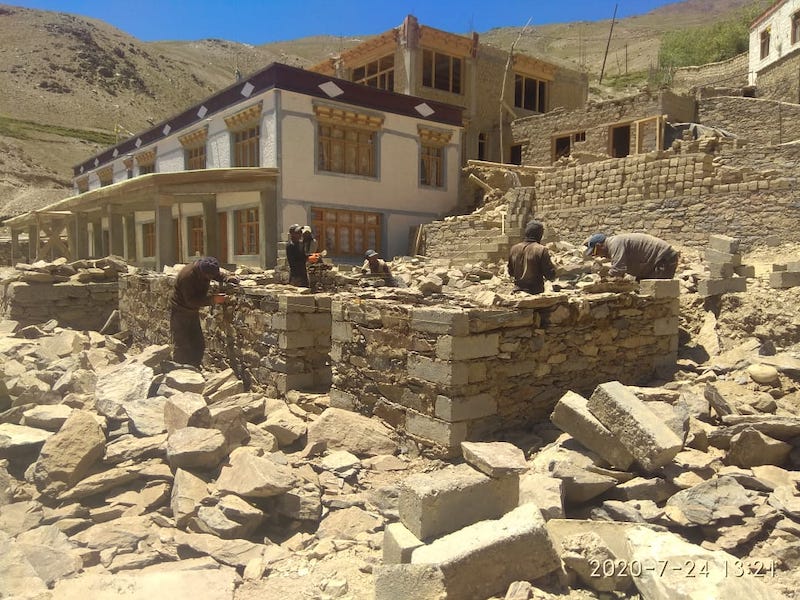
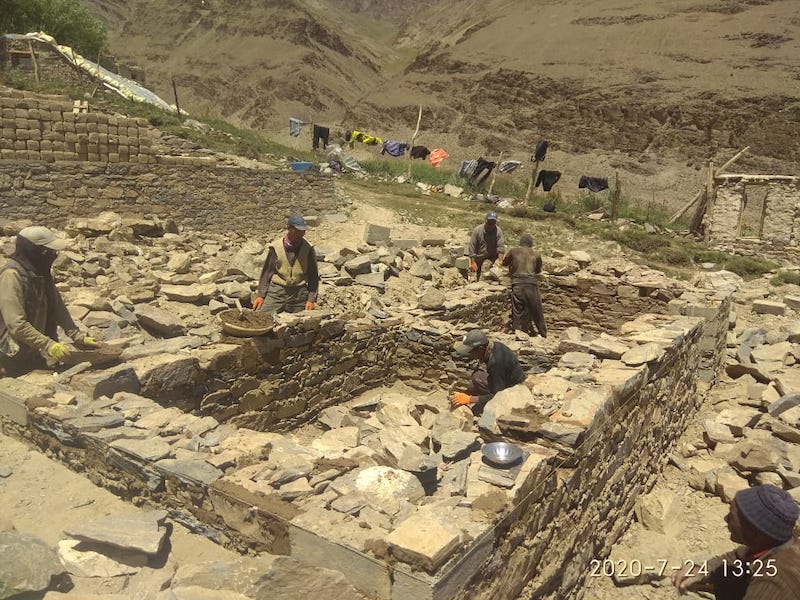
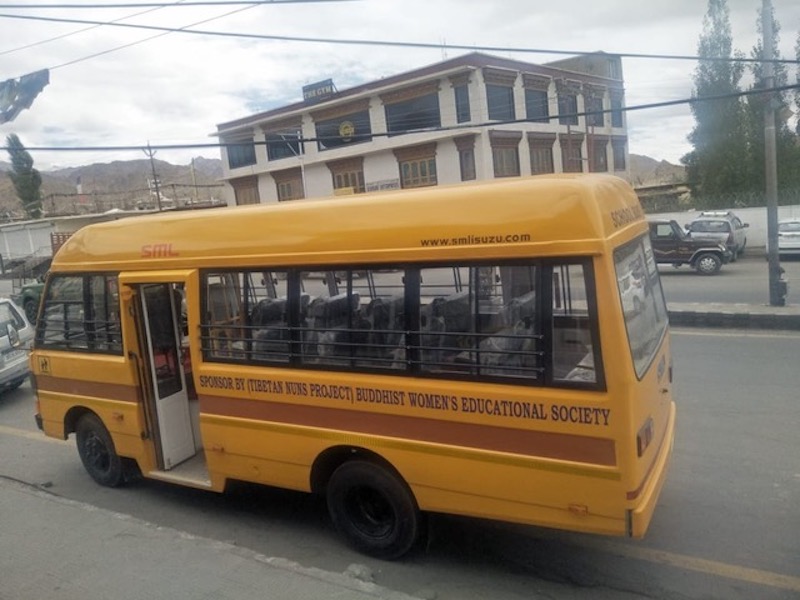
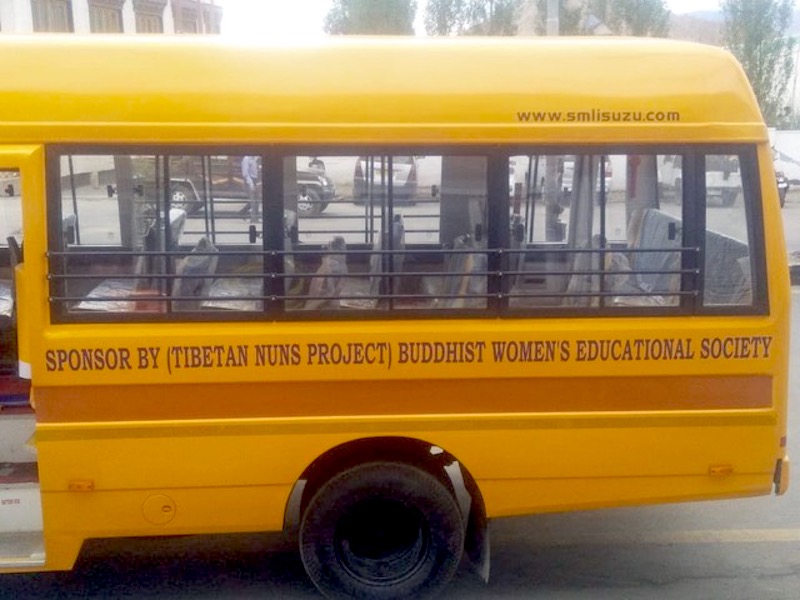
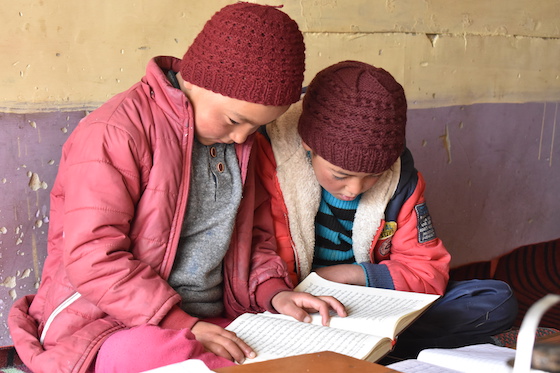





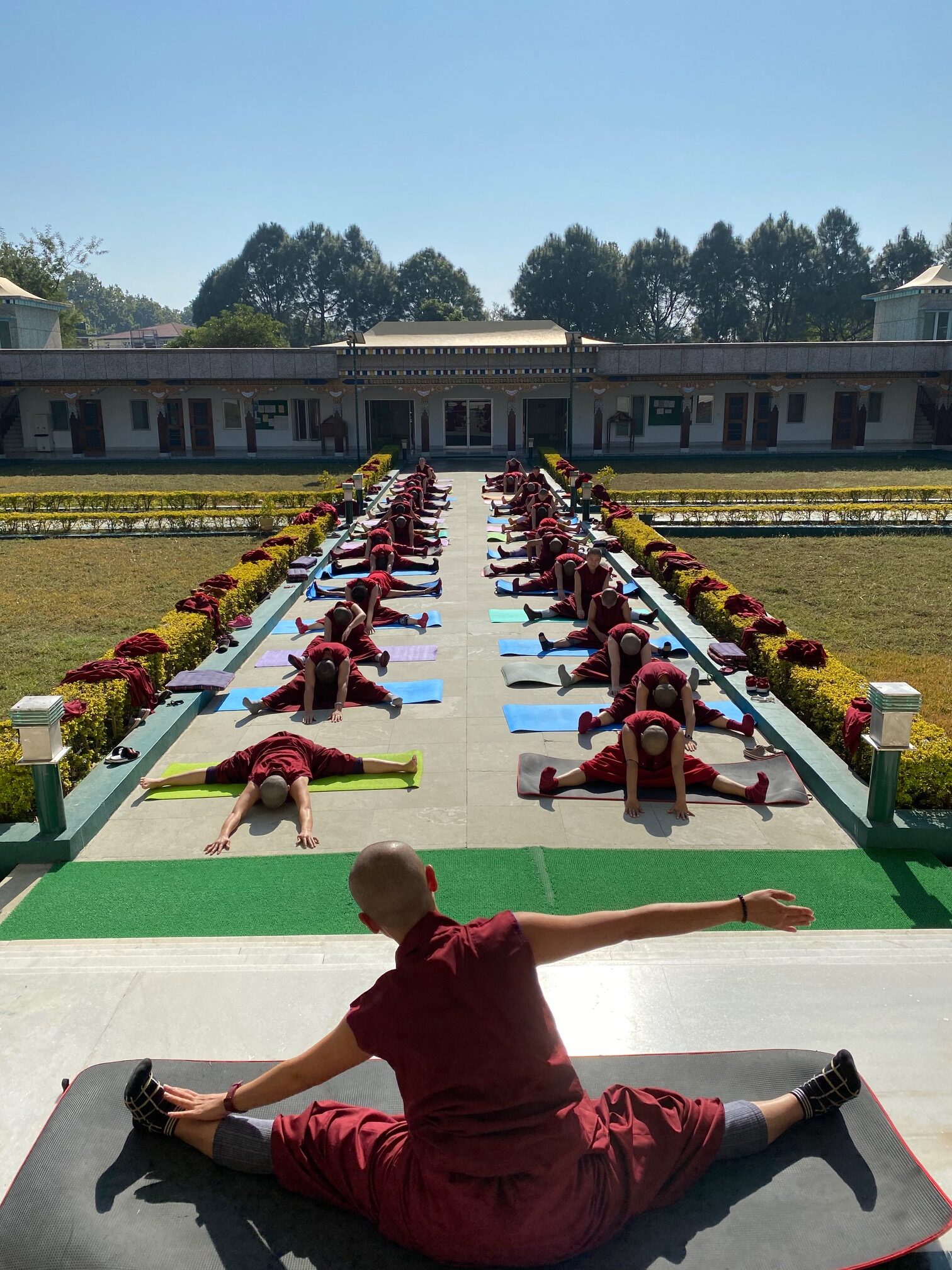





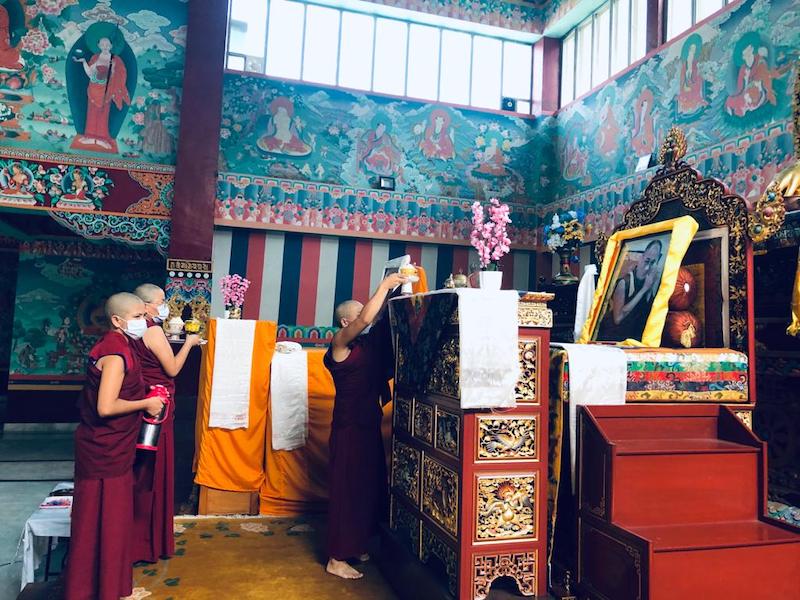
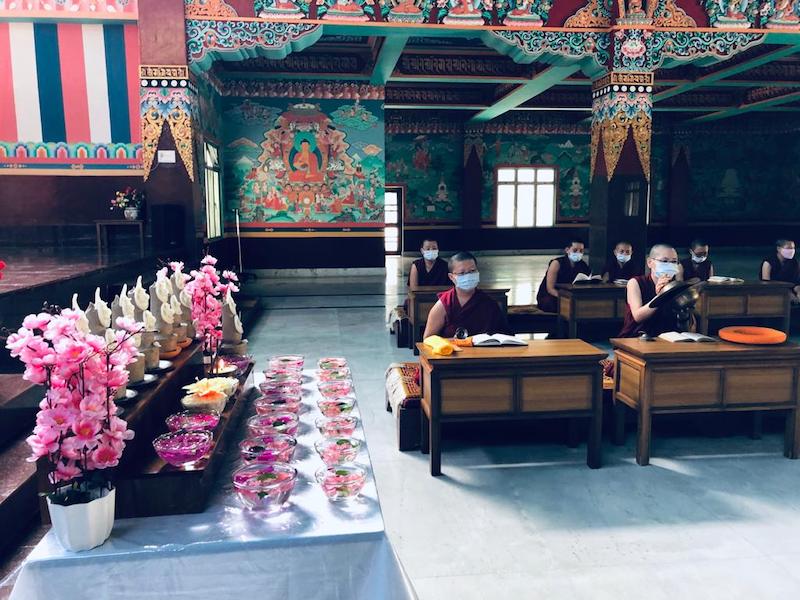
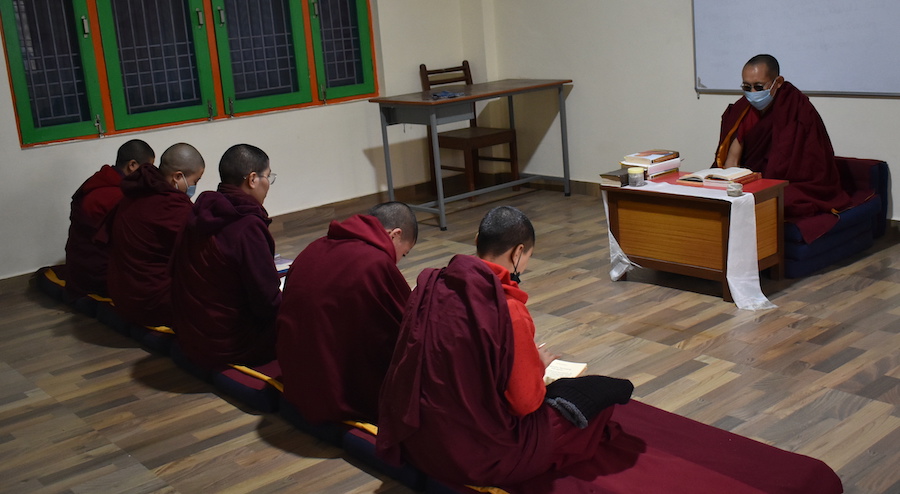
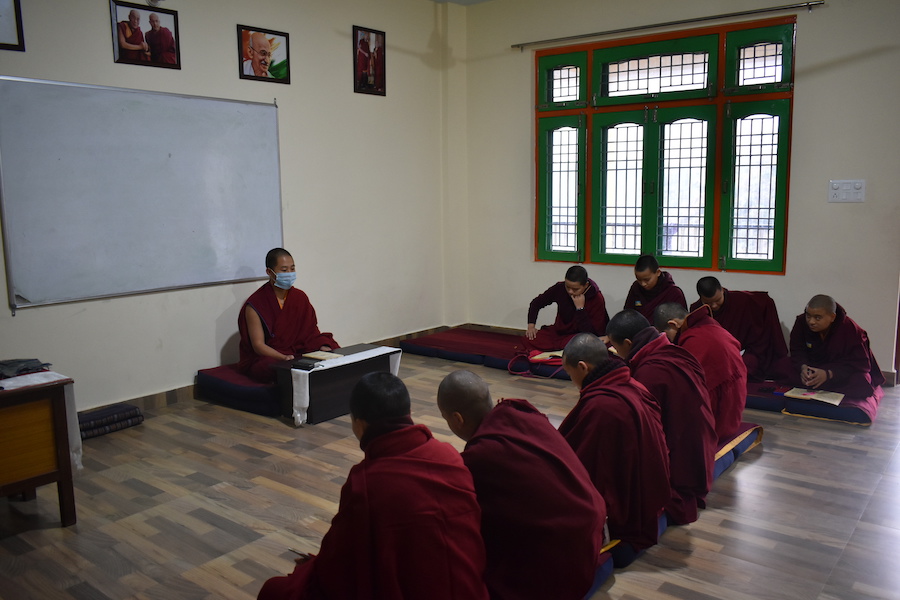








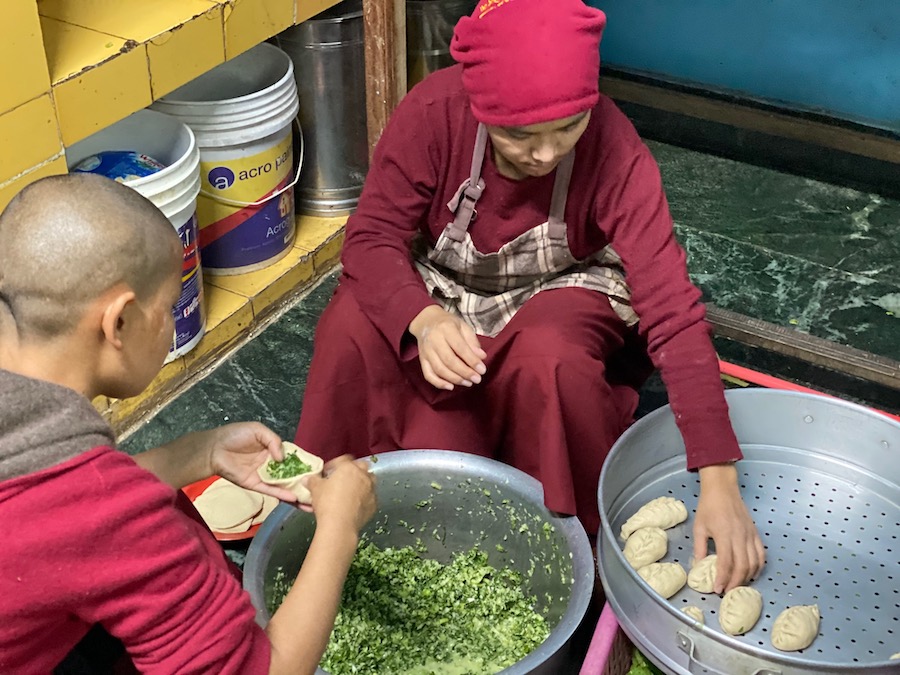
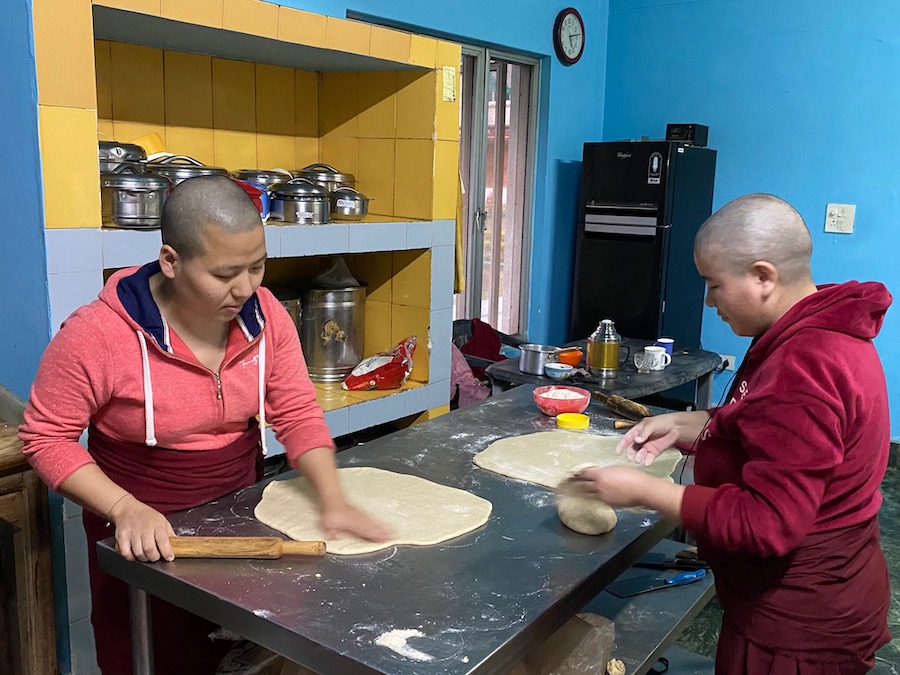






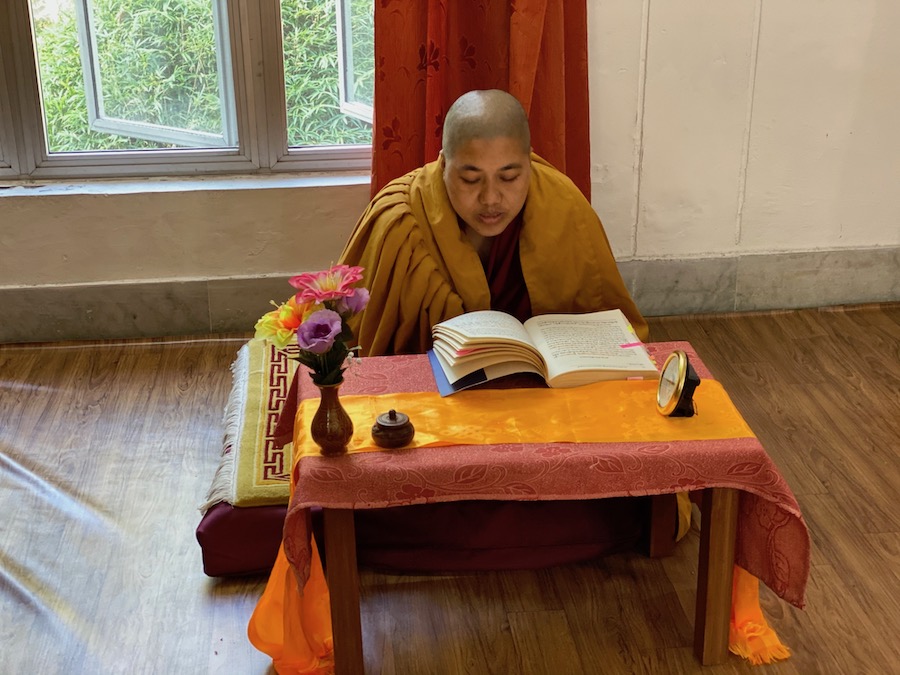

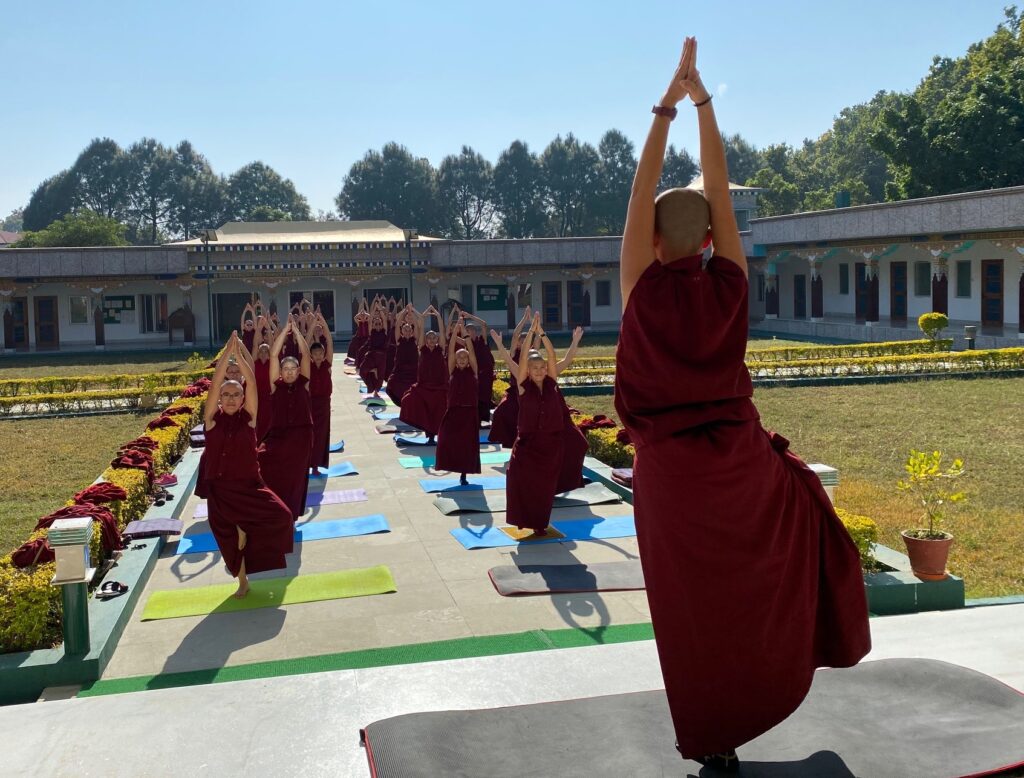 Even so, as part of measures to provide emotional health care, a Vipassana meditation master and a yoga expert were invited to give workshops. The College invited Associate Professor Ramesh Chandra Negi from the Central University of Tibetan Studies and an expert in
Even so, as part of measures to provide emotional health care, a Vipassana meditation master and a yoga expert were invited to give workshops. The College invited Associate Professor Ramesh Chandra Negi from the Central University of Tibetan Studies and an expert in 